The post Inside Meow Wolf’s Living, Breathing Metaverse first appeared on Joggingvideo.com.
]]>We entered through the gift shop. The convenience-store glare of Omega Mart greeted us like a 7-Eleven: bright rows of generic snack foods, souvenir knickknacks and a beverage case in the back. Standard Vegas vibe. But look closer. The display case near you advertises “Emergency Clams.” A pile of soup cans, attended to by an employee, is turning into an animated robot. The deli counter has a head made of meat and other items that look alien. Someone just opened the door to the refrigerator and disappeared into a glowing tunnel.
Maybe you’ve already been to, or heard of, Meow Wolf’s Omega Mart experience in Las Vegas. It’s buried inside a larger entertainment complex called AREA15 that’s also adding a 20-acre Universal Studios horror experience in the next few years. It’s my first visit there since I toured the complex in a hard hat in 2020. (I also got a virtual tour in 2021.) Now, I was entering Omega’s Mart’s deeper, cavernous spaces for real, getting lost in an impossible labyrinth of art rooms and artifacts and interactive mysteries spread across thousands of square feet. The deeper I wandered, the more I felt welcomed by magic.


Meow Wolf Omega Mart’s otherworldly convenience store location in Las Vegas. That refrigerator leads to many things.
Scott Stein/CNET
And in that tangled magic, connection points: I tap little kiosks with an access card that unlocks secrets. Occasionally, I find phones that ring, and I answer them. Or, I pick them up and call other people. I see employees who are actors, characters in this world, and they guide me, sometimes, when I ask. I see special hidden puzzles that others help me solve.
This infinite-seeming, interactive, communal art space felt like a physical version of the metaverse that VR and AR companies like Meta are still only dreaming of.
In 2016, a year defined by new VR headsets and strange new AR games like Pokemon Go, I was hypnotized by immersive theater. Not just shows like Punchdrunk‘s Sleep No More, but more intimate events like Third Rail Projects’ Then She Fell. I found these real-life experiences, often ones without any major tech, to be poetic models for the dream-immersive worlds I hoped VR and AR could someday become.
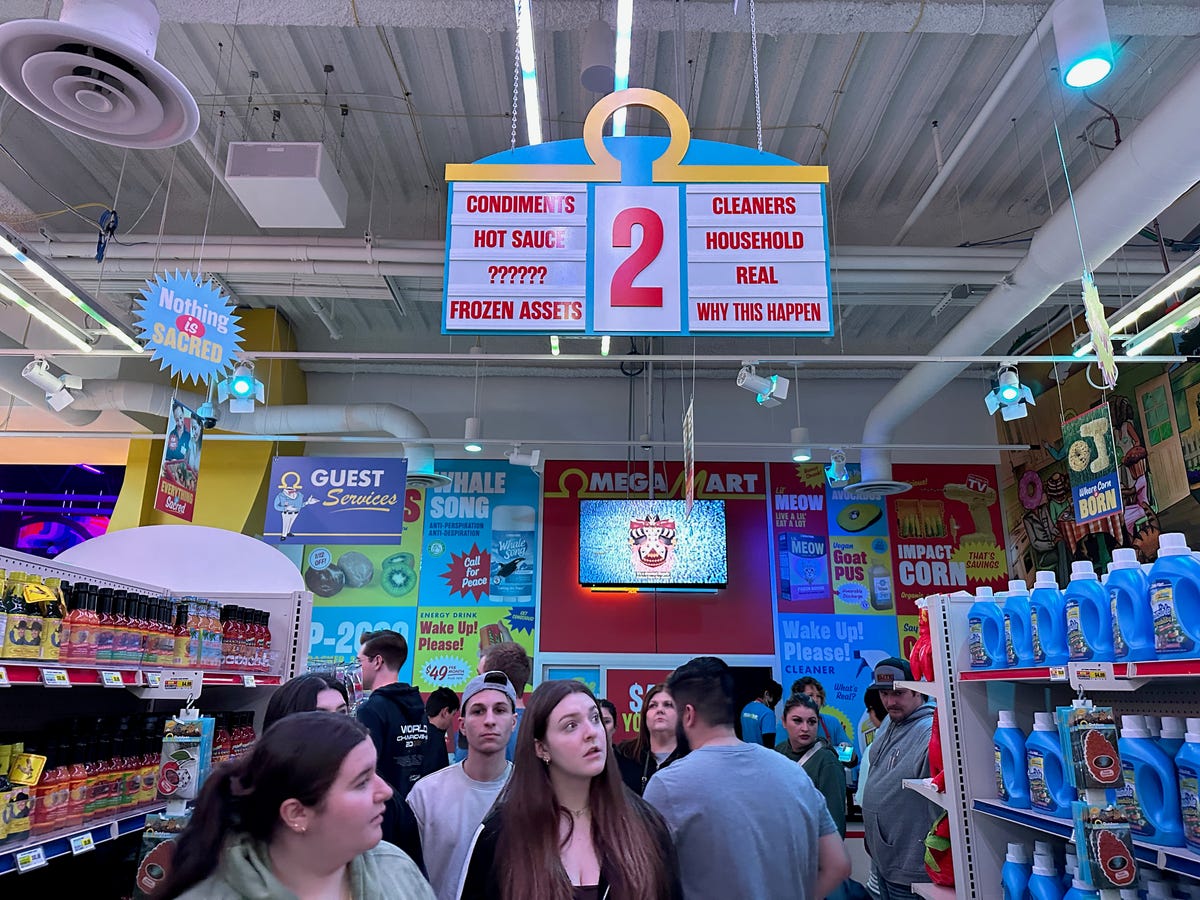

Look closer at those products. They’re not what they appear to be at Omega Mart in Las Vegas.
Scott Stein/CNET
I say this because my first time in a Meow Wolf space brought those same feelings back all over again. A week later, I double-dipped when I flew out to Denver to try Meow Wolf’s latest location, Convergence Station.
Meow Wolf is an art collective and entertainment company, an immersive-experience hybrid. After spending a few weeks reflecting on it all, what fascinates me about Meow Wolf isn’t actually the immersiveness, or the weirdness, or the scale, though those are all incredible. It’s how the army of local artists who make these individual worlds somehow come together to blend one experience from hundreds of individual efforts. It’s a mix of freedom and connection, and interaction. That’s what the metaverse is looking for — letting individual creators in while building a framework for everyone to play, and have it all work.
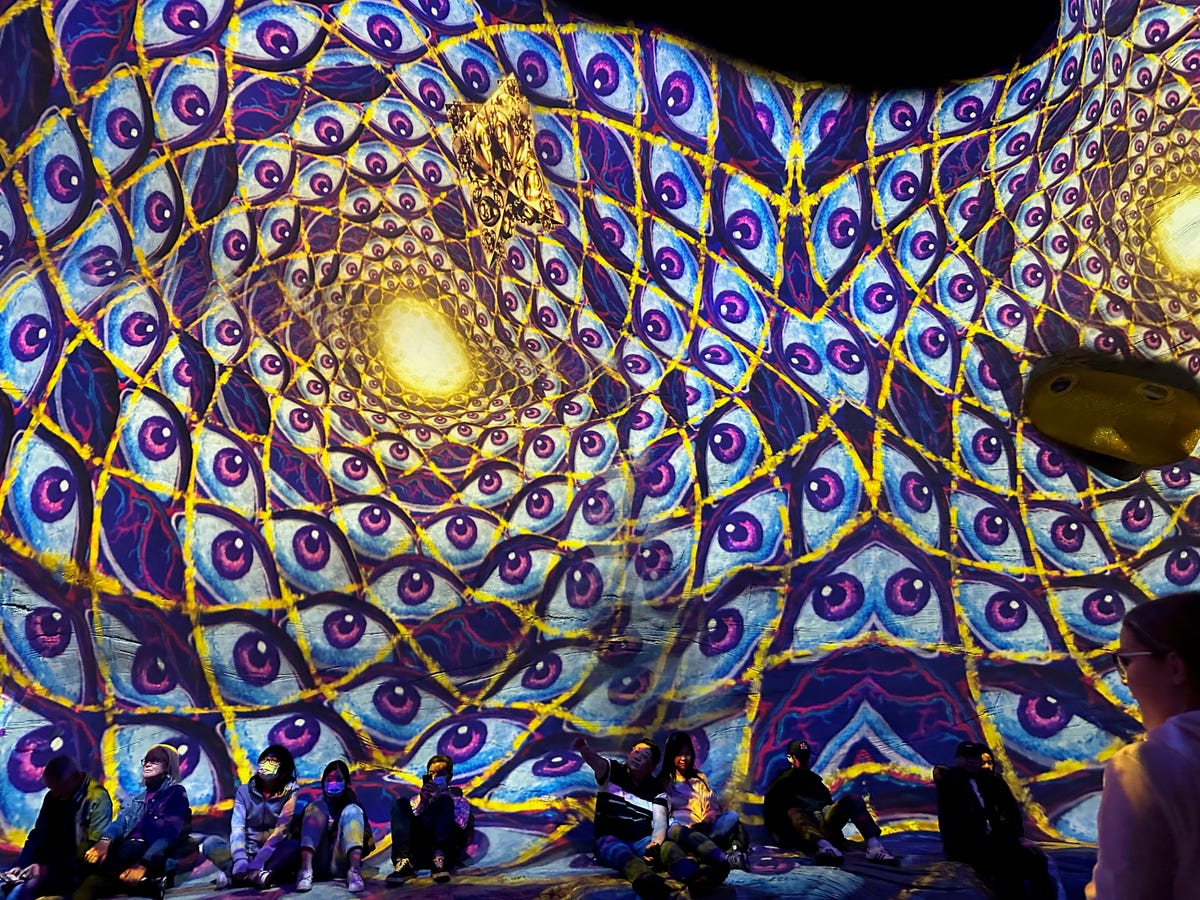

Massive projection mapping covers many walls in hypnotic animations. Energy and mood can shift from room to room in the Omega Mart.
Scott Stein/CNET
Multiverse of meltness
Meow Wolf’s various locations are all enormous immersive universes, a cross between phone-friendly “Instagram” museums and Disney World. It’s a Twilight Zone theme park, a bundle of mysteries in overstimulated, dripping-with-detail sparkle and glow. I got familiar echoes of many of my favorite experiences of the last decade. Like the ongoing Sleep No More in New York, I could explore artifacts in drawers and on bookshelves, browsing details and moving through the world like a ghost. The mischievous art reminded me of Banksy’s occasional installations. In Los Angeles, my favorite dusty museum of mysteries, The Museum of Jurassic Technology, gives me similar unanswered feelings of magic. The terminals I tap into and unlock a story through, and the attendants who help me in various rooms, are as approachable as… well, my last trip to Universal Studios, waving a wand through the Harry Potter universe.
The maximalist, multidimensional vibe even resembles recent films, including the garage-junk, sci-fi whimsy of Everything Everywhere All At Once. And a bunch of it, in spirit, reminded me of the wide-open whimsy that Magic Leap was going for leading up to its first headset launch.
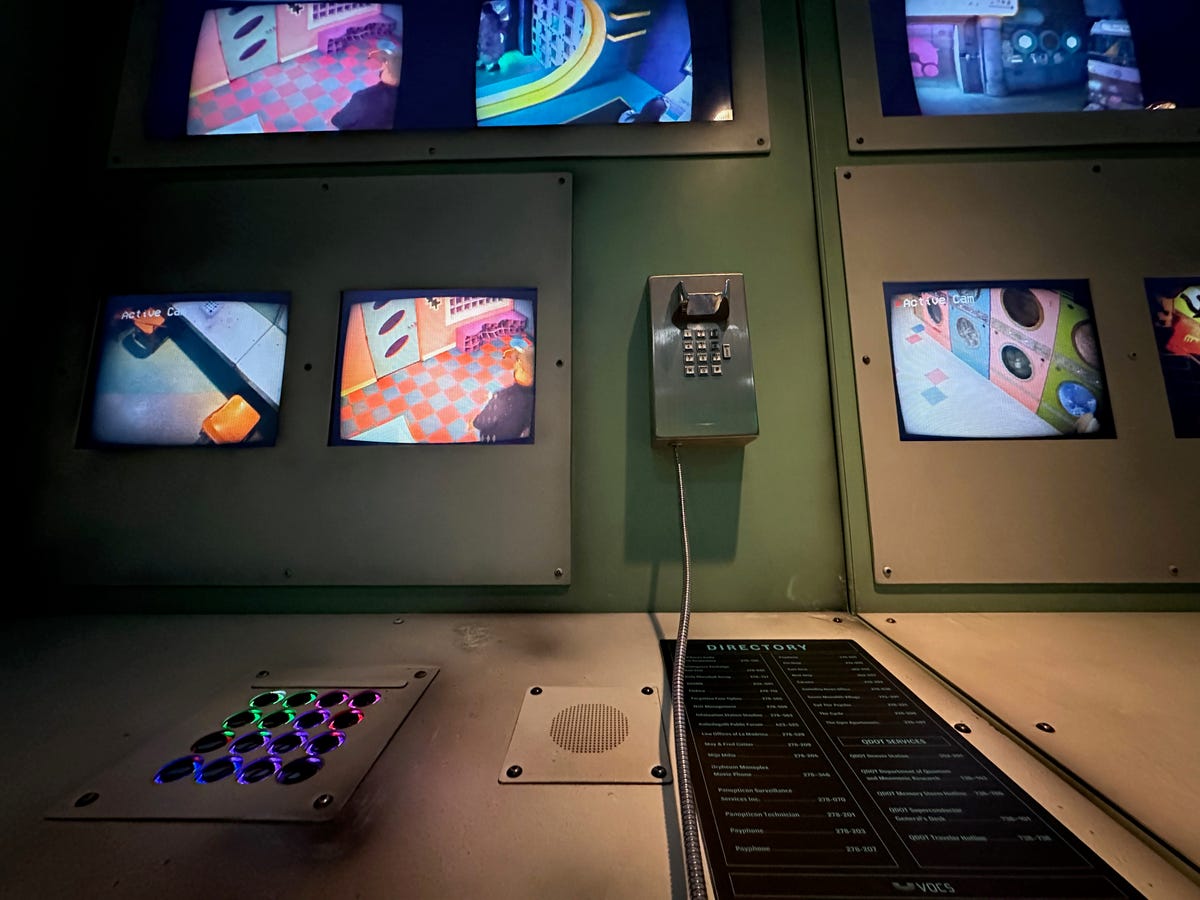

I found this magic phone terminal in Denver. It calls between worlds in the Convergence Station.
Scott Stein/CNET
Unlike the Las Vegas Omega Mart, the Denver Convergence Station is set up as a transit hub to a series of alternate universes. Still, there are parallels to the Las Vegas version. Sometimes I find shared artifacts like a dusty item from Omega Mart’s store. I wander into a bank of monitors and make phone calls to places throughout the installation, but I learn later that Convergence Station and Omega Mart have phones that can call each other. Both places have RFID-based cards (equipped with radio frequency identification technology) to tap into terminals, as well as assistants/actors/performers/docents who move through, adding to the story and helping you find your way if you want. The ticket prices, at about $45 to $59 depending on the location, time and date, are not far off from a museum or theme-park admission, and less than most theater tickets. The RFID cards cost a few dollars more, which, according to Meow Wolf, is a way to keep the card-tapping terminals from getting too crowded.
This template is going to expand, with Meow Wolf’s next location in Dallas. All of these worlds will intertwine, and at some point, perhaps, VR and AR could factor in. Expanding beyond these fixed locations is something Meow Wolf has been exploring. The more there are, the more some type of shared-experience space seems to be blooming. Meow Wolf’s hallucinatory merchandise includes lots of lore and collectible in-world souvenirs, almost like Disney’s Star Wars: Galaxy’s Edge shops. I bought mythology books and oracle cards (I couldn’t help myself).
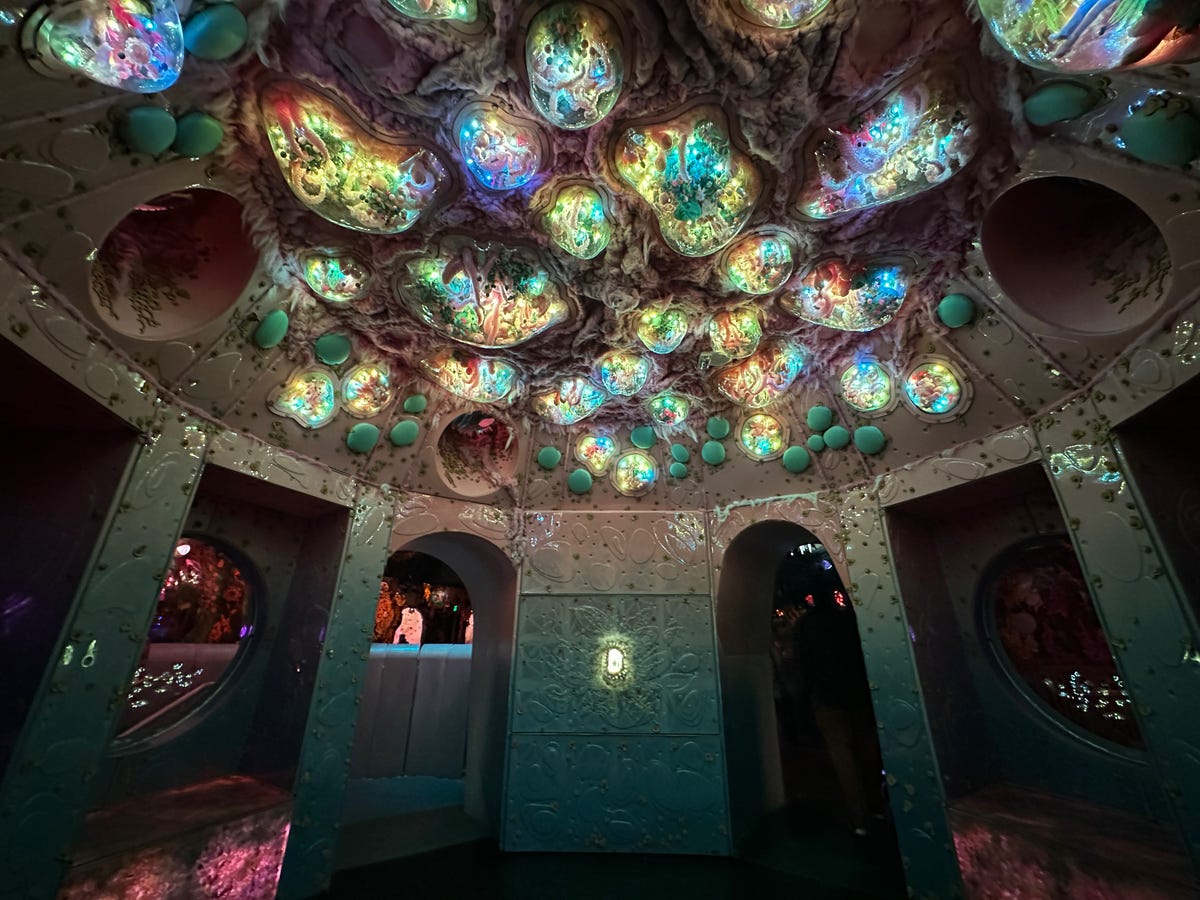

A beautiful and eerie ceiling in one of Convergence Station’s worlds, Numina.
Scott Stein/CNET
An umbrella of interconnection
After 90 minutes of Meow Wolf immersion, I came away impressed, not necessarily because of the over-the-top design aspects (which are amazing), but because of how it all works together. People wandering through, some casually taking selfies, some seeking to be alone and get lost, some with families touching everything on scavenger-hunt quests. Deep-divers and surface-skimmers. Unlike a Disney experience where I see hundreds of people pointing their phones at something, my wanderings still felt private, personal, uncrowded. And unlike immersive theater or a VR experience where everything happens at a contained level or where photos can’t be taken, here I could take little souvenir snaps.
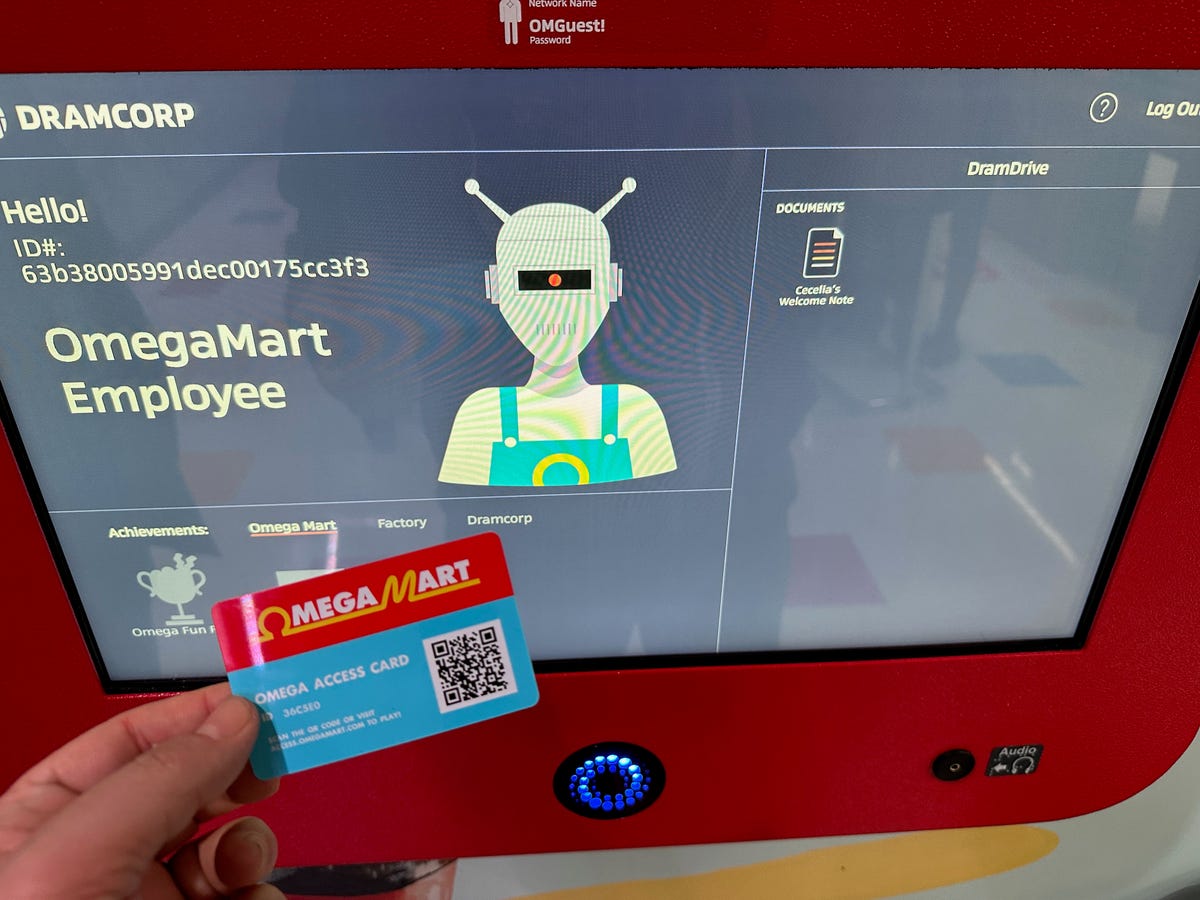

Tapping into one of Omega Mart’s terminals. Little RFID cards serve as souvenirs and a sort of interactive game layer.
Scott Stein/CNET
It made me think about the promises tech has made about the metaverse. We’ve been told (and I’ve hoped) that an interconnected network of social experiences awaits us, with creative playgrounds at our fingertips. That already exists: Roblox, Fortnite, Minecraft, VR apps like VRChat. But these don’t feel open to everyone, and it’s not easy to blend the promise of free creativity into social comfort. A year ago, I wrote about how social metaverse platforms were trying to figure out our comfort zones. Today, it’s still not solved. Having more real-life “docents,” or personal guides, in social apps would help, which Meow Wolf has. Having more of a sense of discovery that links individually created worlds together would also be useful, which Meow Wolf also has (with artists that have been pre-commissioned for that purpose). I dream of having some way to record my movement between worlds, keeping a consistent log that moves with me. Meow Wolf’s little RFID cards are sort of like that, too.
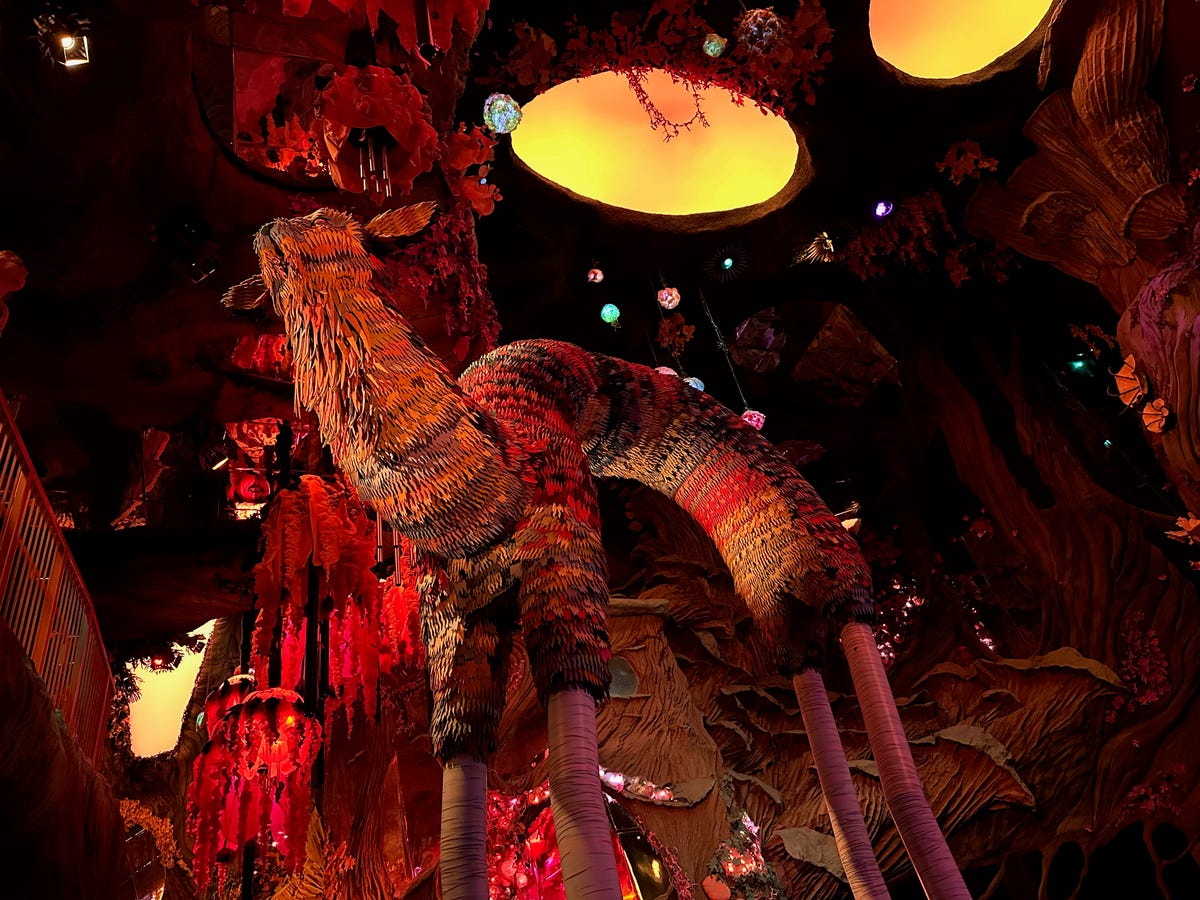

The art all around every corner feels kaleidoscopic, unique and yet intertwined in the Convergence Station.
Scott Stein/CNET
Models for collaboration?
One unique part of Meow Wolf’s installations is that they’re made with a mix of hundreds of local and in-house artists. Projects are designed collaboratively, and individual artists are encouraged to make the spaces their own while also connecting them to everything else. Actors have the same opportunity: There are set roles, but individuals create their own characters to fit the space.
It doesn’t sound like it’ll work, but it does. And maybe it works well because every Meow Wolf experience seems to have chaotic energy, filled with so many stimuli that I’m ready for anything to happen at any moment.
VR worlds like Meta’s Horizon Worlds are desperately seeking creators to make interesting things that people will want to visit. Such a blank slate is promising in theory, but it tends to result in a random assortment of virtual places that are hard to both discover and promote. Also, when I visit them, I don’t know what I’m supposed to be doing. I feel awkward, wander around a bit and then leave.
Meow Wolf’s conceptually unified structure helps you navigate the artistic landscape in a physical space, giving you the chance to appreciate individually curated art pieces. The “ID card” is a common interface that works across dozens of rooms, and each creative bit feels like it belongs under the same umbrella.
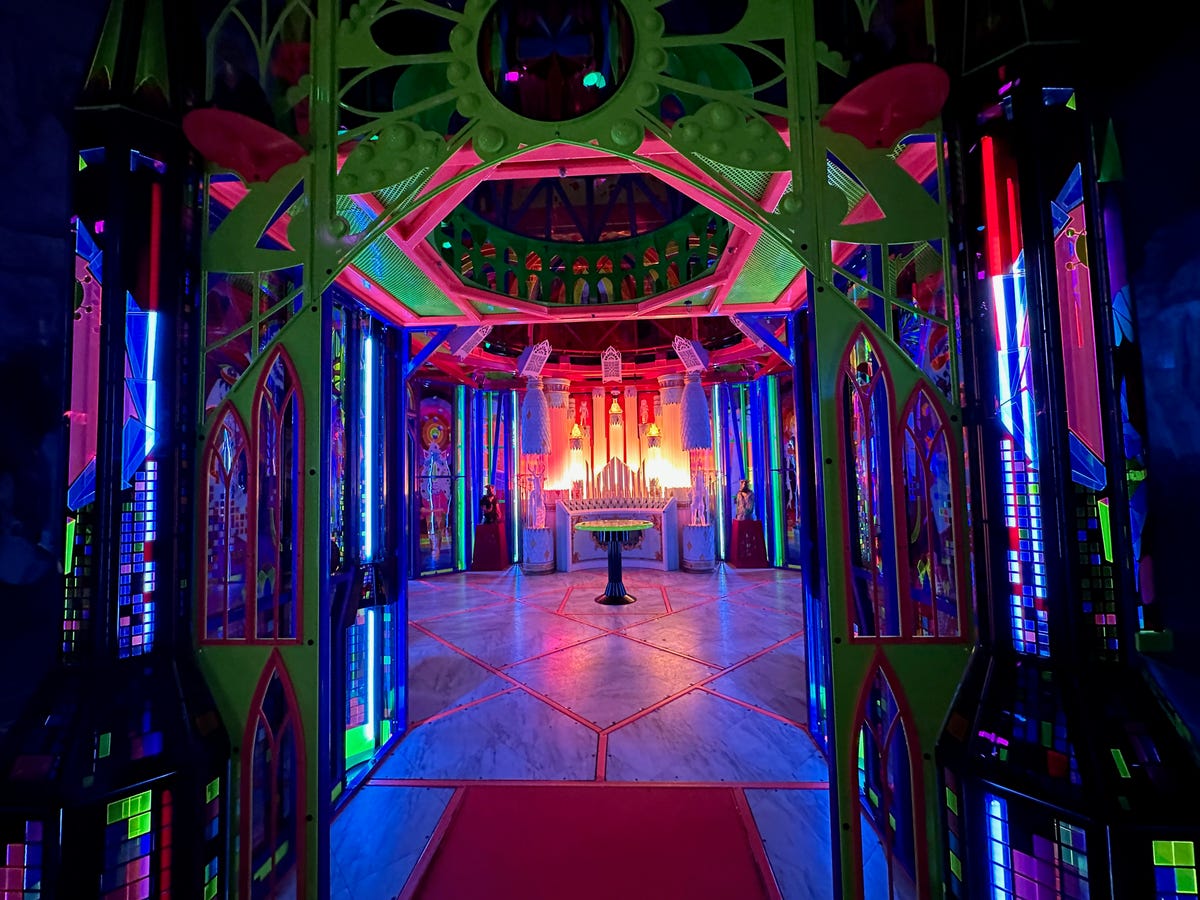

A glowing cathedral at Convergence Station holds secrets. Attendants pointed me to clues.
Scott Stein/CNET
A dream model for a future dream space
While I don’t think any virtual experience in an app has really brought “the metaverse” to blazing life, walking through Meow Wolf’s worlds gives me that dream feeling, even if it’s not technically a metaverse at all. Or maybe it is.
If Meow Wolf starts to expand into new territories — maybe smaller, maybe virtual — would the physical spaces overlap, dovetail, interconnect? AR companies are already trying to do this with locations in the real world, to mixed success.
Instead of being virtual-first, Meow Wolf is starting in the real world, with random bits of art, light and strange magic. It’s probably more viscerally transformative than most VR I’ve tried lately. And it’s making me wonder how this interactive experience could inspire a new generation of virtual experiences to come.
The post Inside Meow Wolf’s Living, Breathing Metaverse first appeared on Joggingvideo.com.
]]>The post iPad 10th Gen Review: Better Design, Worse Price first appeared on Joggingvideo.com.
]]>
I wish life could be simple. Unfortunately, that’s not always the case. When it comes to Apple’s iPad lineup, which used to have just one model called the “iPad” back in the day, picking which one to buy has become a strangely entangled process.
Somewhere between every single model Apple offers is the perfect iPad, but it doesn’t currently exist in one single product.
That’s why I, as your reviewer guide, am having such a hard time with the review for Apple’s brand-new, redesigned 10th-gen iPad. Starting at $449 (£499, AU$749), it should be the iPad for everyone. But from what I’ve seen so far… it’s not. (This is a review in progress. As I use it more, I’ll weigh in with my final opinion.)
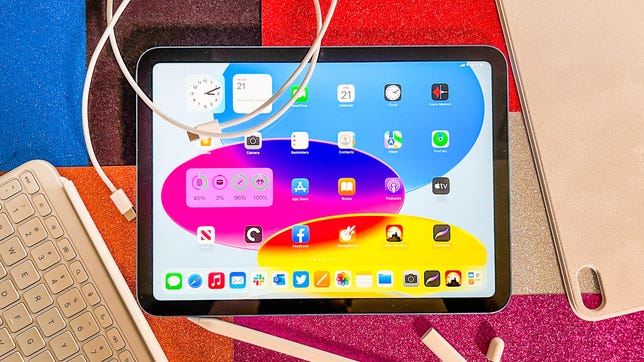
iPad (10th gen, 2022)
$449 at Amazon
Get Price Alerts
You’re receiving price alerts for iPad (10th gen, 2022)
Like
- Larger screen
- USB-C
- Faster A14 processor
- Front-facing camera’s in the right place
Don’t Like
- More expensive
- New design means fewer case options
- The 64GB entry-level storage isn’t enough
Maybe Apple already knows this, because the iPad lineup has six variants: 2022’s base model, last year’s ninth-gen iPad, the iPad Mini, the step-up iPad Air and the luxury iPad Pro, which comes in two sizes.
So which is the best one, you ask. “Stop talking about confusion, Scott, and help me.” This newly redesigned iPad nearly has it all: It has USB-C, finally! It has a bigger screen and better speakers, like the iPad Air. It’s the first iPad to move its camera to the horizontal edge for better FaceTime and Zoom calls.
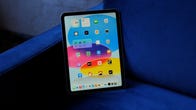

Now playing:
Watch this:
iPad 10th Gen and iPad Pro: Which iPad Should You Buy…
8:18
Then there are the downsides. If you want to use an Apple Pencil with this iPad, you have to use the first-gen one, which means using a weird USB-C dongle. It doesn’t work with iPad case accessories made for any other model, meaning you’ll have to buy new accessories. And the price has gone up. It’s $449 for the version with only 64GB of storage, but you’ll likely want the step-up model with more storage — 256GB for $599. And with any sort of case or AppleCare, you’re probably looking at well over $700. I haven’t even factored in a Pencil or Apple’s new $250 Magic Keyboard Folio Case.
In this economy, a better bet might be the ninth-gen iPad from 2021, which starts at $329, steps up to $479 for the higher storage tier and frequently can be found on sale. Apple took a similar approach to its latest MacBook Air: Increasing the price while adding features, but keeping the older model in the lineup.
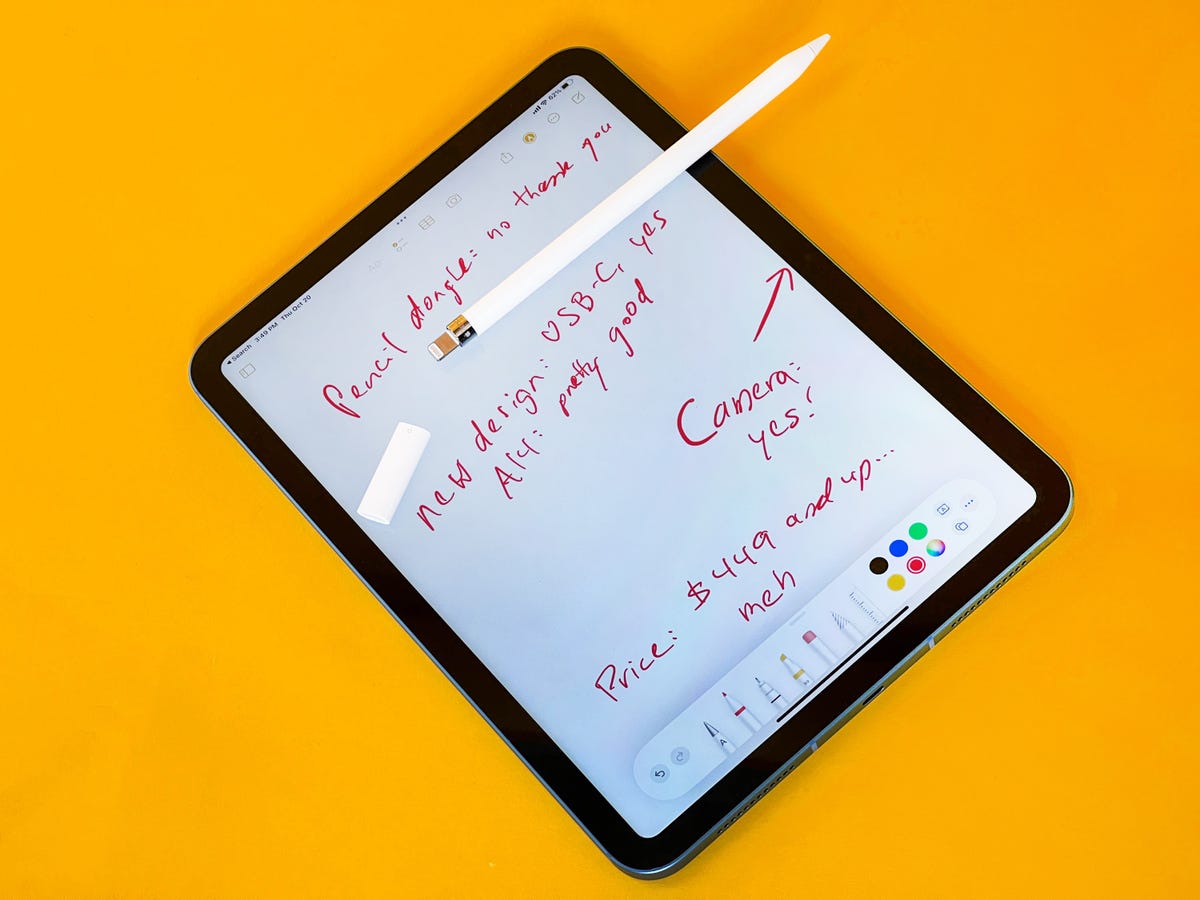

Scott Stein/CNET
And that’s a shame because this iPad, with its larger display, camera improvement and better processor, is the model I’d prefer — minus its weird Pencil accessory situation.
I don’t use the Apple Pencil much, despite how nice it is to draw with, so I might be OK with having to use the first-gen Pencil. But many other people won’t be. And it’s baffling, frankly, why Apple decided to not make this iPad compatible with the more useful Pencil 2 despite all of its other improvements. (You can even get 5G through the modem-enabled version.)
I’m going to unplug my Pencil 1 from its dongle now and rest it somewhere where it won’t roll off the table while I continue this iPad review.
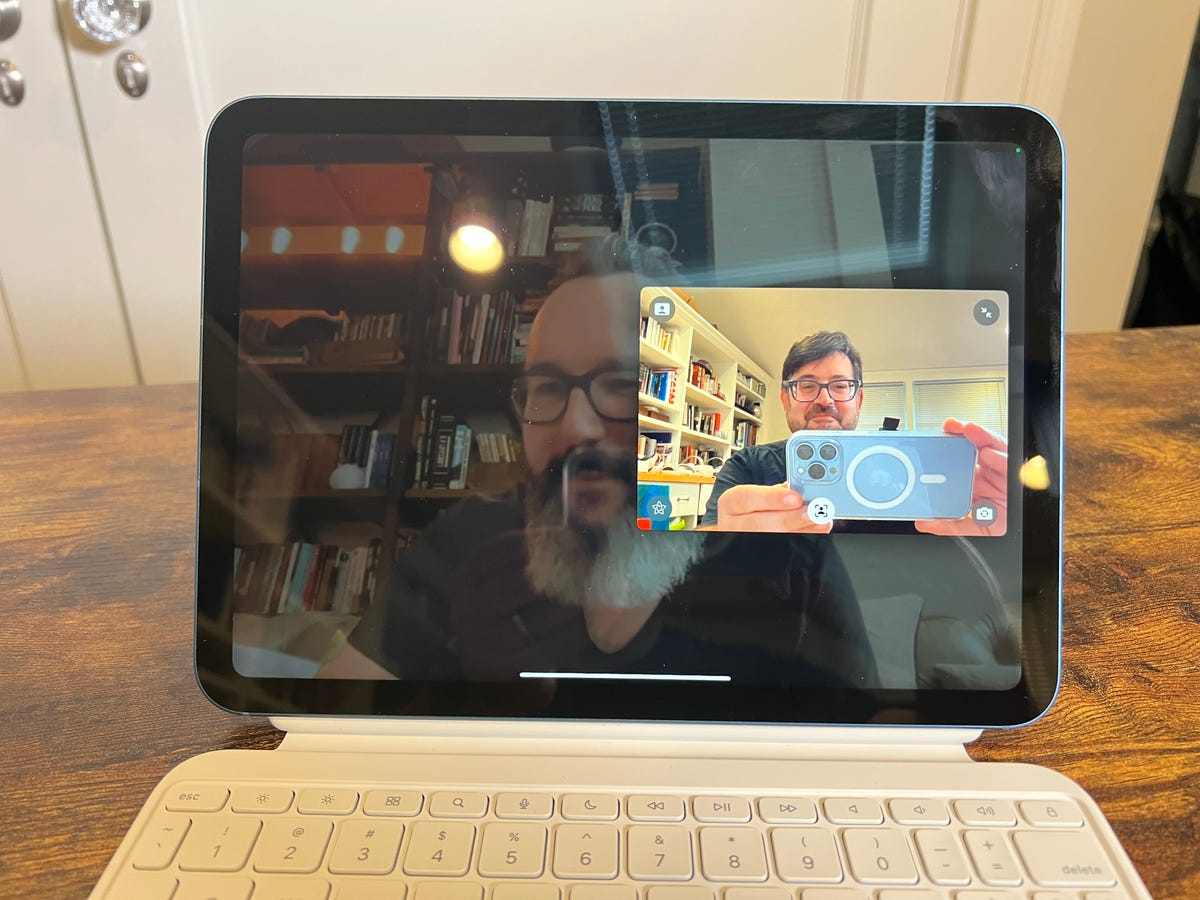

Me, celebrating that the camera finally looks great on a call with CNET’s Dan Ackerman.
Scott Stein/CNET
Camera: Yes, finally, it’s perfect
The one big thing I wanted from the iPad arrived, like a magic wish granted: The weirdly placed front camera on the iPad is now on the landscape edge. This is great. Why is this great? Because I work on iPads in landscape mode, in cases and stands and keyboard docks. When I Zoom or FaceTime on other iPads, my face looks weirdly off-angle with my eyes looking elsewhere. That’s fixed now. Combined with the auto-zooming Center Stage tech, this iPad’s video chat camera is absolutely perfect.
This, alone, makes me want to use this iPad more than any other. But, alas, Apple’s only moved the camera’s position for this iPad. No other model, not even the new iPad Pros, have it. Why? I have no idea. This is clearly the future of camera placement, so you’re one step ahead if you buy this model.
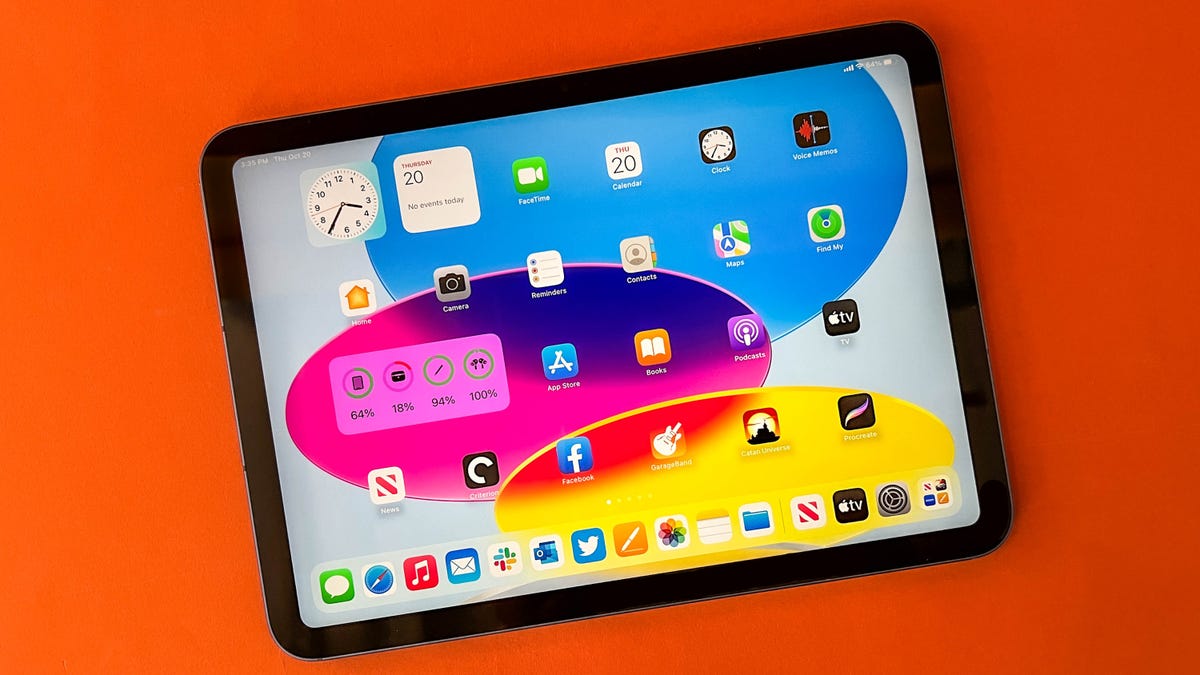

This iPad adopts the look of the iPad Air and iPad Pro. It’s mostly great.
Scott Stein/CNET
Design: Mostly better, but not always
This iPad has adopted the design style of all other iPads at last, with USB-C charging replacing Lightning and a flat-edged case with a larger, curved-corner 10.9-inch display. This iPad has better speakers than the ninth-gen model, and the display feels notably bigger. The display lacks the anti-reflective coating and extra color gamut of the iPad Air.
It doesn’t have the smooth-scrolling 120Hz ProMotion on the iPad Pro models, but it’s more than good enough for basically anything. Often, I had a hard time telling the difference between the iPad Air and this iPad in everyday use.
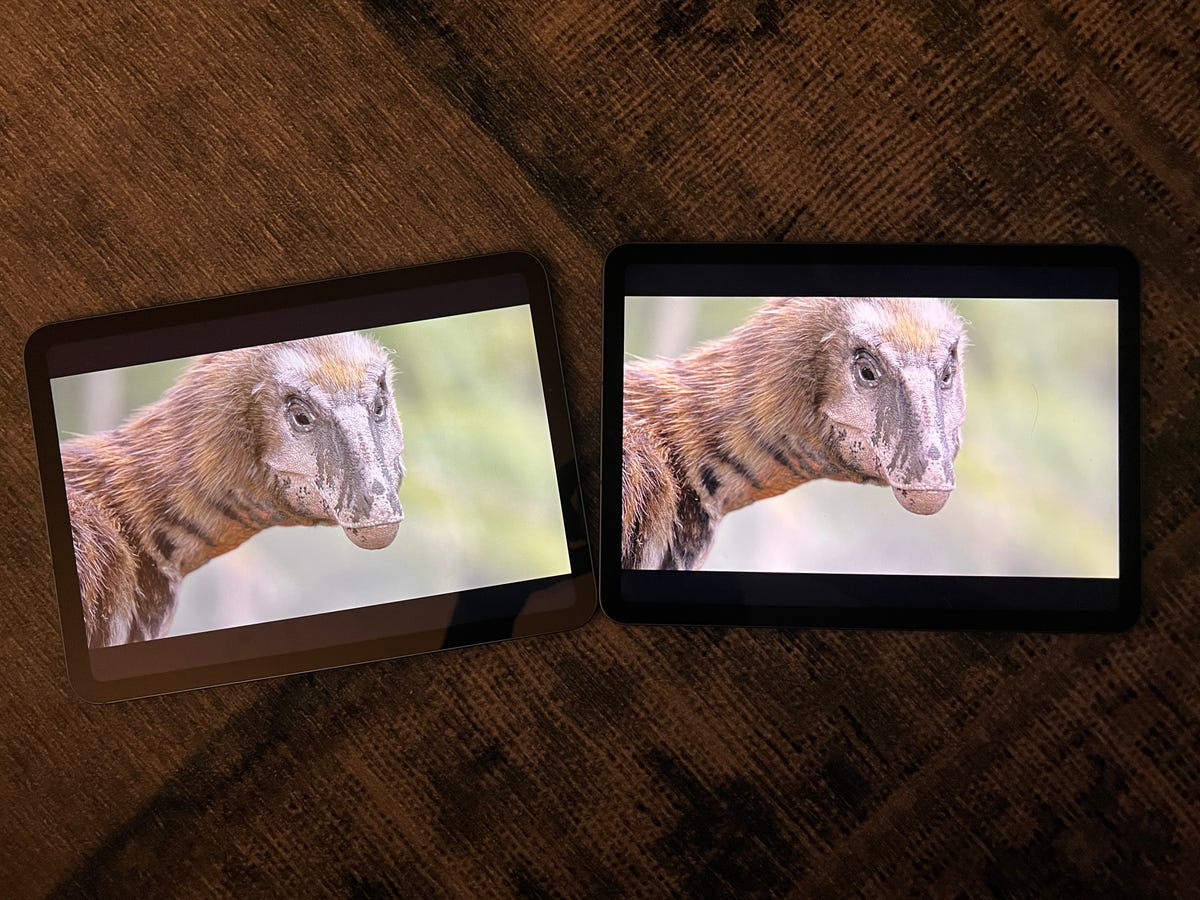

The 10th-gen iPad (left) next to the iPad Air (right), watching Prehistoric Planet. My family had a hard time telling the difference.
Scott Stein/CNET
This iPad is, effectively, the 2020 iPad Air minus a few features. The Air had the same A14 processor, but also supported the Pencil 2. It also had a rear Smart Connector that supported the Magic Keyboard case.
There’s no home button anymore, with Touch ID moving to the small side-placed power button, which the iPad Mini and iPad Air also have. I love this and wish the iPhones had it, too. There’s no Face ID camera, which is fine, because I wear a mask a lot anyway and Touch ID has been more convenient lately.
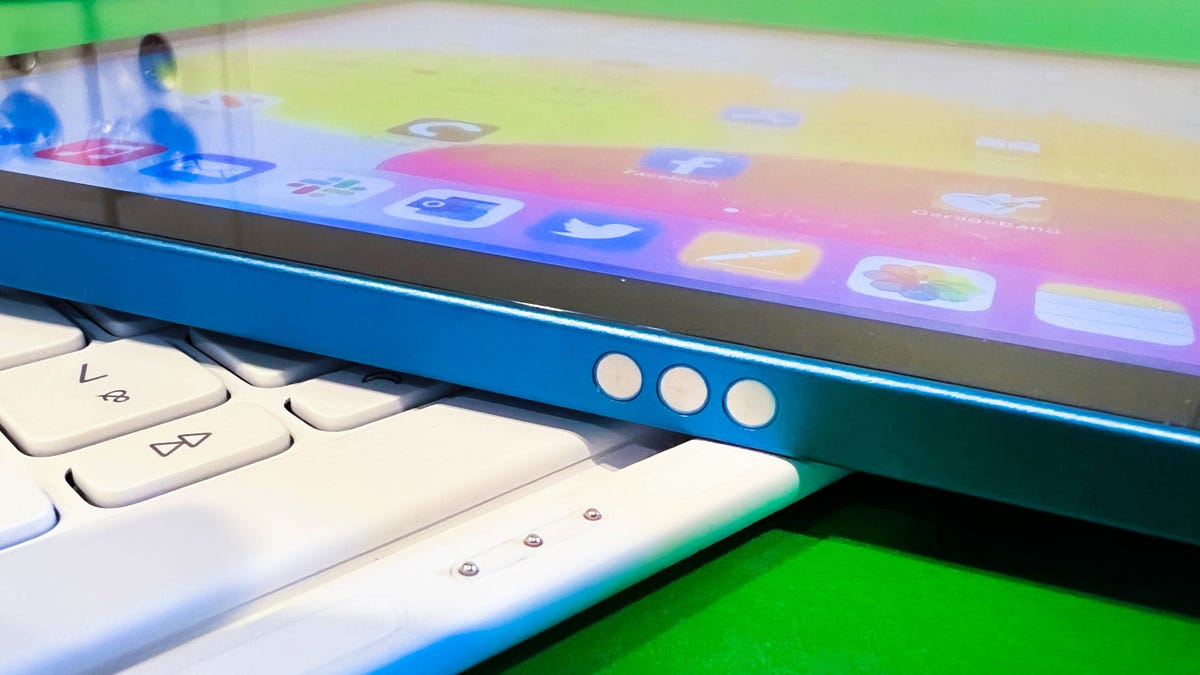

The new location of the Smart Connector: on the side.
Scott Stein/CNET
The downside to the design is it’s a bit thicker than the current 11-inch iPad Pro and iPad Air, meaning this won’t work with any of those cases. This means shopping for all-new accessories. Apple also created a differently placed Smart Connector on the side edge, which works with Apple’s iPad-made Keyboard Folio Case. More on that below.
I asked my 14-year-old son, who uses an iPad all the time, what he thought of it. He said, “I don’t care, it looks the same.”
But there’s one thing about this iPad’s design I can’t stand.
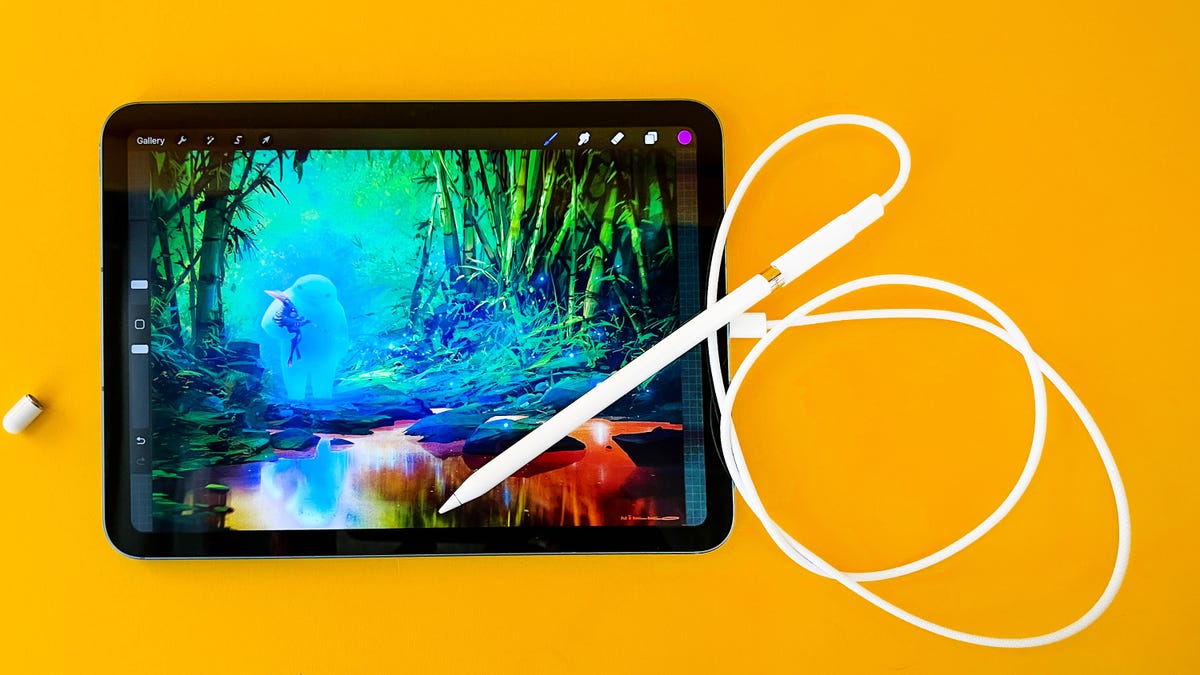

This is how you attach the Pencil now.
Scott Stein/CNET
Pencil: Really?
The best thing I can say about this iPad is it works with the Apple Pencil, but I think that’s almost on a technicality. Apple skipped support for the magnetically charging snap-on Pencil 2 with this model, so you’ll need to use the Pencil 1 — which rolls a lot, has an easy-to-lose end cap, doesn’t have extra side-tap controls and charges via Lightning.
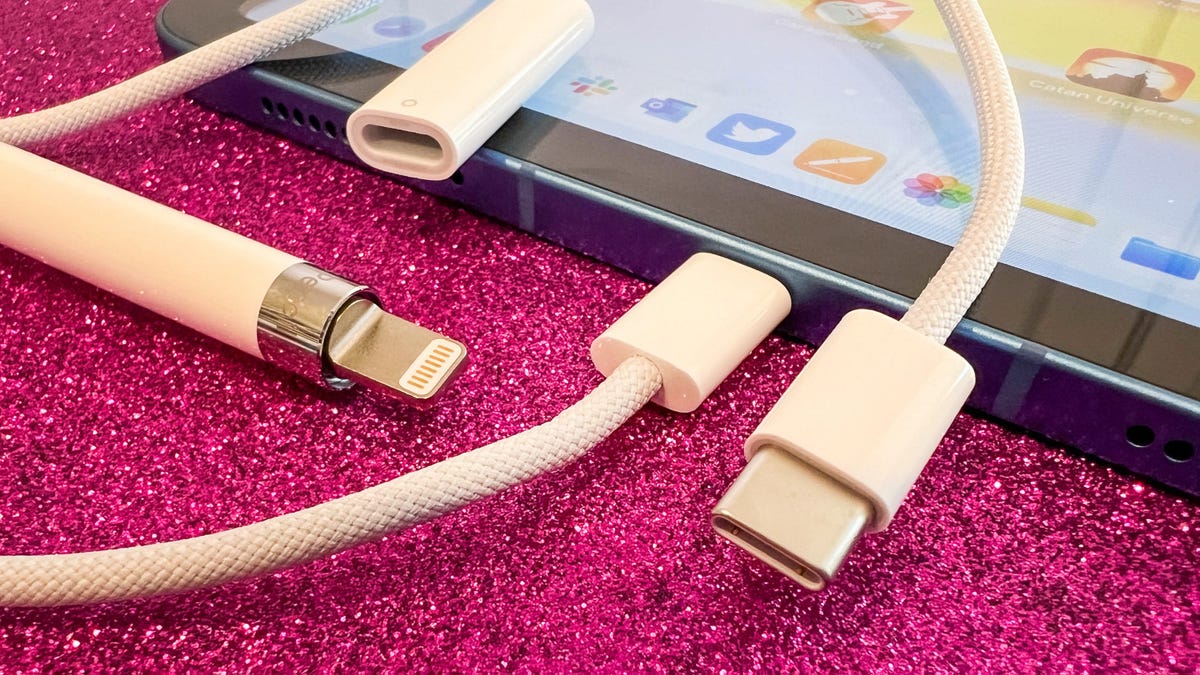

It’s a lot of connectors. Also, that Pencil-to-USB dongle is not included in the iPad box.
Scott Stein/CNET
Except instead of plugging the Pencil into the side of the iPad to charge, you’ll need a separate USB-C dongle and the charge cable to charge it. Not only is that weird, it’s frustrating. The odds I’ll bring all that stuff with me when I need it are slim. If you’re serious about making art on an iPad using the Apple Pencil, this bizarre move is bad enough to skip this model entirely. (Even the iPad Mini works with the Pencil 2, come on.)
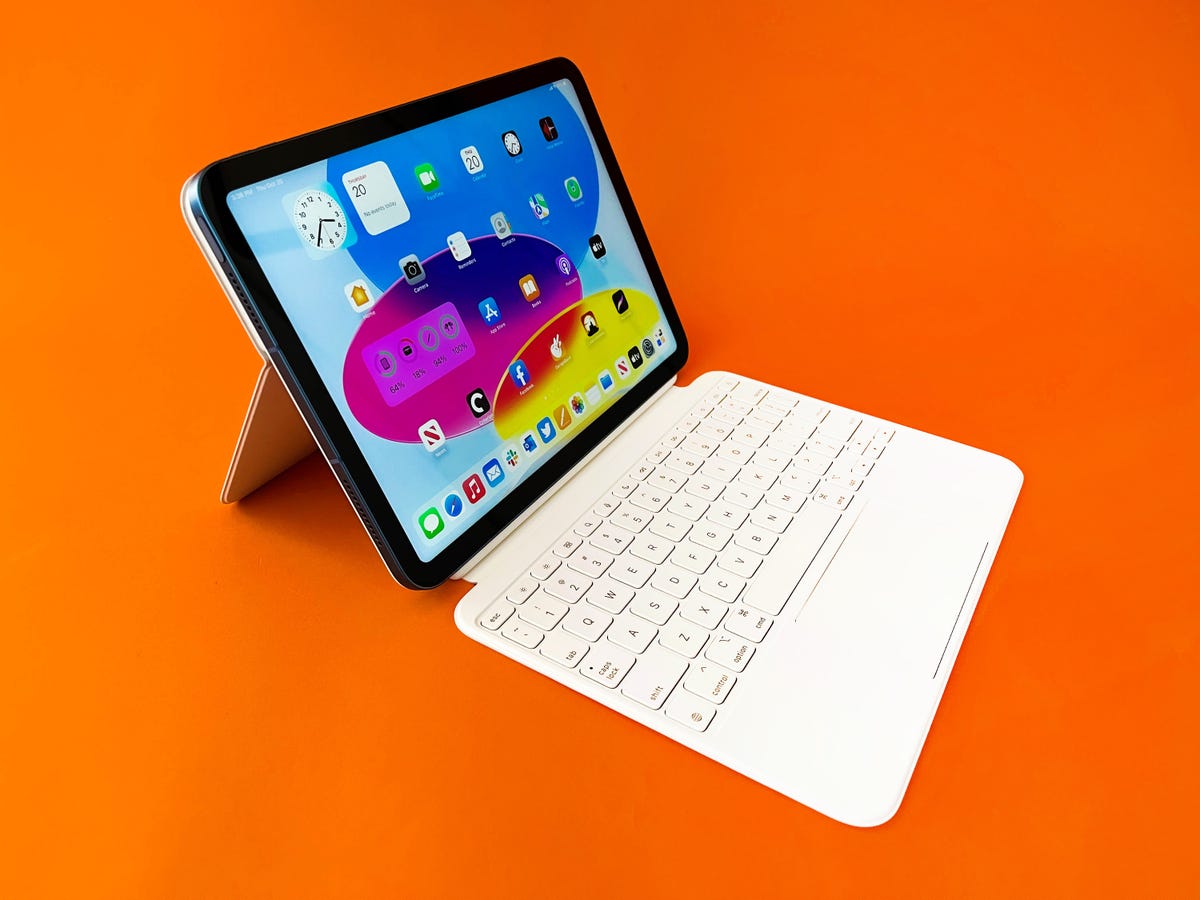

Apple’s new Magic Keyboard Folio has a look similar to previous Logitech cases.
Scott Stein/CNET
Magic Keyboard folio case: An imperfect solution
Apple redesigned its keyboard-connected case yet again for this new iPad, taking an approach that feels a lot different than its Magic Keyboard case. That case, which works with the iPad Air and Pro, is expensive ($300 and up), heavy, can’t be used as an everyday case because of its inflexible angles, but is excellent for working on small work surfaces or laps.
The folio case is still expensive at $250. It’s split into two parts (a keyboard that snaps on the side and a kickstand back cover that snaps to the iPad back), can be used as an everyday case and adds a helpful row of function keys on the top. But it isn’t lap-friendly and lacks keyboard backlighting. I wrote this whole review on it, but I edited and posted it on a MacBook Air.
I’ve used keyboard cases by Logitech and others, and the Surface Pro has a similar keyboard design. You can get Logitech’s cases for less, and they offer better protection: Apple’s case doesn’t protect the iPad’s sides at all, and it looks ready to pop off if you ever drop the iPad. The keys feel a little different to me than the other Magic Keyboards or my MacBook Air. I don’t like it quite as much.
Also, there’s no place to put the Apple Pencil. Which, last I checked, was rolling around somewhere.
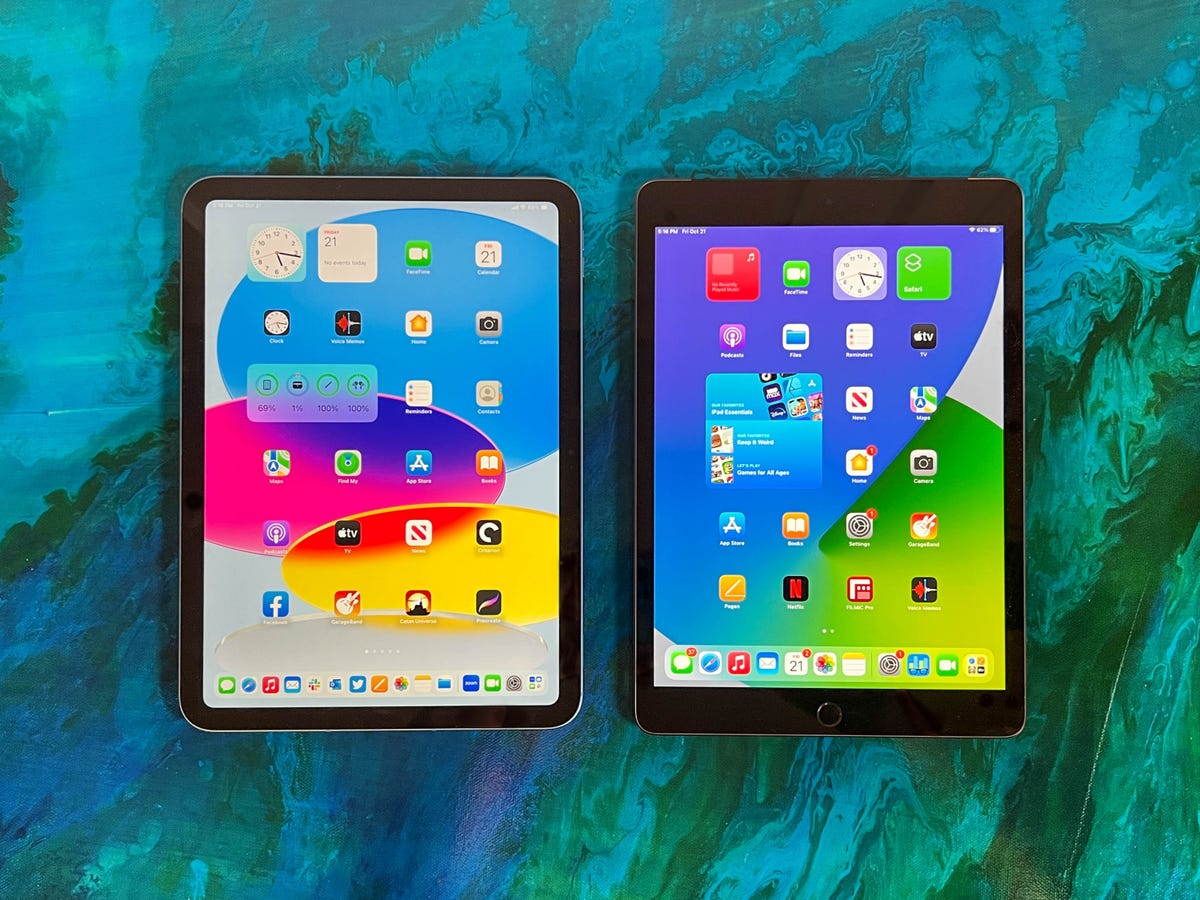

The iPad 10th Gen (left) next to the iPad 9th Gen (right). The new iPad has a better A14 processor: not as fast as M1, but good enough. (The ninth-gen iPad is still fine too, though).
Scott Stein/CNET
Performance: More than good enough
The A14 processor has been around for a while (it was on the iPhone 12). Here it comes with 4GB of RAM, similar to the iPhone 12 and 2020 iPad Air. The results are good: More than fast, but it’s not as blazing as the M1 in the Air or the M2 in the new Pro.
Do you need bleeding-edge iPad performance? I don’t think so. The gains over last year’s ninth-gen iPad are significant, but no different than the iPad Air model from 2020. Apple’s mobile processors are now so powerful that the iPad software needs to catch up to their potential.
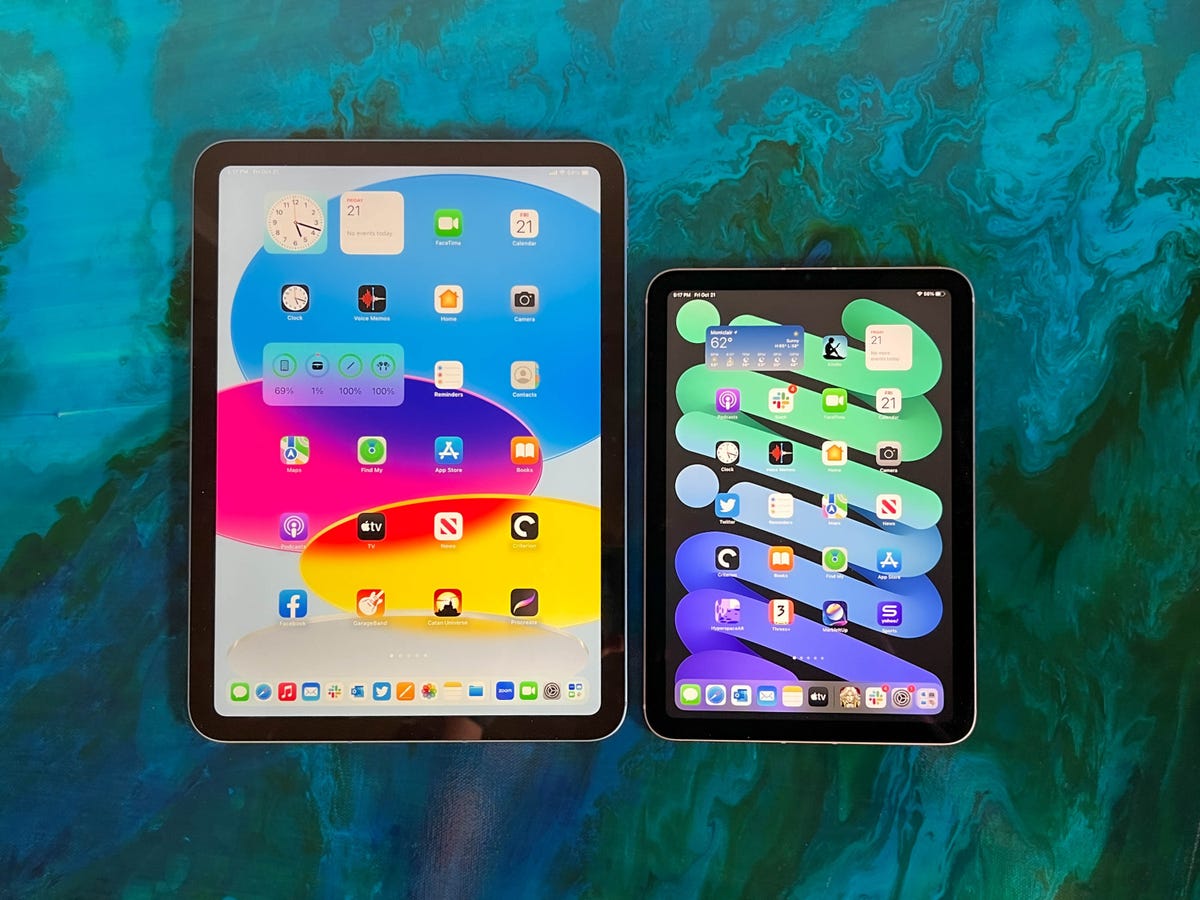

The iPad next to the iPad Mini. The family feels complete. but not all the features have come together.
Scott Stein/CNET
Should you wait? Maybe
Apple’s iPad lineup has been staggered lately: Base and Pro models arrive in the fall (sometimes) and the Air model comes in the spring (sometimes). Last spring’s iPad Air has slight improvements over this iPad, with an M1 chip, subtly better display and Pencil 2 support. But it doesn’t have this newly fixed front camera. The same thing happened last year when the entry-level iPad added Center Stage zoom while the iPad Air was left without it.
The iPad Air costs $150 more and could be tempting. Apple keeps its upgrade increments just within reach, like sizes of popcorn at a movie theater. Suddenly, you’ll find yourself entering iPad Pro land, and a thousand dollar-plus package. Pull back and ask yourself: Will this model go on sale? Would you be happy with last year’s iPad instead? Would you rather see if something better for the Air comes next spring?
The only thing that concerns me for future upgrades is that Apple’s leaning on its M1 chips as the cutoff for more advanced software features, although right now that mostly just means better external monitor support with Stage Manager, a feature that’s currently so buggy Apple’s delayed the release to later this year. I’d say you’re fine without the M1, especially since the A14 is more than good enough.
Down the road, having an old Pencil and a sub-M1 chip could leave this iPad on the other side of the future. Then again, you’ll be saving money. Apple hasn’t made this iPad lineup easy this year. It feels like the iPad is a product still in transformation. Right now, its perfect form doesn’t exist.
The post iPad 10th Gen Review: Better Design, Worse Price first appeared on Joggingvideo.com.
]]>The post PlayStation VR 2 Hands first appeared on Joggingvideo.com.
]]>The PSVR 2 is light. Surprisingly light. If there’s one thing that immediately hits me when trying on the PlayStation VR 2 – Sony’s upcoming immersive headset for its still hard-to-buy PlayStation 5 – it’s that compared with the popular Meta Quest 2, it feels like barely anything at all.
The other big thing I notice comes later. Riding down a river through sun-dappled trees in the world of Horizon Call of the Mountain, as I see a massive, brachiosaurus-size Tallneck march its mechanical robot legs over me, my hand moves past dangling plants. I feel them brush against me, lightly. The vibrating haptics on the PSVR 2 Sense controllers feel so subtle, sometimes I don’t recognize them. But the rumblings of the Tallneck don’t just rumble through my hands – I feel it all around my head too. This headset has helmet haptics.
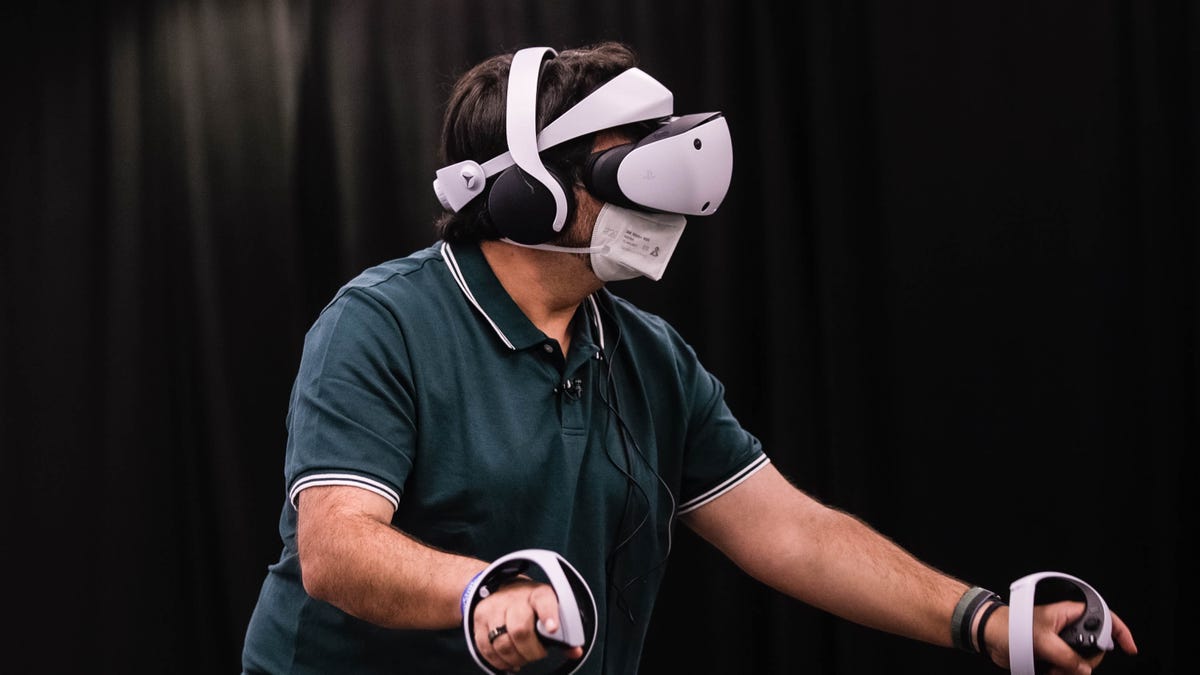
My first demo of the PSVR 2. It arrives in 2023.
James Martin/CNET
At Sony’s PlayStation headquarters in San Mateo, California, I got a full-day look at a headset I’d been waiting to try for over a year.
Sony’s first PlayStation VR debuted in 2016, the same year the HTC Vive and Oculus Rift arrived. Next year could end up being a similarly big one for VR, with Meta prepping new consumer headsets (following a pro model expected in late 2022), and Apple’s long-expected headset. The PlayStation VR 2 is right up there among the contenders if you already have a PlayStation 5.
We still don’t know the price of the PlayStation VR 2, or its specific release date beyond “early 2023,” or what all the launch games will be. But I did get to play four games and try the headset on for hours over the course of a day, and I came away impressed.
PlayStation 5
$500 at Best Buy
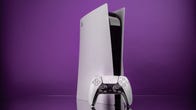
The headset
The PSVR 2 isn’t a self-contained, standalone device like the Quest 2. Instead, it tethers to the PlayStation 5 with a USB-C cable. That may turn some people off, but it’s still standard-issue for PC VR gaming. The PSVR 2’s simpler, one-cable setup is far easier than the bulkier breakout box of the original PSVR, and it doesn’t need any extra tracking cameras: Four in-headset cameras enable full room walkabouts, as long as the cable’s long enough. There’s passthrough black-and-white video of the room around me, too, much like the Quest has.
The visor-like headset attaches similarly to the first PSVR, with the back pulling out when you press a button to fit over your head, then tightening with a small knob on the back. The display is surrounded by a rubbery shield that blocks light. My wide glasses, which don’t fit easily in a Quest 2, worked just fine with the PSVR 2.
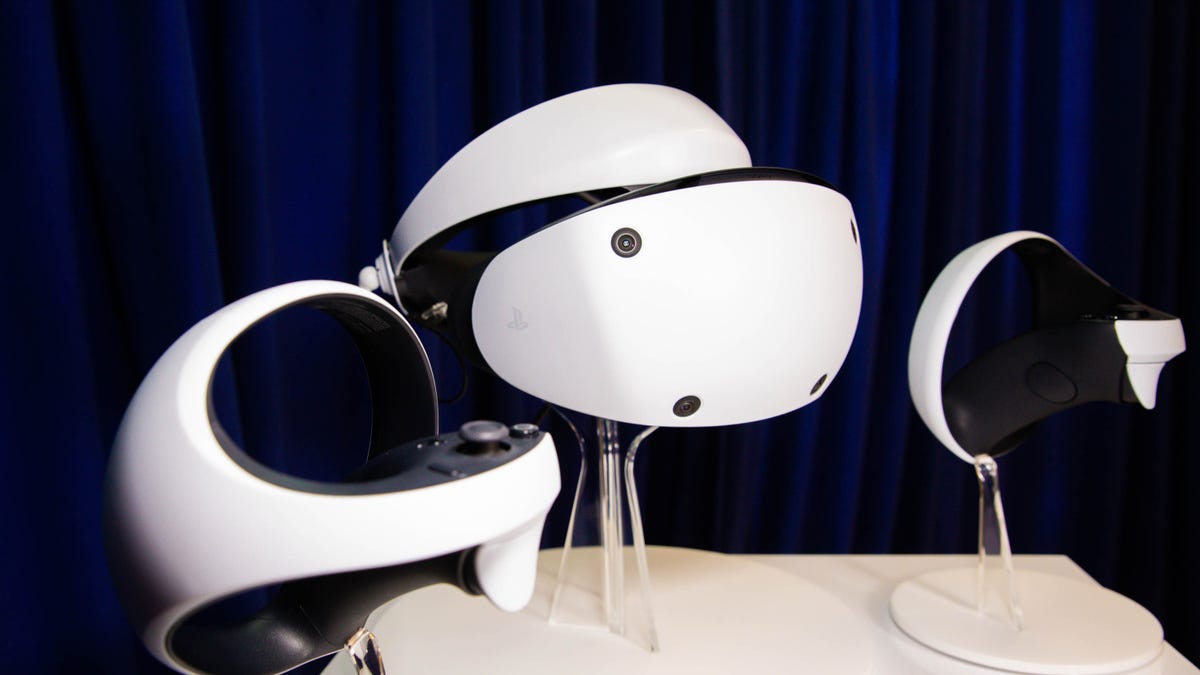

The PSVR 2 headset next to its Sense controllers. Familiar headset design, but it feels light and compact to wear.
James Martin/CNET
At 110 degrees, the OLED display has a wider field of view than the Quest 2, and the field of view looks less like a porthole from the inside. The display is vivid, too: Blacks are truly black, and the HDR effects create bold contrasts between bright sunlight and shady corners. Games I played showed off surprising levels of detail when I looked closely at objects and textures. The 2,000×2,040-pixel per eye display is higher resolution than the Quest 2, but also, the PlayStation 5’s graphics capability is very high.
This headset also features foveated rendering using eye tracking. Foveated rendering is a technique where only the things in the middle of where your eye is looking are rendered in the sharpest detail. It mirrors how our eyes actually work, to some degree, and can squeeze better graphics performance by reducing the workload on the processor. Basically, it meant the games I played looked really, really nice.
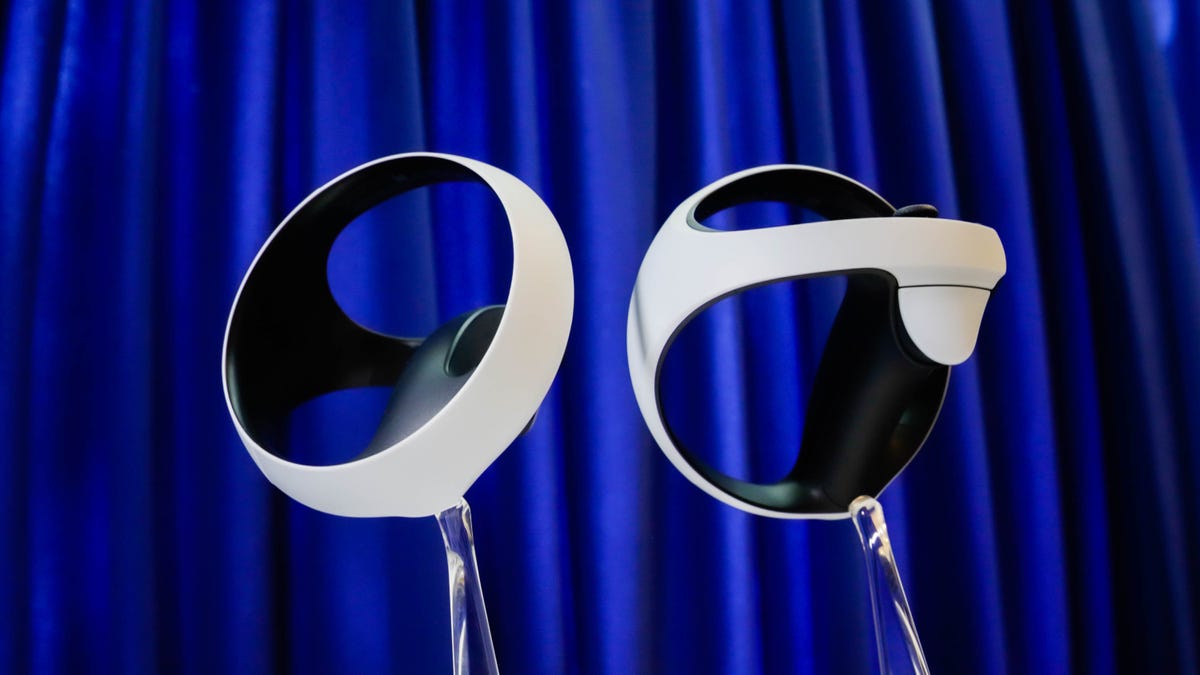

The Sense controllers are lovely.
James Martin/CNET
The Sense controllers
Sony has finally made a pair of real VR controllers. It only took six years. They also might be my favorite VR controllers right now.
The 2016 PSVR borrowed older PlayStation Move controllers that lacked analog sticks and felt primitive compared with other VR gear, but the PSVR 2’s controllers, just called Sense, have a design borrowed from newer input devices like the Oculus Touch. An analog stick and two buttons line each one, in a smaller layout than the way things are placed on the Quest 2 controllers. Triggers are on each, plus secondary clickable grip buttons below that.
The controllers feel light too: The rings that are part of their design sit back behind my hands, and I feel like they float around my knuckles. The grips become things I grab or let go of. Sometimes the controllers feel like Valve’s Index “knuckle” controllers, that way, where I start gripping my entire hand versus just three fingers to do things on the Quest 2. When holding weapons or climbing VR cliffs, it feels convincing.
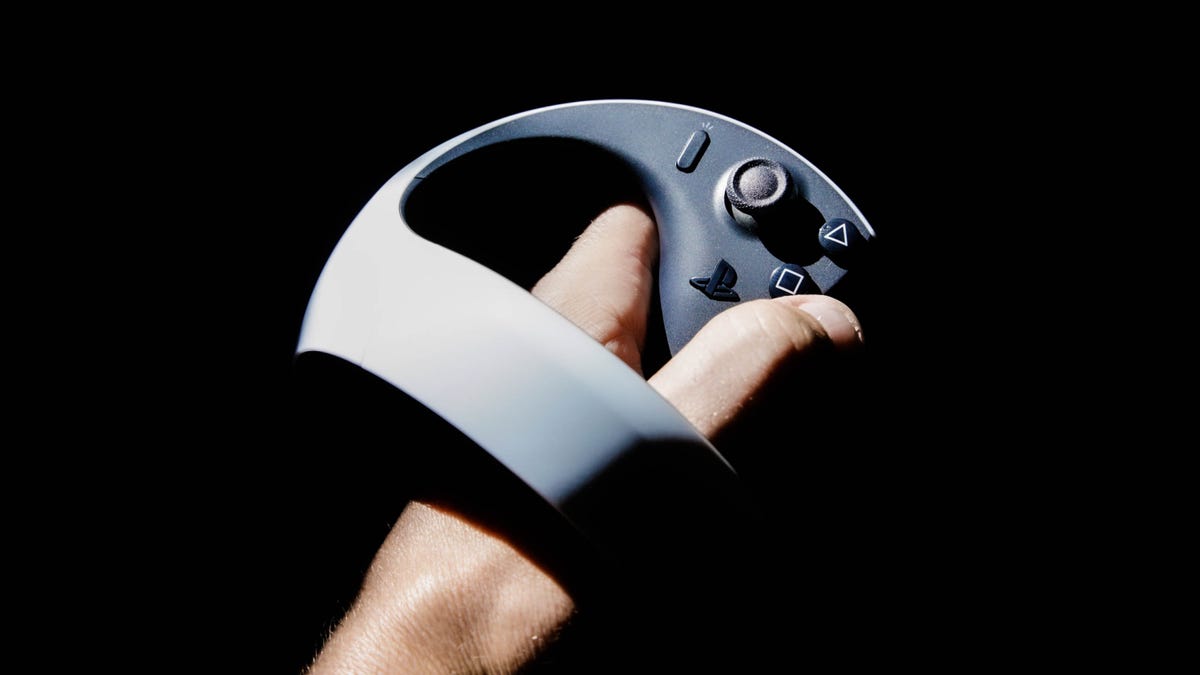

The controllers fit comfortably, and they melt away a bit when playing.
James Martin/CNET
But the killer part is the haptics. Sony has adopted the same rich haptics tech on the PS5 DualSense controllers, which can register small taps, rippling rumblings and all sorts of convincing vibrations that are far more advanced than the generic buzzes of the Quest 2 controllers. The triggers also have feedback – again, based on the adaptive trigger tech on the DualSense. Pressing a trigger on different weapons in Star Wars: Tales From the Galaxy’s Edge means some have resistance early on, and others feel easier to pull. Some have kickback you can feel in the trigger and the haptics. Grabbing ledges can start to feel slippery or firm. Through all the games I played, I realized this was where VR haptics needed to be from now on. It’s set the table.
The games
I played four games over my full day with the PlayStation VR 2. Three of them were sequels, ports or adaptations of existing games. The other was a brand-new game based on a known property (Sony’s Horizon games). None of the games reinvented VR in any massive way, and in a lot of ways the controls for most of the games matched familiar interfaces I’ve gotten used to in other games over the years. The PSVR 2 isn’t expected to arrive until early 2023, so I’m sure other games will emerge, although Sony has confirmed that the PSVR 2 won’t be backward-compatible with older PSVR games. What these demos offered, more than anything, was a chance to see how Sony’s new headset and controllers compare with what I’ve played before.


Bows and arrows feel great in Horizon: Call of the Mountain.
Sony Interactive Entertainment
Horizon: Call of the Mountain, Guerilla/Sony
Sony’s flagship exclusive PSVR 2 game was announced earlier this year. Set in the same far-future universe as Horizon Zero Dawn and Horizon Forbidden West, this one’s a standalone game that’s made for newcomers to enjoy, too, with some overlap with the PS4/PS5 games.
The demo put me on a boat heading on a Jurassic Park-like river ride past familiar Horizon creatures: raptor-like Watchers, and a massive lumbering Tallneck that towers overhead. The game then becomes about wandering around wilderness camps, climbing cliffs by grabbing ledges in a similar way to the VR game The Climb, and shooting arrows at enemies and secret targets with a bow and arrow. The landscapes are gorgeous, colors vivid. I notice the impressive controller feedback when climbing ledges and shooting arrows, and the rumbling headset haptics kick off when large creatures move around me. The sensation I get is massive and theatrical, and while the demo ends sooner than I’d like, Call of the Mountain is clearly an experience to get lost in.
According to the developers, eye tracking is used subtly later on in the game (perhaps to allow characters to make eye contact with me), but the advantages of eye tracking only show up otherwise to create enhanced graphics with foveated rendering – something the other games I played also have in common.
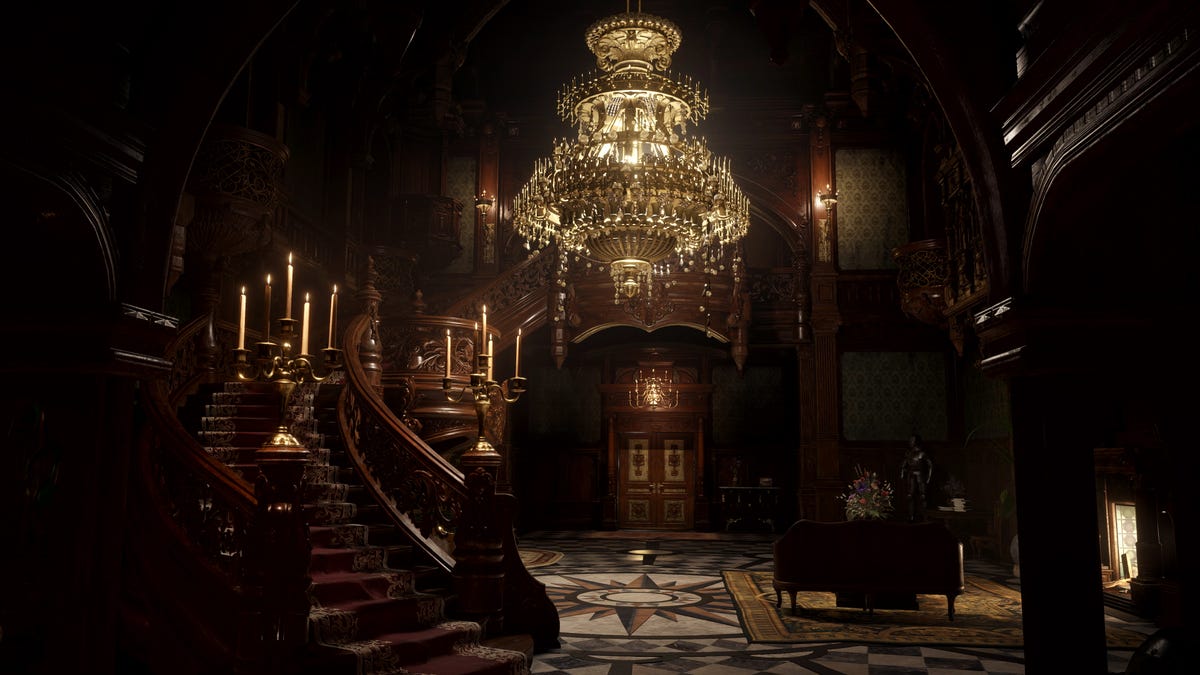

Environments in Resident Evil: Village really looked this good in VR.
Capcom
Resident Evil Village, Capcom
I kept away from Resident Evil 7 in VR because I was terrified of it. I’ve since played Resident Evil 4 on the Quest 2, and gotten less worried about VR jump scares. I also never played Resident Evil Village before my VR demo experience (sorry!), but Capcom’s PSVR 2-exclusive adaptation truly feels like a video game fully adapted to VR without any loss. I was particularly impressed, again, by the headset’s graphics output. Environments look vast and moody, but full of detail. Entering the tremendous castle, I’m immediately drawn to the paintings on the wall and the carvings on doors. Lighting from nearby windows or candle-lit halls looks convincing and rich. I meet Lady Dimitrescu, who leans over and sucks on my hand in a way that makes me cringe.
The scale of the world works wonderfully, and it comes across like immersive theater, some sort of Sleep No More horror experience. Sometimes the game’s motion tracking doesn’t line up with my body (there were a few game glitches in my demo), but the speed of the gameplay and the richness of the graphics gave this game an almost non-VR feel. I stopped thinking about the controllers, too: It’s almost like they melted away, which was a credit to the design.
Also, I panic when a bunch of freaky monsters surround me, and I just stab them relentlessly before realizing I could have been reloading my pistol this whole time.
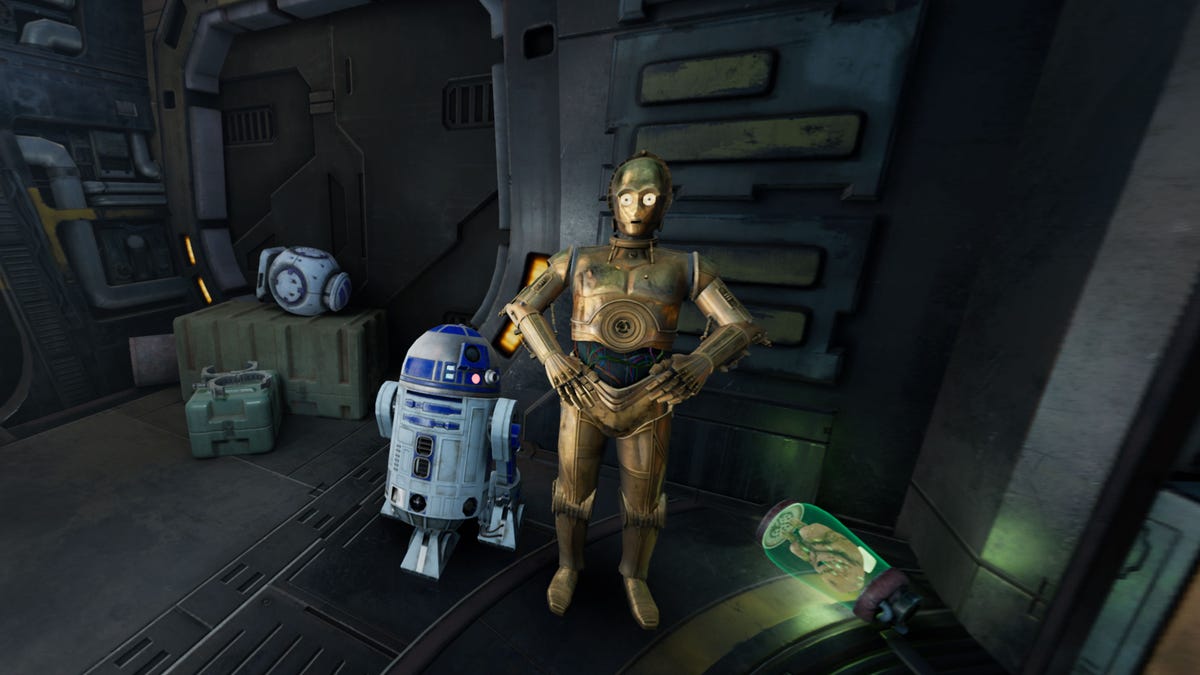

Tales From the Galaxy’s Edge has a graphics update and much better haptics.
ILMxLab
Star Wars: Tales from the Galaxy’s Edge, ILMxLab
One of my favorite games for the Meta Quest 2 is being ported over to PlayStation VR 2. This was a surprise game, but ILMxLab did the same with Star Wars: Vader Immortal a few years ago. It’s a shooter with interludes at a cantina, all of it set on Batuu (the same world that Disney’s Galaxy’s Edge theme park exists in). The game’s graphics and controller haptics have been upgraded, and besides all the characters looking far more vivid, all the weapons now have an uncanny sense of vibrational realism. I notice that small blasters have different-feeling triggers and recoil than a large pulsing shotgun. I could identify weapons from how they feel via haptics.


The action gets intense.
Skydance
The Walking Dead: Saints and Sinners Chapter 2, Skydance
Again, one of my favorite Quest games makes an appearance on PSVR 2. This new chapter isn’t available anywhere yet, but the gameplay (lots of zombies, lots of weapons to load up and so many areas of my body to pin flashlights and tools and other things) remains the same as other versions. Again, it’s the subtle haptics and the improved graphics that make the biggest impression.
A few drawbacks: Tethering, tracking
The PSVR 2 does have a single USB-C cable that tethers it to the PS5, and it’s unfortunate. But I’ve had the same tether when playing PC games in VR. At least it’s just one cable, and even though it sometimes wrapped around me when I turned a lot in some active games, it was bearable.
One other thing I noticed a handful of times was the headset lost tracking: either my headset, or the controllers. I’m playing on a very early version of the hardware, and a camera person filming me at close range while playing may have thrown off the in-headset tracking cameras. Still, any loss of tracking isn’t ideal.
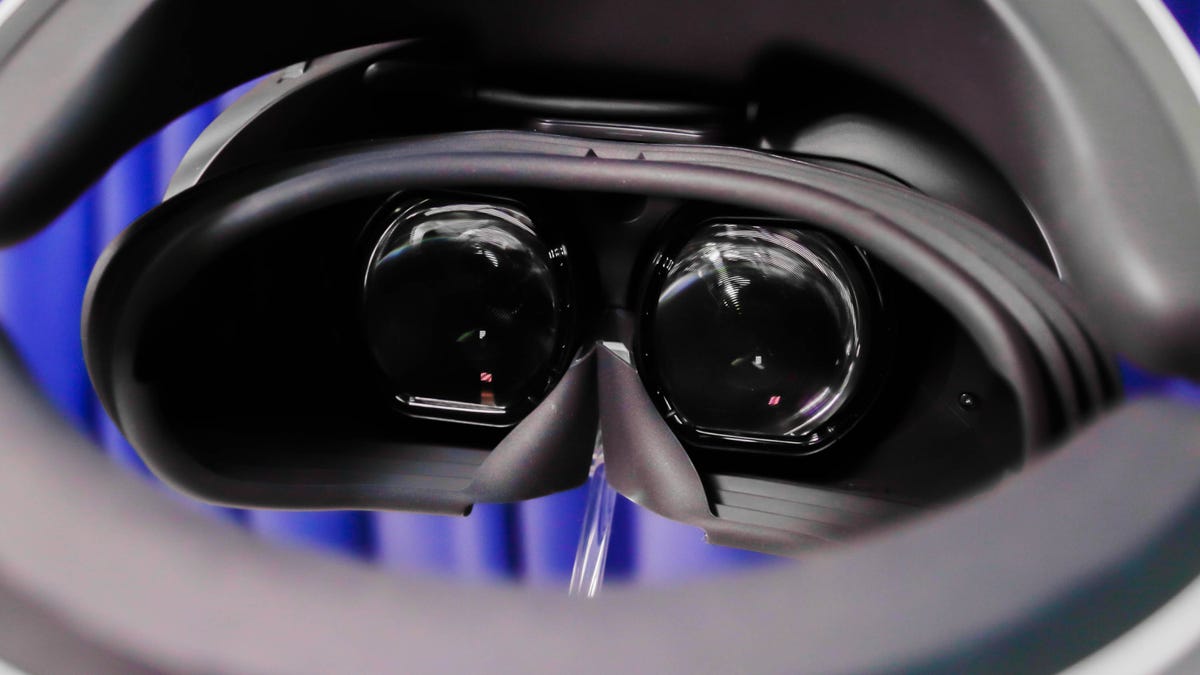

The PSVR 2 has eye tracking. How much will games use it?
James Martin/CNET
Will any games truly take advantage of eye tracking?
The games I tried didn’t really use eye tracking in any unique ways during my demos, which was a little surprising. That might be because many of these games are being adapted from VR platforms that don’t have eye tracking. The PSVR 2 is the first mainstream headset with the feature, although many more may be on the way.
There are possibilities for eye tracking to improve game controls, allowing your eyes to lock in on an object and target it without needing to move your head or the controller. Eye contact with characters could provide a theatrical level of intimacy. Games could also start recording heat maps of your attention and become better able to suggest ideas or hints based on where it knows you’re not looking.
Talking to some of the developers during my day of demos, they all seemed excited by the possibilities. Maybe, as eye tracking becomes more of a norm for VR and AR, more games will add support for it. I didn’t get to see enough yet to know how big an impact it could make.
2023 can’t come soon enough
The PlayStation VR 2 doesn’t have a price yet, or an official release date, or a larger list of launch games. Even though this isn’t a standalone headset, it’s clearly the VR experience I’ve always wanted on a PlayStation. The new controllers and improved and advanced haptics and triggers alone push this hardware into new gaming territory. I much prefer the lighter-weight, larger field-of-view, higher-res, OLED display-equipped PSVR 2 headset to the Quest 2. While the Quest 2 is still the best self-contained VR system around, the PSVR 2 looks like it could be the destination for a whole new wave of more impressive VR games.
All I know is I want to play more. When I got home after my weekend in California, I saw my unplugged pile of PlayStation VR cables sitting on my desk. I look at the old, heavy headset, and the ancient controllers. The PlayStation VR 2, in retrospect, feels even more amazing in comparison.
Game console reviews
- Sony PlayStation 5 Review
- Microsoft Xbox Series X Review
- Microsoft Xbox Series S Review
- Nintendo Switch OLED Review
- Meta Quest 2 Review
- Valve Steam Deck Review
See the latest CNET gaming coverage here.
The post PlayStation VR 2 Hands first appeared on Joggingvideo.com.
]]>The post Apple Watch Series 8 Review in Progress: My Thoughts After a Week first appeared on Joggingvideo.com.
]]>This story is part of Focal Point iPhone 2022, CNET’s collection of news, tips and advice around Apple’s most popular product.
The Apple Watch Series 8, starting at $399 (£419, AU$629), joins the temperature sensing wearable pack with a new temperature sensor of its own. Temperature-sensing wearables have been a trend these past few years, from the Fitbit Sense to the Oura Ring, Amazon’s Halo band and Samsung’s Galaxy Watch 5. A few weeks ago, I got sick and a little ring on my finger let me know my temperature was elevated. So, in my experience temperature reading isn’t just another check-the-box feature.
Also, this isn’t the only new Apple Watch, though. The lower-cost Apple Watch SE and more expensive Apple Watch Ultra make a broad range, going from $249 up to $799 and beyond.
This year, with three new Apple Watches, the challenge is knowing which one to get — if any.
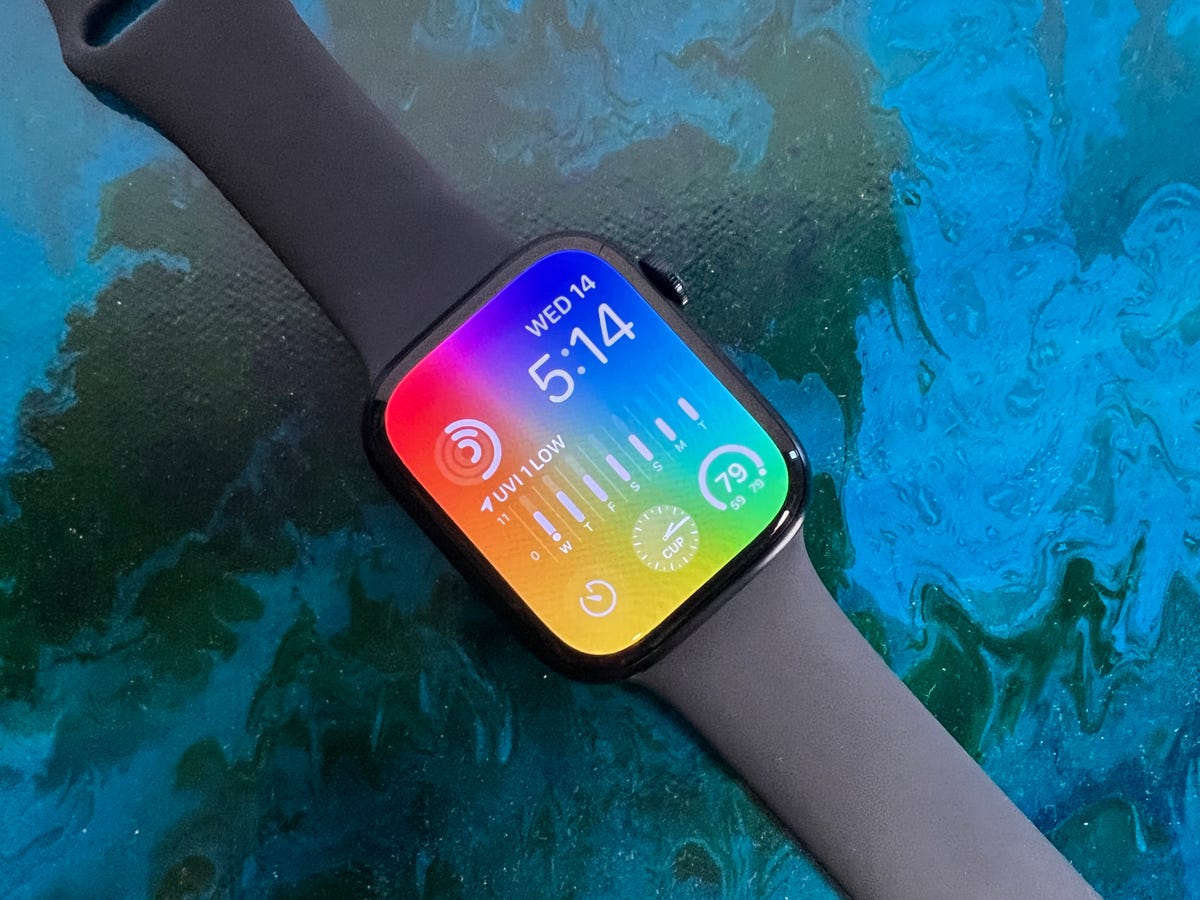
The Apple Watch Series 8 adds a temperature sensor. But how it performs over time is still TBD.
Scott Stein/CNET
After wearing Apple’s latest watch on my wrist for less than a week, it’s hard to tell. The Series 8 looks identical to last year’s Apple Watch Series 7 and has most of the same features. New to the 8 is its temperature sensor, along with improved gyroscope and accelerometer motion sensors that are now able to detect car crashes and make SOS calls in the event of an emergency.
I didn’t test the car-crash feature, for obvious reasons. And, as of the time of this article publishing, I’ve only just had my nightly temperature data start to appear. Both features could very well end up being useful over time, but how useful remains to be seen.
Apple Watch Series 8
$399 at Apple

The best part of the Apple Watch this year is its software improvements. WatchOS 9 adds a number of extras that are really great: a compass app that now tracks your steps via GPS to help you navigate back home during hikes, medication tracking, multistage sleep tracking and a low-power mode that shuts down some functions to extend battery life. But you don’t need a new watch for these; a free update to WatchOS 9 could give you these upgrades and make you feel like you already have a new watch.
Apple’s approach to improving its watch over time has been a steady accumulation of upgrades — an always-on display one year, blood oxygen the next, a slightly larger display and now temperature sensing. Skipping a bunch of years between upgrades can end up adding a lot of new features in one big bunch, but anyone who has a Series 7 will have a hard time justifying the purchase.
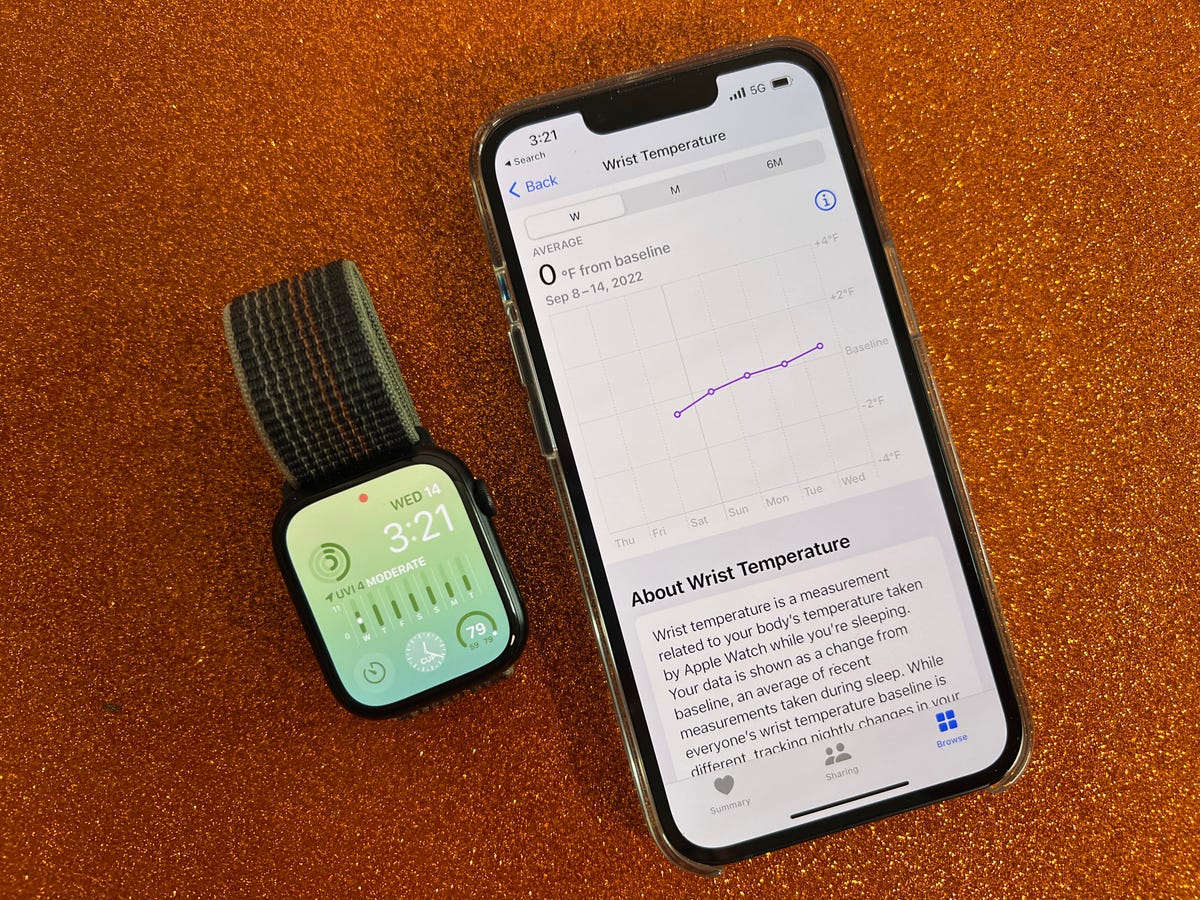

Temperature sensing shows up in the Health app. Readings are relative, so you’ll only see increases or decreases, not absolute numbers.
Scott Stein/CNET
Apple Watch Series 8 temperature sensing
Apple’s temperature sensor measures skin temperature, similar to how other wearables work. It also measures air or water temperature (water temperature readings can show up in some apps that use the sensor). The sensor looks at relative temperature change, showing relative increases or decreases in degrees, but not an absolute temperature like a thermometer.
The measurements are collected at night while sleeping, and it takes five days for the watch to collect enough data to establish a starting baseline. (According to Apple, the baseline temperature will keep calibrating over time.) From that point on, the measurements only show up in Apple’s Health App on the iPhone, under Skin Temperature. I could check the chart and see what my temperature changes were, but Apple’s not currently alerting wearers of changes on their wrist, or any other way. The measurements also aren’t being used for any sort of Readiness or Wellness score, like companies such as Fitbit and Oura are already doing. Apple is likely going to spend the next year, at least, trying to figure out how to surface that data more. In the meantime, maybe you want to wait before deciding if the sensor plays into the value of the watch.
One more immediately useful area for temperature-sensing data is ovulation tracking, another new watch feature. Similar to how Fitbit and Oura already work, the temperature shifts are used to track fertility cycles, as well as possible interruptions. CNET will test this over the next few months, much as we have with other trackers. And a word about privacy for this type of data: Apple says its Health data remains encrypted on the user’s account and in iCloud, and if two-factor authentication is turned on, no one else can access it.


One of the new WatchOS 9 watch faces: Stunning, but you don’t need a new watch to enjoy it.
Scott Stein/CNET
Apple Watch Series 8 car-crash detection
Apple’s improved motion sensors on the Watch 8 are being put to use for crash detection, which the iPhone (and other devices) can already do in some instances. Much like Apple’s fall detection feature on its watches, it’s potentially a life-saving feature if it can sense a crash and make an emergency call while someone is debilitated. Unfortunately, knowing how reliable this feature can be is something we just can’t determine yet. I love the idea of watches as safety-monitoring tools, though, but Apple also includes car-crash detection on the cheaper Apple Watch SE.
On a side note, I’m curious what else the more accurate gyroscope and accelerometer could be used for. Would these sensors be able to more accurately track other body movements or activities over time when new algorithms are refined? Or could they be used to improve gesture tracking? Or, as Apple approaches the release of its expected AR/VR headset, would improved motion controls be a doorway to controls for mixed reality? I’m heading down a road of pure speculation, but I’d be surprised if car-crash detection was all they were capable of.
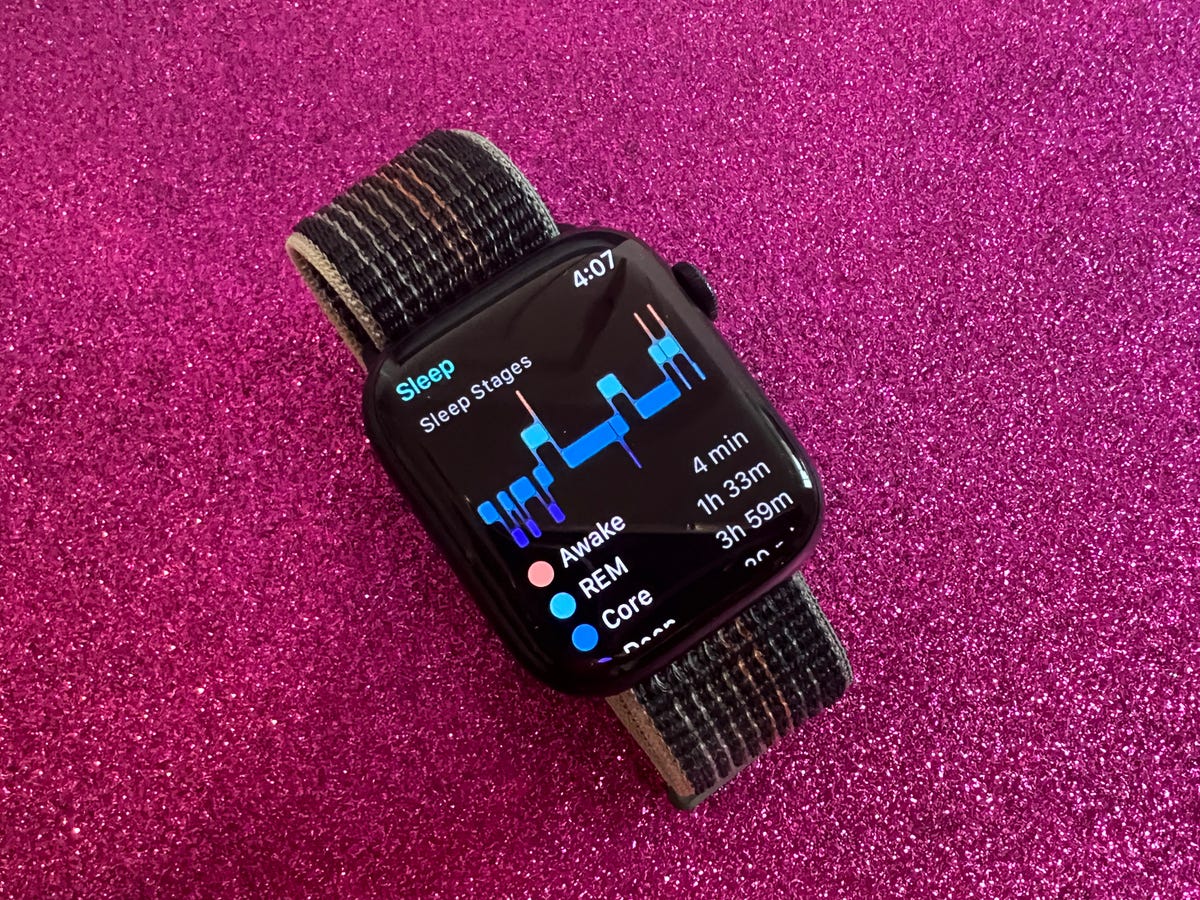

Sleep tracking is improved, but battery life isn’t.
Scott Stein/CNET
Apple Watch Series 8 battery life
One big missing piece to the midrange Apple Watch is its battery. There is an Apple Watch that can last an estimated 36 hours or more on a charge, but that watch costs $799. The Apple Watch Ultra is big and rugged, and we haven’t even reviewed it yet.
With sleep tracking now a full-featured part of WatchOS and temperature tracking needing a night’s sleep to measure, the Apple Watch is now designed to be worn to bed. That’s a problem when the Apple Watch’s battery life is still only about a day and a half. The watch charges up fully in about an hour and a half, or up to 80% in 45 minutes or so, but when will you charge it? Before bed? In the morning while showering? At your desk?
I wore the Series 8 to bed one night after being fully charged, wore it the whole next day, to bed again, and it was at 34% battery the next morning. You could make it through a day or more without charging, but since the Apple Watch has its own proprietary charger, you’ll have to make sure you’re not stuck somewhere with it running low.
I tend to be a charge-at-night person, or with longer-battery wearables like the Oura Ring or the Fitbit Sense, I wear them for days before needing to worry. It feels like the Apple Watch Series 8 is caught in the middle right now. That low-power mode won’t help, either, because it turns off temperature tracking and heart rate in order to get those longer-life battery gains. Maybe you could flip back and forth between modes, perhaps? Still, I’d place “bigger battery” at the top of my Apple Watch Series 9 wish list.
I haven’t lived with low-power mode much this past week, since I was busy tracking temperature data — but I’m curious to see how it impacts battery life over the next few weeks.
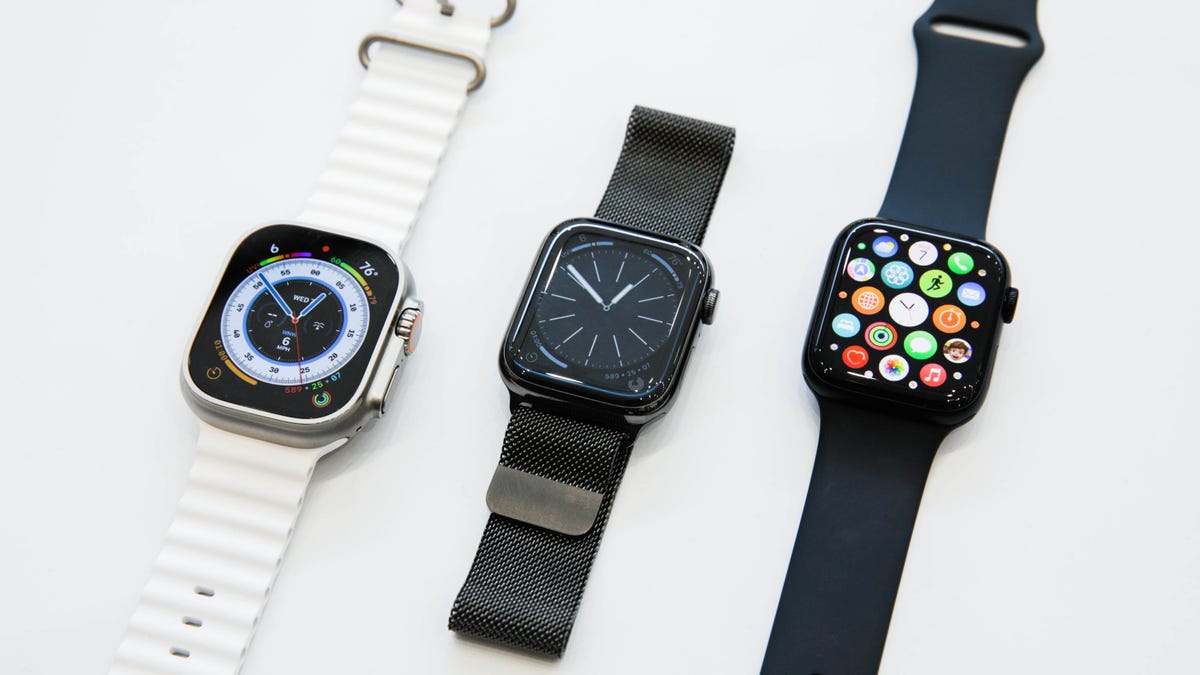

The Apple Watch Ultra, Series 8 and SE. All should perform well now, but the feature sets scale up.
James Martin/CNET
Apple Watch Series 8 vs. SE and Ultra: Should you upgrade?
The Apple Watch Ultra has a more durable design, longer battery and better water resistance. Is it the better choice? The SE, which lacks blood oxygen, ECG, an always-on display and temperature sensing, might be a good pick for someone who doesn’t need as much (but the lack of an always-on display isn’t ideal). And will temperature tracking feel useful over time, along with ovulation tracking?
There’s little reason to upgrade to the Series 8 if you have a Series 7, or even a Series 6. But, the Apple Watch Series 8 is the most complete health watch in Apple’s lineup that doesn’t need an upgrade to the Ultra.
The good news about Apple’s new and improved watch lineup is the processors should all be equally fast, but the design and features scale up. Buying last year’s Series 7 if it’s on sale is an excellent alternative, but the 8’s biggest draw over the SE right now is its always-on display, slightly bigger screen and its extra ECG, blood oxygen and temperature sensors.
Check back here in a month or two, and we’ll answer this more clearly. For now, the Apple Watch Series 8 remains an excellent piece of watch hardware with improved software and a health sensor that could be a factor down the road. But first, check your wrist: You may already have an Apple Watch that’s good enough.
More on new Apple tech
- Should You Upgrade to the iPhone 14? How It Compares to Older iPhones
- iPhone 14 Pro and 14 Pro Max Review: Welcome to Apple’s Dynamic Island
- Apple Watch Ultra vs. Series 8 vs. SE: The Entire Lineup Compared
- Apple iOS 16 Released: The New iPhone Features You Get From the Update
- AirPods Pro 2 Hands-On: Crisper Sound, Better Noise Canceling
The post Apple Watch Series 8 Review in Progress: My Thoughts After a Week first appeared on Joggingvideo.com.
]]>The post Apple Watch Ultra Hands first appeared on Joggingvideo.com.
]]>This story is part of Focal Point iPhone 2022, CNET’s collection of news, tips and advice around Apple’s most popular product.
The Apple Watch Ultra, announced alongside the Apple Watch Series 8 at Apple’s “Far Out” product event, may be the biggest change we’ve seen to Apple’s watch line-up in years. It arrives Sept. 23, a week after the Watch Series 8. And it’s most definitely not a look — or a price — for everyone.
Apple’s watch lineup has been slowly expanding, much like the iPhone line did. Apple used to only launch one watch a year, but the Apple Watch SE introduced a more affordable model to the mix. The Apple Watch Ultra goes in the opposite direction: It’s more expensive, but unlike previous fashion-driven Edition watches, the Ultra is aiming for function… and endurance. Also, it’s by far the biggest Apple Watch of the lineup.
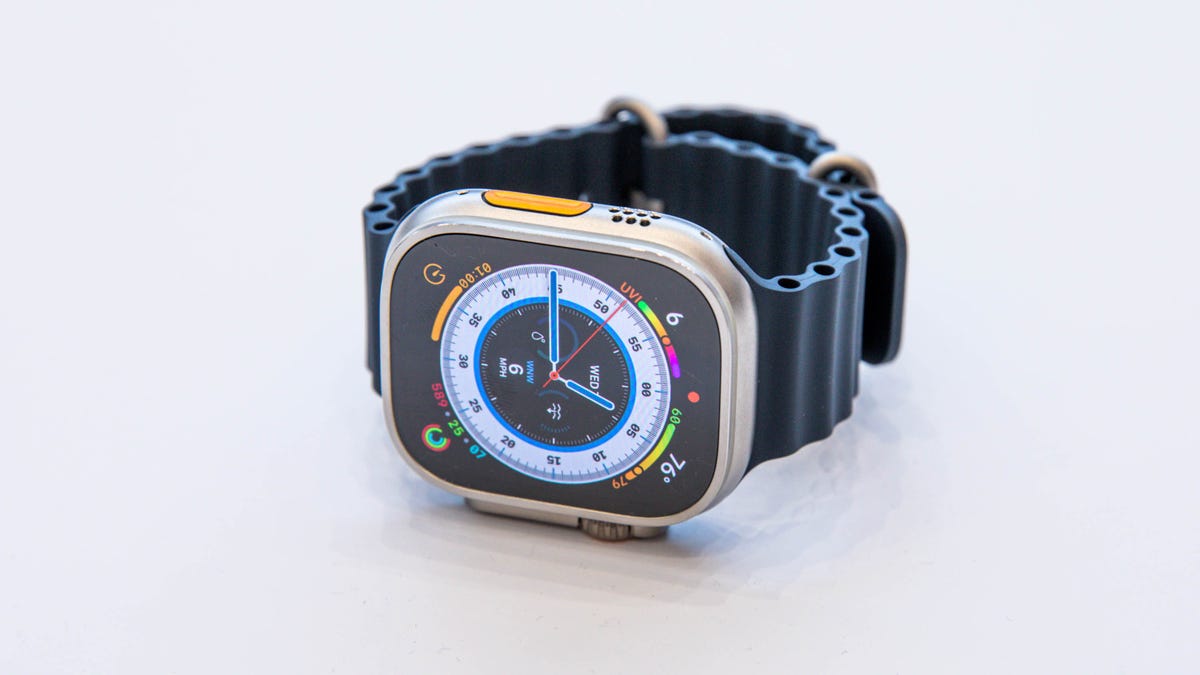
The Apple Watch Ultra has a whole new design, with familiar echoes.
James Martin
Next to the Apple Watch SE and Watch Series 8, the Ultra is like the Apple version of a Casio G-Shock. The new design pushes its crown and side button into an extended side part that, alongside the new watch’s bigger case and curved-with-flat-display contours, make it seem more James Cameron than any previous Apple Watch.
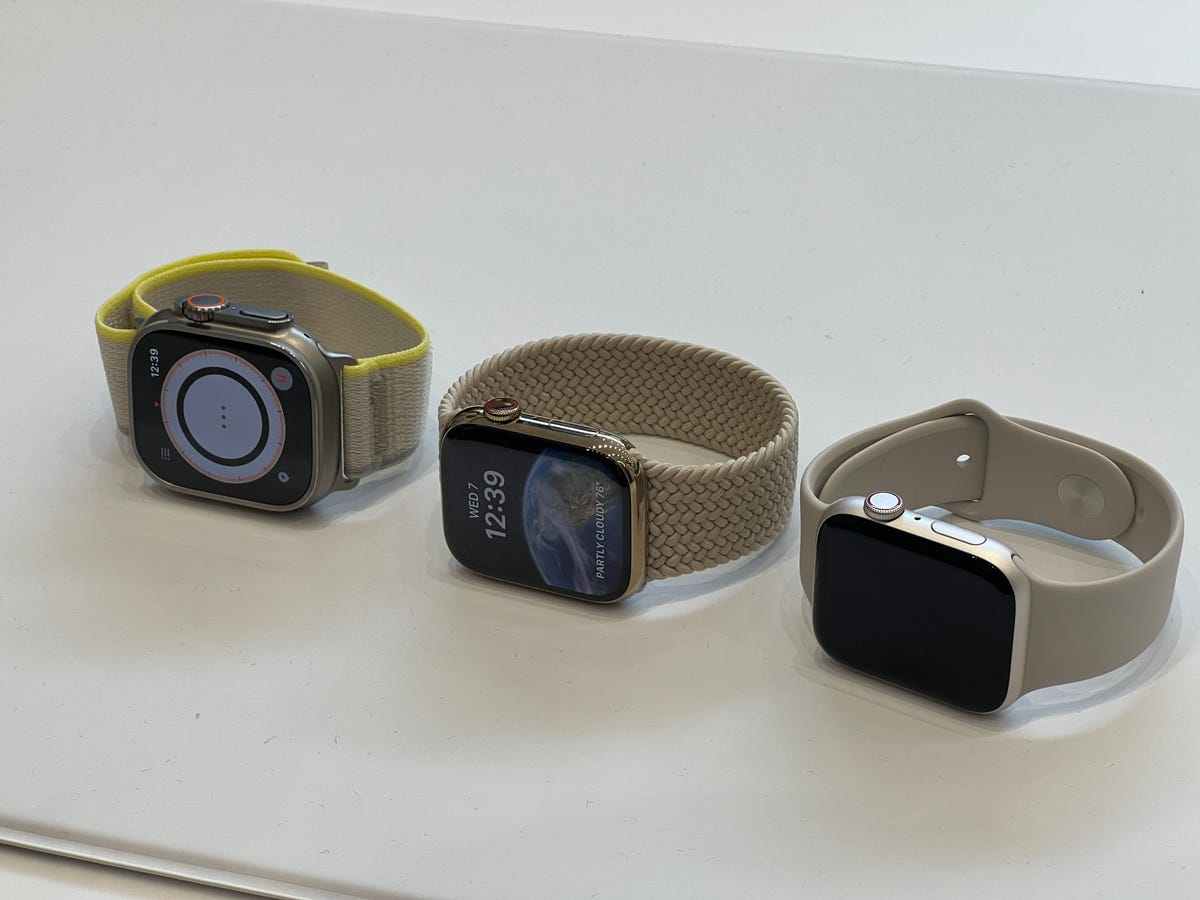

The Apple Watch Ultra, Apple Watch 8 and Apple Watch SE (left to right).
Scott Stein/CNET
But, as you can see from a side-by-side comparison, it’s not a drastic departure. The distinctive look might even appeal to some people who would prefer a bulkier or bolder watch design. In its own way, it’s a more eye-catching move than Apple’s previous, more subtle Edition case finishes.
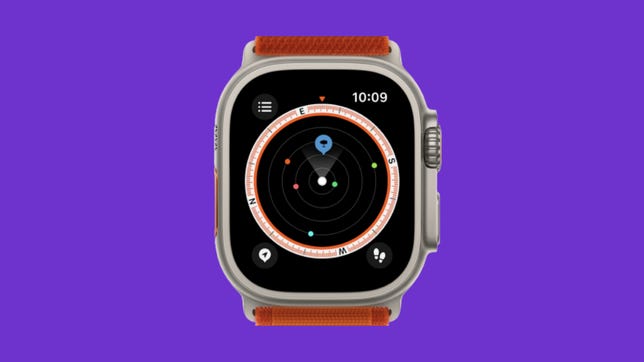

Apple/Dawnthea Price Lisco/CNET
Apple Watch Ultra: $799
Preorders now open
Preorder your Apple Watch Ultra from Apple with prices starting at $799. Devices start shipping on Sept. 23.
$799 at Apple$799 at Amazon$799 at Best Buy
The new watch has a titanium case, sapphire flat front crystal, and 49mm case size with a brighter display (2,000 nits). There’s a new dedicated second button, an improved speaker and a clear, ruggedized design. Cellular is also the only model it comes in. It’s a lot of new features.
The Ultra’s biggest new feature, a significantly larger battery, is something the Apple Watch hasn’t had since it debuted. The typical Apple Watch battery life is about a day and a half; the Ultra promises more: 36 hours of full-power use, ramping up to 60-plus hours in reduced-function low power mode.
Apple’s Newest Releases
- iPhone 14 Pro, Pro Max Review: Welcome to Apple’s Dynamic Island
- iPhone 14 Review: A Good Upgrade for Most People
- Apple Watch Series 8 Review: Improvement By Degrees
- Apple Watch SE Review: Almost Everything I Want
- Apple iOS 16 Released: New iPhone Features From the Update
There’s also a new watch face called Wayfinder with extra readings for outdoor activities.
Wearing it on my big wrist, the Ultra still looks big. It’s not as heavy as I expected, though. The look, especially with its bold and function-oriented straps, is definitely bolder than I’m used to.
Last year, an expected watch redesign never materialized, although Apple did increase the watch screen size. The Watch Ultra does have a new look, including a flatter front and a bump-out side where the crown and side button are, plus a new programmable second button on the other side.
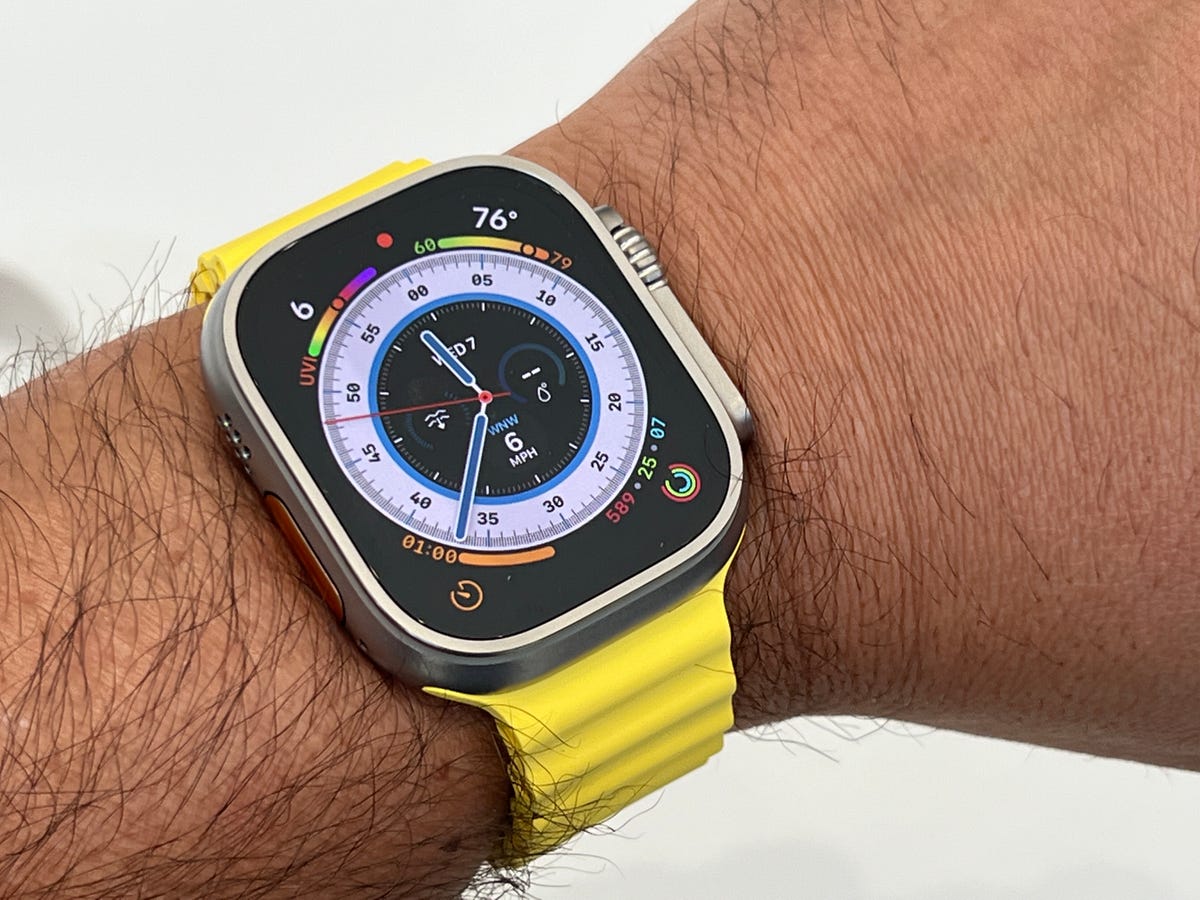

The Ultra on my hairy wrist.
Scott Stein/CNET
The buttons are easy enough to reach, although I’m not sure how I feel about the bumped-out digital crown. I can see why it was done, though: It looks like it’ll be easier to access when wearing gloves or gear underwater.
New straps include a wavy rubberized Ocean Band designed for fitting over wetsuits, a lightweight and slightly elastic Trail Loop that’s like a refined version of the existing Sport Loop, and an Alpine Loop nylon band with a titanium clasp that can ratchet into different fittings. All seem designed for specialized sports use. (The Ocean Band is wild-looking in yellow.)
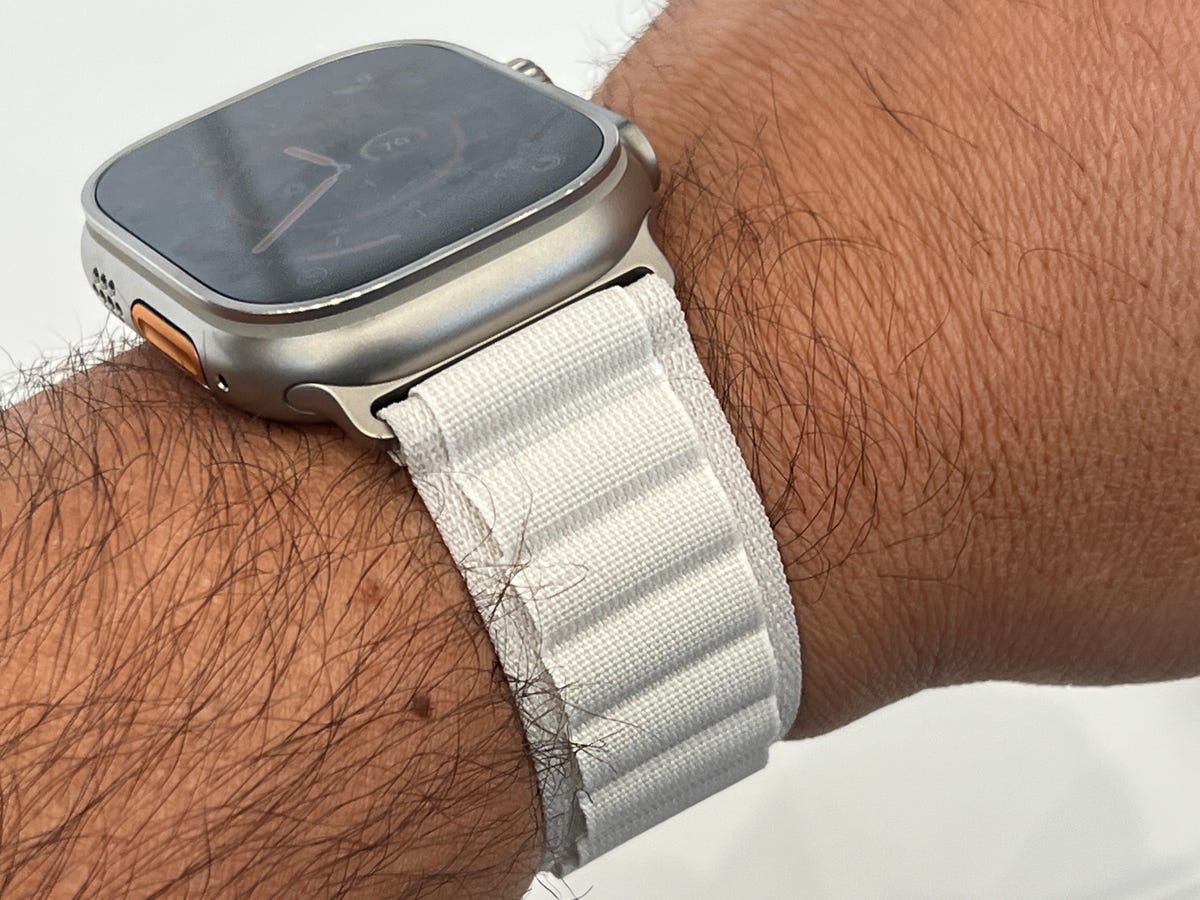

The Alpine Loop on the Ultra.
Scott Stein/CNET
The redesigned Compass app looks extremely fun, especially since it zooms out to different scales and allows waypoints and walk-back directions. The Ultra’s GPS has been enhanced with dual-frequency GPS (L1 and L5), which could make this a lot more accurate than competing GPS smartwatches.
The new Apple Watch Series 8, also announced Wednesday, adds temperature sensing, more advanced motion tracking with car crash detection and a low-power mode that could extend battery life up to 36 hours on standard models. The Ultra will have all these features too.
Who is the Ultra for? It seems like it’s going for the Garmin watch-wearer market — someone who wants a dedicated running watch or a smartwatch that can last (maybe) a whole weekend without a charge.
The new Compass app’s unique Ultra ability to save waypoints and show walk-back directions without a cellular signal, using only GPS, could be one of the Ultra’s biggest draws. So, too, could the watch’s unique ability to work better underwater. The secondary button’s ability to jump to favorite activities without needing the touchscreen could also end up feeling essential for serious runners who would have otherwise considered button-heavy watch alternatives.
The extra cost, however, means it won’t be a watch most people opt for. Still, like the iPhone Pro and iPad Pro, the Watch Ultra’s features could end up being innovations that trickle down to the other Watch models over time.
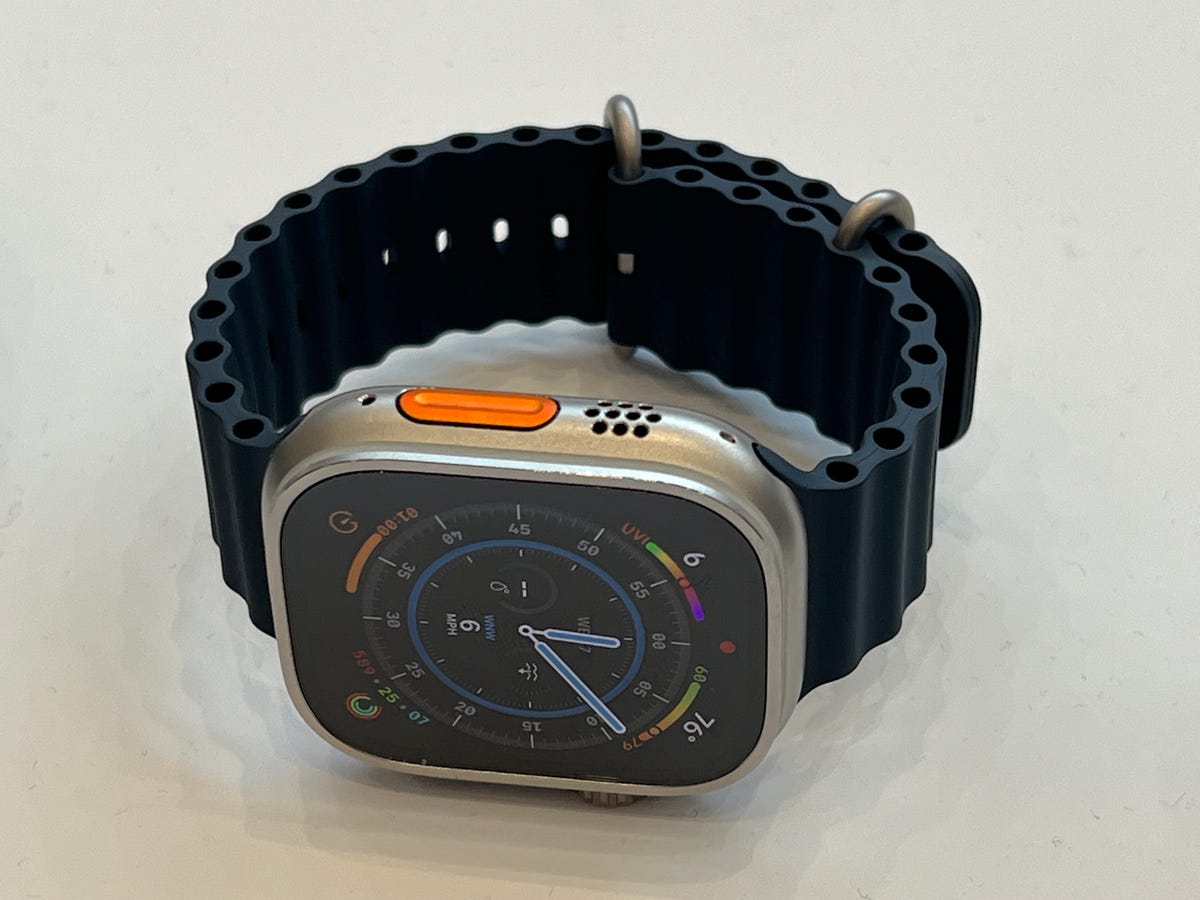

The speakers are louder, and surround a new second programmable button on the other side.
Scott Stein/CNET
The Ultra has some extra safety features, including a loud emergency siren that could be set to alert people if you’re down (which I didn’t test in Apple’s demo room). The water resistance is higher: WR100 and EN13319-certified for scuba diving.
There are some new apps for the Ultra: A new Oceanic Plus diving app is specifically made for the Watch Ultra that looks at tides and water temperature; it also records dive depths and metrics. Apple has its own depth-sensing app. The side button can work underwater to set waypoints, and it’s designed for use while diving too.
I’m not a diver or a hiker, but the battery life of the Ultra is what I’m most envious of. I don’t know how that performs yet, either, but multiday battery life on an Apple Watch is something I’ve wanted for years.
The Apple Watch Ultra isn’t the only device announced at the “Far Out” event. For more, read about everything else Apple unveiled, including the iPhone 14 and AirPods Pro 2.
The post Apple Watch Ultra Hands first appeared on Joggingvideo.com.
]]>The post iPhone 14 Pro’s Most Eye first appeared on Joggingvideo.com.
]]>This story is part of Focal Point iPhone 2022, CNET’s collection of news, tips and advice around Apple’s most popular product.
“Dynamic Island” is the most Apple name of all Apple names. The feature, a part of the upcoming iPhone 14 Pro announced at Apple’s latest product event, was maybe the most surprising feature on Apple’s next phone: The little black oval front-facing camera cut-out has become the unlikely home for an animated series of new notifications that will pop up, and around, where you’d normally be posing for selfies.
I looked at the feature while visiting Apple Park in Cupertino this week, and it filled me with a weird but familiar feeling. I couldn’t pin down exactly where it was coming from, at first. Then, suddenly, it kicked in. And it made me think.
I thought of AR.
Apple’s long-expected AR (and VR) headset didn’t make an appearance at the “Far Out” event, to no surprise. But as the questions inevitably rise about when such a headset could make its debut, so too will the questions about how that headset’s OS will need to feel consistent with Apple’s line of existing products and software.
Is Apple’s next new interface feature, which seems to blend notifications and widgets in an animated blend, the future of phones? Or is it, maybe, the future of Apple’s communication language as the company moves beyond flat screens and into a universe of VR and AR?
The Dynamic Island makes a lot more sense the more I think about it.
Apple’s Newest Releases
- iPhone 14 Pro, Pro Max Review: Welcome to Apple’s Dynamic Island
- iPhone 14 Review: A Good Upgrade for Most People
- Apple Watch Series 8 Review: Improvement By Degrees
- Apple Watch SE Review: Almost Everything I Want
- Apple iOS 16 Released: New iPhone Features From the Update
iPhone 14 Pro
See at Apple

I’ve used the Meta Quest 2 for the last few years, and I’m used to seeing a number of notifications popping up in VR. I get text messages, Slacks from my phone and pings that friends are online. I see messages appear and, sometimes, I can click up and interact with them. Sometimes I can’t.
The future of AR glasses and headsets, according to companies like Meta, is about serving up quick, interactive contextual information. Pop-up bubbles, in a sense. Smart and dynamic notifications. No one’s really nailed this type of interface language for AR yet, because so few AR headsets right now exist, and the ones that do aren’t super-connected with vast mobile ecosystems like phones. It’ll help to have something more than notifications, but less annoying than standard apps and widgets. Something that could start small and suddenly become big.
Is that the Dynamic Island?
I watched as a small phone icon bloomed out to become a Music interface widget. Or an icon showing AirPods being connected. On a phone, these types of features could be fun and useful, but how different would many of them be from the Lock Screen interfaces and widgets that are already on iPhones?
On an AR headset that moves us from our phone screens to a larger, all-surrounding immersive screen, however, an interface like the Dynamic Island could be a way to know when other things are happening. It could also help us jump into tasks without opening up apps or having to invoke little widgets. Notifications would happen and then fade away.
I’m speculating, of course. But Apple’s expected to announce its own AR-VR headset early next year, and Apple’s existing product line will likely be around when that headset arrives. Is Apple going to have a common design language in its future immersive tech? If so, how will it flow?
It makes me wonder more than ever if a little thing like the Dynamic Island is the start of something bigger. Maybe not, but I see a brilliant little interface that could have a more immersive, ambient, cross-device future like the one Apple needs to create for its future headset. The Dynamic Island could be as good a place to start as any.
The post iPhone 14 Pro’s Most Eye first appeared on Joggingvideo.com.
]]>The post Oura Ring 3 at 6 Months: Life With a Wearable That Knows When I’m Sick first appeared on Joggingvideo.com.
]]>
My wedding ring, dull platinum, sits on the ring finger of my left hand. A black ring, titanium, sits on my right. The Oura Ring has been part of my hand for over half a year now — longer if you count the previous version I reviewed. I sleep with it. I shower with it. I don’t think about it much. And sometimes that’s exactly how I like my wearable tech. The Oura ring is a lot of things the Apple Watch isn’t, and also has a few things Apple’s next watch should adopt next.
Then, almost every morning, I check a phone app. It tells me my Readiness Score. It tells me my Sleep Score. I stare at these numbers and a pile of data below and I ask myself, do I feel OK today?
Read more: Best fitness trackers
The Oura ring is a weird wearable. It starts at $300 (roughly £260 or AU$445). It’s truly ambient. It’s invisible, in a sense. I don’t interact with it. It doesn’t have a screen. In a sense it reminds me of wearables from a decade ago, like the silver-disc Misfit Shine. I it doesn’t have a screen or readouts for me to study on the fly, but I still wear a smartwatch. In that sense, the Oura ring is already redundant. But it manages to do something that the Apple Watch, at least, still doesn’t.
Oura Ring Gen3
$300 at Oura

The Apple Watch, and many smartwatches, lean on activity and “ring completion” goals. Walk a certain amount, stand a certain amount, do a certain bunch of stuff. The Oura ring has completion goals, but a lot of its daily metrics are holistic: Does it look like you’re doing OK today? Does that affect how you plan your day? The idea of Readiness Scores are creeping across the smartwatch landscape, but Apple in particular hasn’t adopted them yet.
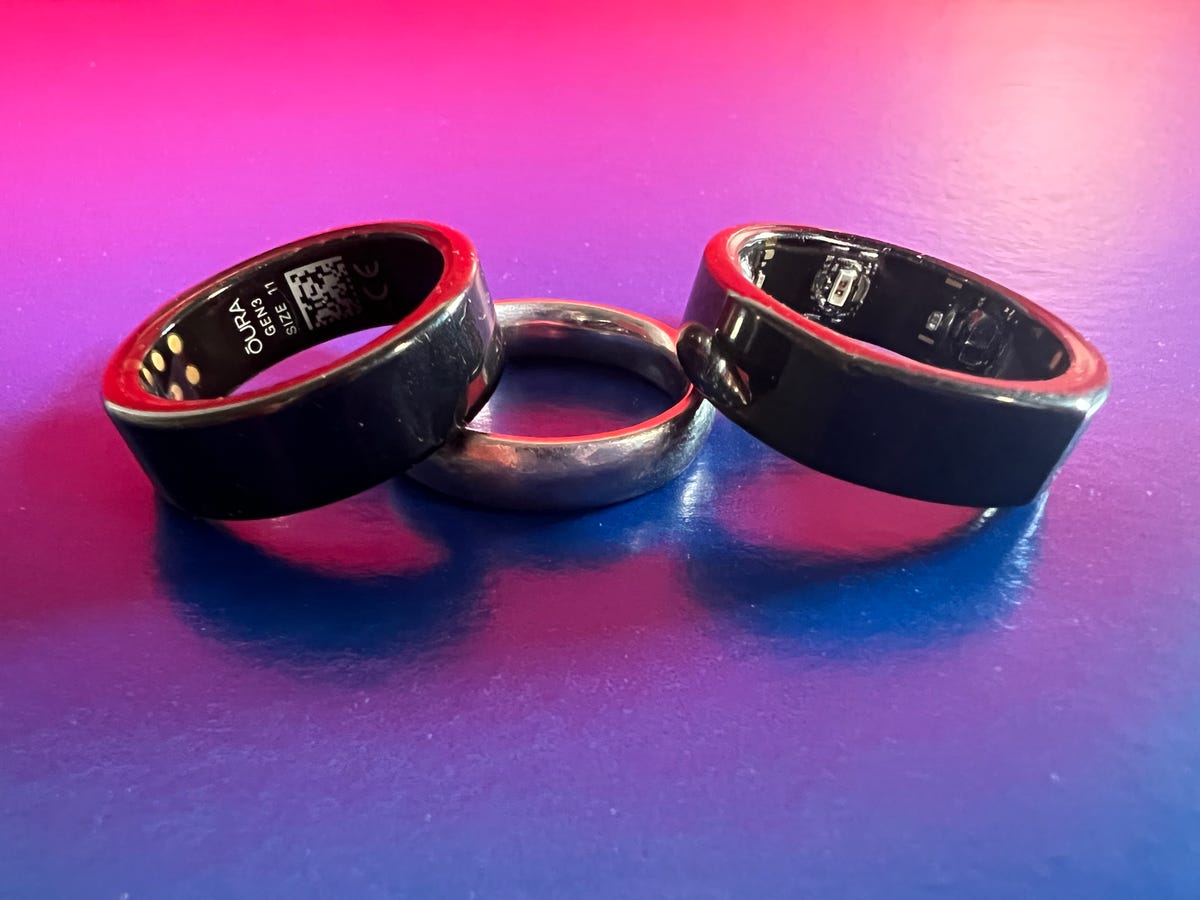

Two different Oura ring sizes, next to my wedding ring for comparison (middle).
Scott Stein/CNET
The Oura ring is proactive, with a readiness score that suggests ways for you to take on the day ahead. The Apple Watch tends to look back at how my day was. Fitbit’s fitness and health metrics have shifted more to the Oura model, and I expect others to as well. Or, at least, to augment the experience with more holistic data. The Oura ring will flag if my temperature seems elevated recently, or my breathing rate changes, or my nightly blood oxygen seems to have shifted or my resting heart rate has been rising or falling. These could mean I’m getting sick. Or maybe I need rest. Or maybe it’s just a false alarm.
Just a few days ago, I got sick with some sort of cold, and a fever. The Oura ring noted my breathing rate increasing overnight, my temperature being higher. It suggested I switch to rest mode for the day. I took a COVID-19 test, but I didn’t need the ring to tell me that. (It was negative.) Still, having an app that’s aware that you might be sick can be useful feedback, and I’ve been noticing which stats change when I’m not feeling well.
In fact, my recent bad cold was a great test of how the Oura 3 worked to track my measurements. I’ve shared what the app showed shortly before, during, and after my bad cold. You can see some of the changes, especially in respiration rate, relative temperature, and resting heart rate.
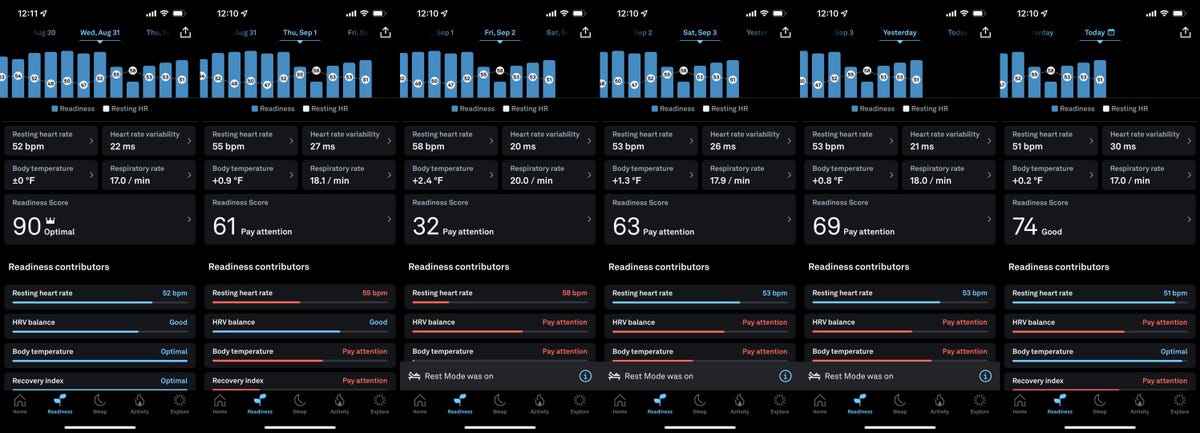

My Readiness Scores in the Oura app, before, during, and after the cold hit.
Scott Stein/CNET
Sleep scores, meanwhile, also showed changes. Sleep tracking with the Oura ring works similarly to other watches and trackers, and over time I have found it correlating pretty well with how rested I felt the next day — of course, I didn’t track this against any more formal sleep measurement system, so it’s completely relative.
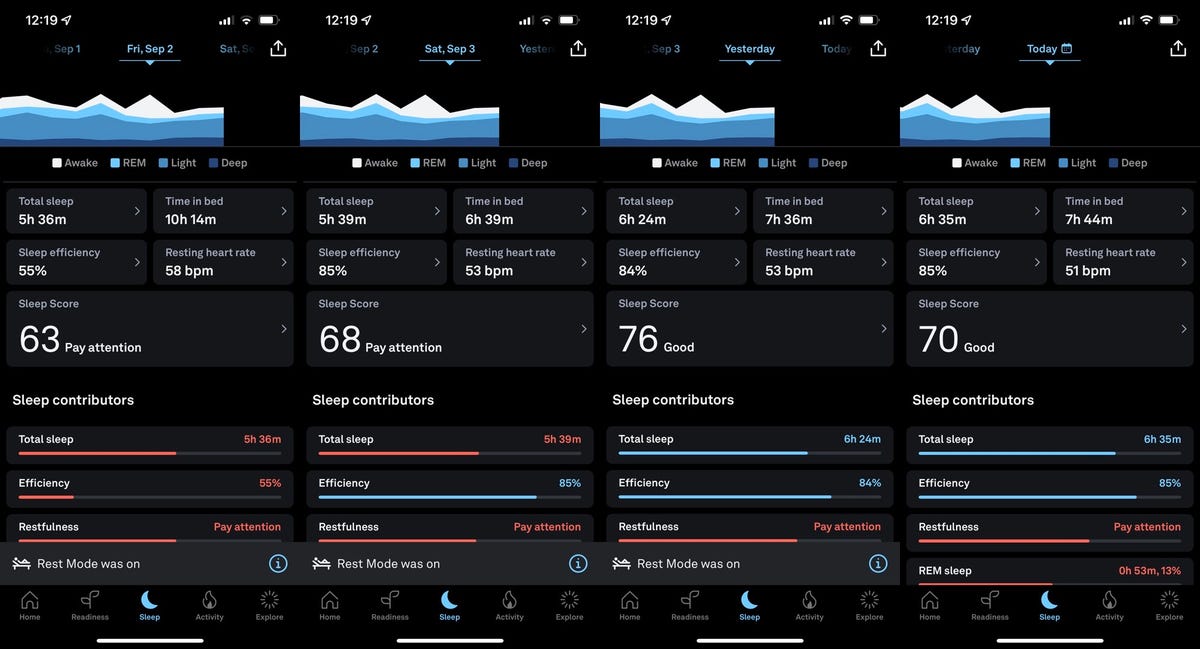

Sleep scores during my few days of having a cold.
Scott Stein/CNET
I waited over half year to review the Oura 3 because, when I first started wearing it last year, nothing much had changed. The ring, which adds extra red and green heart-rate sensing LEDs and an improved skin temperature sensor, promises to have richer data than the previous Oura ring. But at release the Oura 3 otherwise functionally the same as the Oura 2.
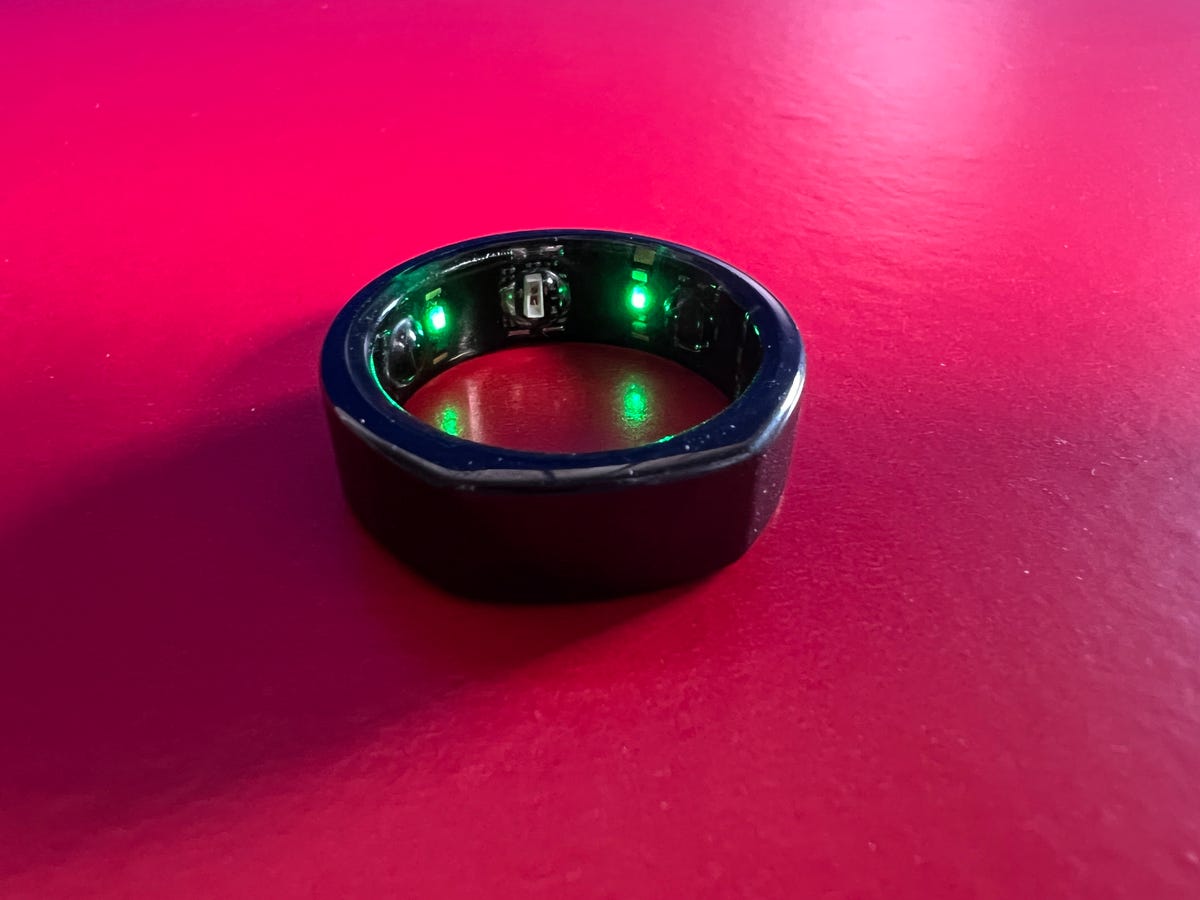

The Oura ring’s optical heart rate sensors are inside. The Gen3 ring has red and green LEDs for better sleep tracking and blood oxygen estimates.
Scott Stein/CNET
Long-promised blood oxygen measurements have finally arrived, thanks to a recent firmware update. These are taken overnight, and show up as a percentage rating the next morning in your overnight sleep data results: I’ve gotten numbers ranging from 97% to 99%.
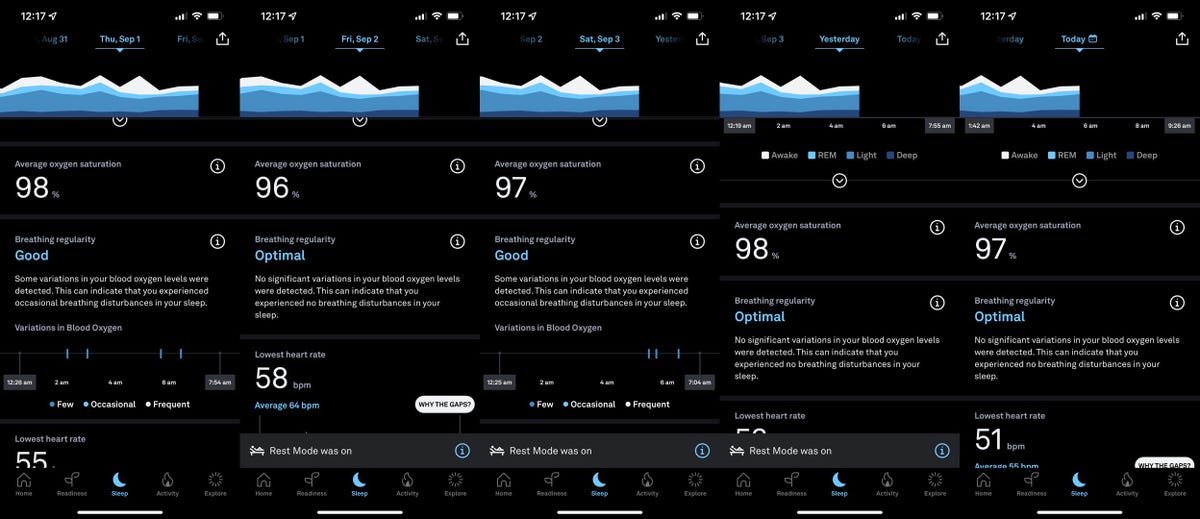

My Oura app’s blood oxygen readings, during my same sick period recently.
Scott Stein/CNET
Another readout estimates how “optimal” your blood oxygen levels were over time, and whether any drops in blood oxygen seemed to have occurred, but it doesn’t get into specifics. Rings and watches can’t be as reliable a source of blood oxygen information as finger-worn pulse oximeters, although Oura believes its ring can come close. Over the last handful of weeks, my readings have largely seemed fine. I’m not sure I trust it, though.
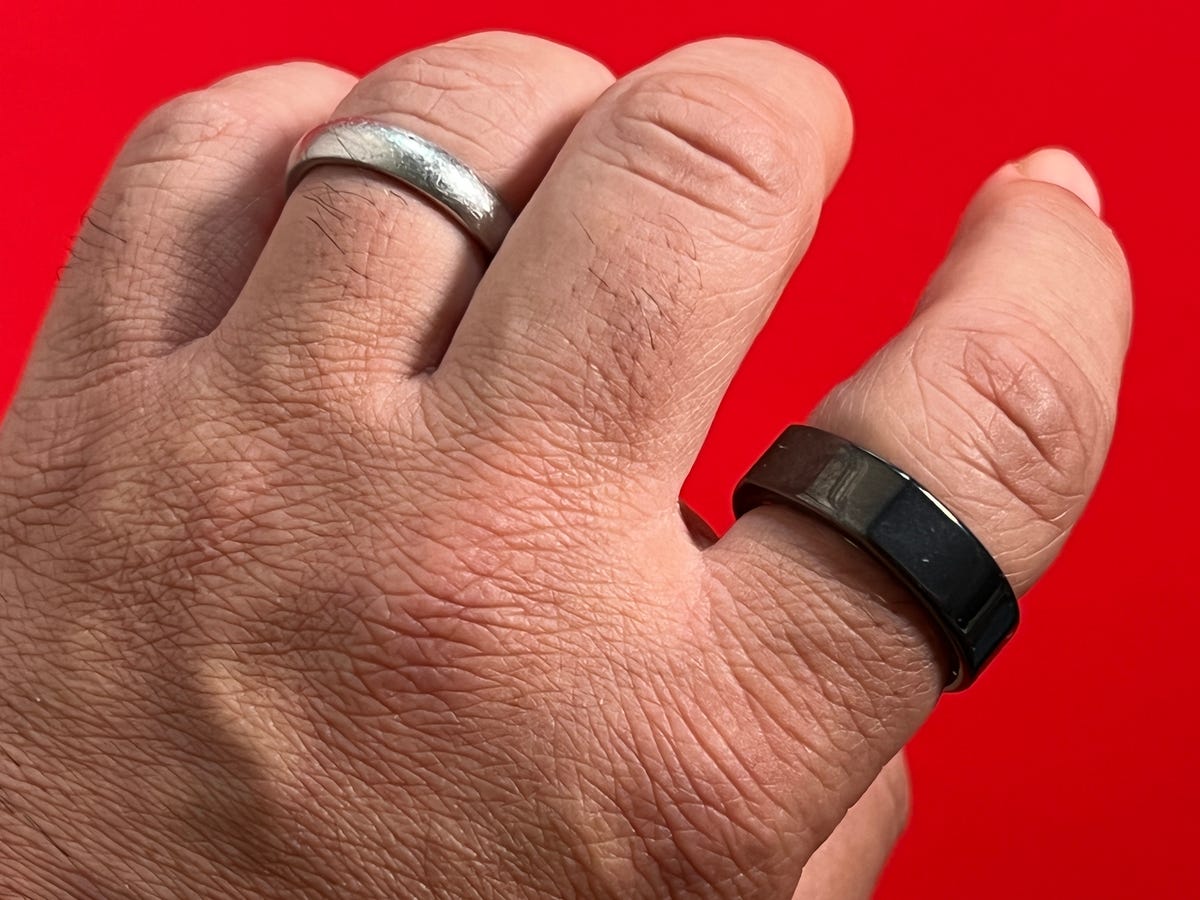

The preferred way to wear the Oura 3, on my index finger. Super weird. (Wedding ring on ring finger for comparison). I swapped to a ring finger size since and it seems fine.
Scott Stein/CNET
Oura’s third-gen ring is apparently most effective when worn on the index finger, which is a weird proposition: It makes me look like a street magician. I’ve worn one on my ring finger, instead, and seem to be getting results that are fine. Unlike a smartwatch, the Oura ring has to be sized to your finger, which means picking which finger you’d prefer and sticking with it. I exchanged the first ring I wore on my index finger for a ring finger-sized one. It’s also worth noting that your ring size may change over time if you’re gaining or losing weight, working out or due to humidity (mine does). Rings can’t be adjusted as easily as watches can, and rings can sometimes get in the way of certain fitness and sports activities. The Oura Gen 3 ring can track heart rate during active workouts, but it’s not nearly as comfortable to use as a watch… and you can’t glance at your live readings on the ring.
The ring’s battery life seems to last around four days, which is great but it’s also tricky. I prefer multiday battery life to daily-charge devices like the Apple Watch, but when you’re out of a daily charge habit, figuring out when to charge becomes a challenge. The Oura ring still has no low-battery reminder other than an app notification that can pop up (and get lost) on your phone. I find the ring can go dead for a few days and I won’t even notice. I wish there were some sort of small battery indicator light on the ring.
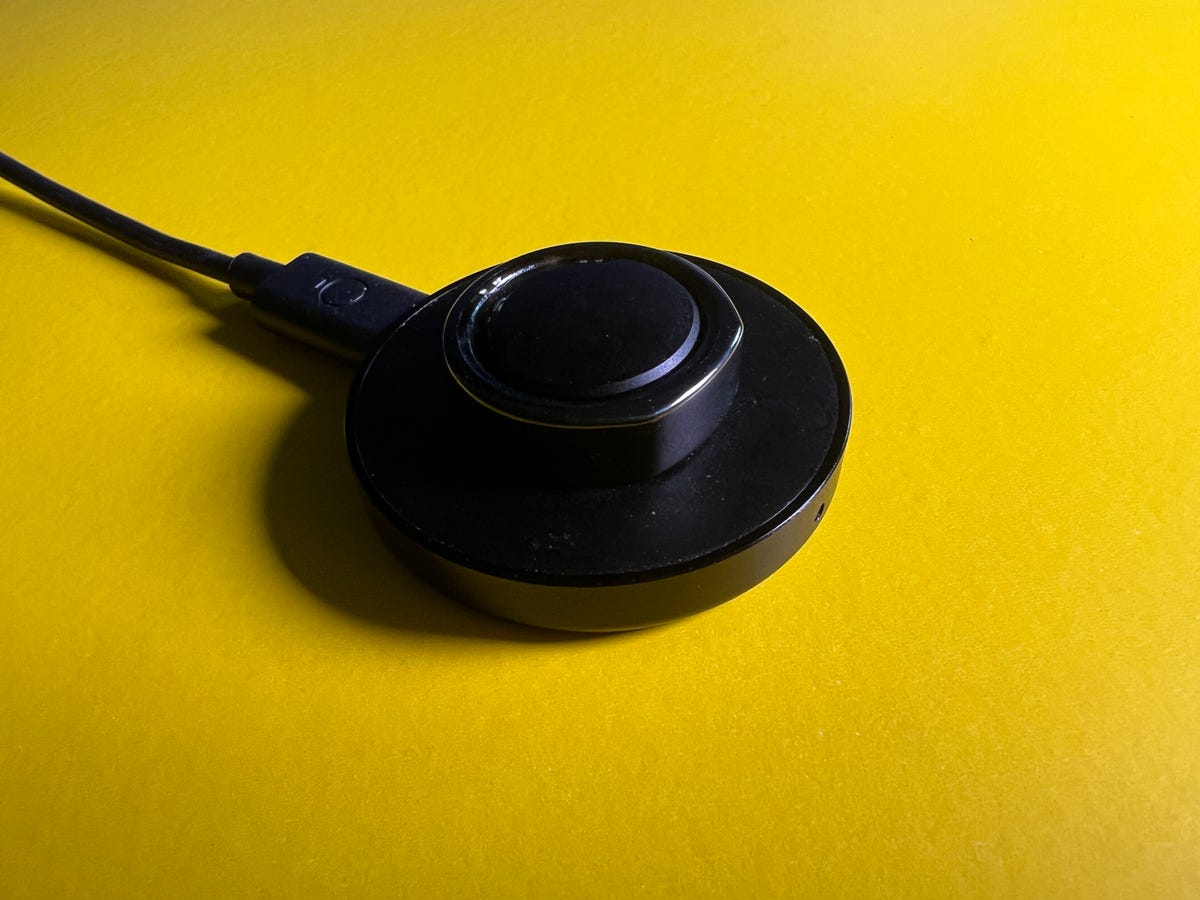

The Oura ring charger. It’s USB-C compatible, but you need that contactless base to charge up.
Scott Stein/CNET
The other thing to know about Oura’s ring is that it needs an extra subscription. Oura’s subscription fee is $6 a month, on top of $300 or $400 for the ring, depending on whether you’re getting it in the less expensive silver or black, or step-up matte black Stealth or gold finishes. Paying $300 for a ring feels like a lot considering you can get a full-featured smartwatch at the same price. But it’s the subscription creep I don’t like, even though original Oura ring owners can get the ring upgrade subscription-free, and the ring comes with six months of the subscription for free. Fitbit already has a close-to-essential Premium service for its trackers and watches, and Apple leans on its Fitness Plus service. Amazon has a similar model for its Halo health trackers. This might be the future of wearables. Fitbit’s watches and services also mirror Oura’s: You can get a similar experience, especially if you’re wearing a temperature-monitoring Fitbit Sense.
I love the daily sleep and wellness scanning of Oura’s ring, because it’s exactly the type of analysis that’s missing from the Apple Watch. But that might be changing soon, as Apple’s expected next-gen watch possibly adds longer battery life and temperature sensing, too. Fitbit’s new Sense watch and Samsung’s latest Galaxy watches are moving in similar directions. Oura feels like a predictor of wearable tech’s future, but like many first movers, it may not always be where people end up.
The post Oura Ring 3 at 6 Months: Life With a Wearable That Knows When I’m Sick first appeared on Joggingvideo.com.
]]>The post Meta’s Future Quest VR Headsets Will Use Custom Qualcomm Chips for Years first appeared on Joggingvideo.com.
]]>
We don’t know a ton of details about Meta’s next VR headset, expected this October, but we do know it’ll feature a Qualcomm chip inside… and so will the company’s headsets for years down the road.
Qualcomm CEO Cristiano Amon and Meta CEO Mark Zuckerberg announced the news during a press conference at Berlin’s IFA tech show. Qualcomm’s already made the chips in Meta’s VR headsets going back to the Oculus Go, and announced a partnership with Microsoft to make next-gen chips for its future AR smart glasses January’s CES in Las Vegas.


Now playing:
Watch this:
Qualcomm and Meta Announce Snapdragon XR and Metaverse…
4:48
The Qualcomm partnership promises “multiple generations of premium devices and experiences powered by custom VR platforms in the years to come,” according to a statement from Qualcomm.
In a comment from Mark Zuckerberg provided by Qualcomm, the partnership will bring “customized virtual reality chipsets — powered by Snapdragon XR platforms and technology — for our future roadmap of Quest products.”
When asked for further comment on the partnership via email, a Qualcomm representative clarified that the new customized chips will be powered by Qualcomm’s Snapdragon XR platform, but won’t use Snapdragon Spaces, an AR software toolkit that Qualcomm’s building to bridge phones and AR glasses. Instead, these future products will use Meta’s Presence Platform for VR.
According to Qualcomm, the chips could show up in other, non-Meta devices, too. “The VR chipsets that are being designed as part of this collaboration are not exclusive to Meta, but we’re excited to work together on a deeper engineering level that’s a first for both companies. It’s this type of collaboration that’s foundational for the metaverse and we can’t wait to show you what we’ll build together.”
Although Meta is working on future AR glasses of its own, Qualcomm hasn’t confirmed any involvement in that part of Meta’s metaverse roadmap: “At this time, we are strictly only talking about VR.”
The post Meta’s Future Quest VR Headsets Will Use Custom Qualcomm Chips for Years first appeared on Joggingvideo.com.
]]>The post Apple AR, VR Headset Expectations: When Will It Show Up? first appeared on Joggingvideo.com.
]]>
Apple has been integrating augmented reality into its devices for years, but the company’s next big product looks like it’ll be leaping right into the territory of Meta, Microsoft, Magic Leap and others, with a long-expected mixed-reality headset likely arriving within the next year. The target date of this headset has kept sliding, and we’re now at the point where every Apple event seems to feel like the one where it could be mentioned at last.
We expected to see big VR headsets launch this year, but only Meta’s next VR headset looks like it will show up in 2022. The PlayStation VR 2 has been delayed until 2023 and Apple’s headset looks like it could be following the same release window. Apple didn’t mention a headset in its most recent developer conference, but there were plenty of AR clues hinting at what the future could hold.
Apple’s “Far Out” September product event is approaching soon, where new iPhones, Apple Watches and AirPods are expected. Apple’s headset probably won’t emerge now: The latest reports say a possible January or early 2023 event could be the moment.
Here’s what we’re expecting to see.
Is its name Reality Pro?
New trademark filings reported by Bloomberg show the name “Reality” showing up a lot: Reality One, Reality Pro and Reality Processor. Apple’s existing AR software framework for iOS is named RealityKit, and previous reports suggested that a “Reality OS” could be the name for the new headset’s ecosystem.
No one really expected the Apple Watch’s name (remember iWatch?), so to some degree, names don’t matter. But it does indicate that Apple is moving forward towards a product, possibly imminently.
A long-expected headset
The headset has been cooking for a long while. Reports have been going around for several years, including a story broken by former CNET Managing Editor Shara Tibken in 2018. Apple’s been building more advanced AR tools into its iPhones and iPads for years, setting the stage for something more.
Whatever the headset might become, it’s looking a lot more real lately. A detailed report from The Information earlier this year discussed likely specs, which include what Bloomberg’s Mark Gurman says is Apple’s latest M2 chip. According to another report from Bloomberg earlier this year, Apple’s board of directors have finally seen a demonstration of a mixed-reality headset.
This could indicate that the long-rumored headset is nearing completion. Kuo previously predicted that Apple’s VR-AR headset would arrive in the fourth quarter of 2022 with Wi-Fi 6 and 6E support. While that date looks like it’s slipped to 2023, Kuo has also predicted that Apple smart glasses may arrive in 2025 and maybe AR contact lenses after that.
Apple could blend AR and VR with two headsets in the near future, leading the way with a high-end AR-VR headset that may be more like an advanced Quest 2, according to Bloomberg’s Gurman. Gurman also suggests a focus on gaming, media and communication. In terms of communication, Gurman believes FaceTime using the rumored headset could rely on Memoji and SharePlay: Instead of seeing the person you’re talking to, you’d see a 3D version of their personalized Memoji avatar.
And Apple may have large plans for the headset. The company’s “goal is to replace the iPhone with AR in 10 years,” Kuo explains in a note to investors, seen by MacRumors. The device could be relatively lightweight, about 300 to 400 grams (roughly 10.5 to 14 ounces), according to Kuo. That’s lighter than Meta’s Oculus Quest 2.
Read more: The Metaverse is Just Getting Started: Here’s What You Need to Know
The headset could be expensive, maybe as much as $2,000 or more, with 8K displays, eye tracking and cameras that can scan the world and blend AR and VR together, according to a report from The Information last year.
It’s expected to feature advanced processors, possibly based on Apple’s recent M2 chips, and work as a stand-alone device. But it could also connect with Apple’s other devices. That’s not a surprising move. In fact, most of the reports on Apple’s headset seem to line right up with how VR is evolving: lighter-weight, with added mixed reality features via more advanced passthrough cameras. In that sense, Apple’s first headset will probably be a stepping stone to future lighter AR glasses, in the same way that Meta’s next headset, called Project Cambria, might be used.
Previous reports on Apple’s AR/VR roadmap suggested internal disagreements, or a split strategy that could mean a VR headset first, and more normal-looking augmented reality smart glasses later. But recent reports seem to be settling down to tell the story of a particular type of advanced VR product leading the way. What’s increasingly clear is that the rest of the AR and VR landscape is facing a slower-than-expected road to AR glasses, too.


Now playing:
Watch this:
What Apple’s expensive 8K VR headset could be like
14:56
VR, however, is a more easily reachable goal in the short term.
Apple has been in the wings all this time without any headset at all, although the company’s aspirations in AR have been clear and well-telegraphed on iPhones and iPads for years. Each year, Apple’s made significant strides on iOS with its AR tools. It’s been debated how soon this hardware will emerge: this year, the year after or even further down the road. Or whether Apple proceeds with just glasses, or with a mixed-reality VR and AR headset, too.
I’ve worn more AR and VR headsets than I can even recall, and been tracking the whole landscape for years. In a lot of ways, a future Apple AR headset’s logical flight path should be clear from just studying the pieces already laid out. Apple acquired VR media-streaming company NextVR in 2020 and it bought AR headset lens-maker Akonia Holographics in 2018.
I’ve had my own thoughts on what the long-rumored headset might be, and so far, the reports feel well-aligned to be just that. Much like the Apple Watch, which emerged among many other smartwatches and had a lot of features I’d seen in other forms before, Apple’s glasses probably won’t be a massive surprise if you’ve been paying attention to the AR and VR landscape lately.
Remember Google Glass? How about Snapchat’s Spectacles? Or the HoloLens or Magic Leap? Meta is working on AR glasses too, and Snap and also Niantic. The landscape got crowded fast.
Here’s where Apple is likely to go based on what’s been reported, and how the company could avoid the pitfalls of those earlier platforms.
Apple declined to comment on this story.
Launch date: Look for news well before the product release date
New Apple products tend to be announced months before they arrive, maybe even earlier. The iPhone, Apple Watch, HomePod and iPad all followed this path.
In addition to Kuo’s tweets that the headset could arrive in 2023, a 2019 report from The Information based on purported leaked Apple presentational material, suggested 2022 could be the year for an Oculus Quest-like AR-VR headset and 2023 for glasses based on purported Apple presentational material. Maybe Apple will take a staggered strategy with AR and release several devices: one for creators first, with a higher price; and one for everyday wearers later. TrendForce doubts any AR or VR headset could overtake Microsoft’s or Meta’s until 2023 or later.
Either way, developers would need a long head start to get used to developing for Apple’s headset, and making apps work and flow with whatever Apple’s design guidance will be. That’s going to require Apple giving a heads-up on its hardware well in advance of its actual arrival.
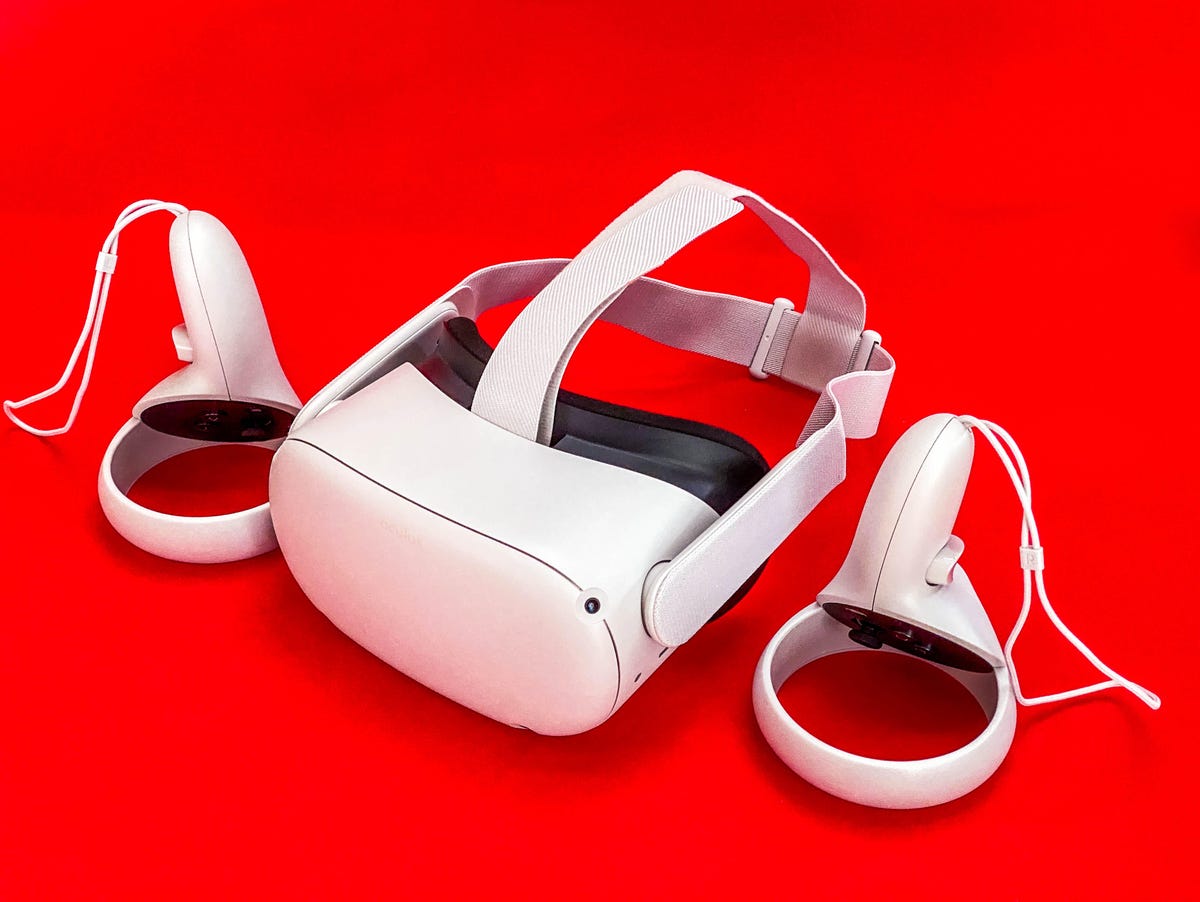

Facebook’s Oculus Quest 2 is a self-contained VR headset on the road to AR glasses. Could Apple follow a similar path?
Scott Stein/CNET
An Apple headset could be a lot like the Meta Quest, but higher-end
There’s already one well-polished success story in VR, and the Quest 2 looks to be as good a model as any for where future headsets could aim. Gurman’s report makes a potential Apple VR headset sound a lot like Facebook’s stand-alone device, with controller-free hand tracking and spatial room awareness that could be achieved with Apple’s lidar sensor technology, introduced on the iPad Pro and iPhone 12 Pro.
Apple’s headset could end up serving a more limited professional or creator crowd. But it could also go for a mainstream focus on gaming or fitness. My experiences with the Oculus Quest’s fitness tools feel like a natural direction for Apple to head in, now that the Apple Watch is extending to subscription fitness training, pairing with TVs and other devices.
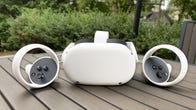

Now playing:
Watch this:
Meta Quest 2 Is Better and Cheaper… With One Facebook…
8:56
The Oculus Quest 2 (now officially the Meta Quest 2) can see through to the real world and extend some level of overlap of virtual objects like room boundaries, but Apple’s headset could explore passthrough augmented reality to a greater degree. I’ve seen impressive examples of this in headsets from companies such as Varjo. It could be a stepping stone for Apple to develop 3D augmented reality tech on smaller glasses designs down the road.
Right now, there aren’t any smart glasses manufacturers able to develop normal-looking glasses that can achieve advanced, spatially aware 3D overlays of holographic objects. Some devices like the nReal Light have tried, with mixed success. Meta’s first smart glasses, Ray-Ban Stories, weren’t AR at all. Meta is working on ways to achieve that tech later on. Apple might take a similar approach with glasses, too.
The VR headset may be a ‘Pro’ device
Most existing reports suggest Apple’s VR headset would likely be so expensive, and powerful, that it will have to aim for a limited crowd rather than the mainstream. If so, it could target the same business and creative professionals that more advanced VR headsets like the Varjo XR-3 are already aiming for.
I tried Varjo’s hardware: My experience with it could hint at what Apple’s headset might also aim for. It has a much higher-resolution display (which Apple is apparently going to try to achieve), can blend AR and VR into mixed reality using its passthrough cameras, and is designed for pro-level creative tools. Apple could integrate something similar to its lidar sensors.
But Varjo’s headset, and most professional VR headsets, are tethered to PCs with a number of cables. Apple’s headset could work as a stand-alone device, like the Quest 2, work on its own and also when connected to a Mac, much like the Quest 2 already does. Apple’s advantage could be making a pro headset that is a lot more lightweight and seamlessly standalone than any other current PC-ready gear. But what remains unknown is how many apps and tools Apple will be able to introduce to make its headset feel like a tool that’s truly useful for creators.
Controls: Hand tracking or a small worn device?
The Information’s previous reports on Apple’s headset suggest a more pared-down control system than the elaborate and large game controller-like peripherals used by many VR headsets right now. Apple’s headset should work using hand tracking, much like many VR and AR headsets already enable. But Apple would likely need some sort of controller-type accessory for inputs, too. Cracking the control and input challenge seems to be one of the bigger hurdles Apple could face.
Could that controller be an Apple Watch? Possibly, but the Apple Watch’s motion-control capabilities and touchscreen may not be enough for the deeper interactions an Apple headset would need. Maybe iPhones could pair and be used as controllers, too. That’s how Qualcomm is envisioning its next wave of phone-connected glasses.
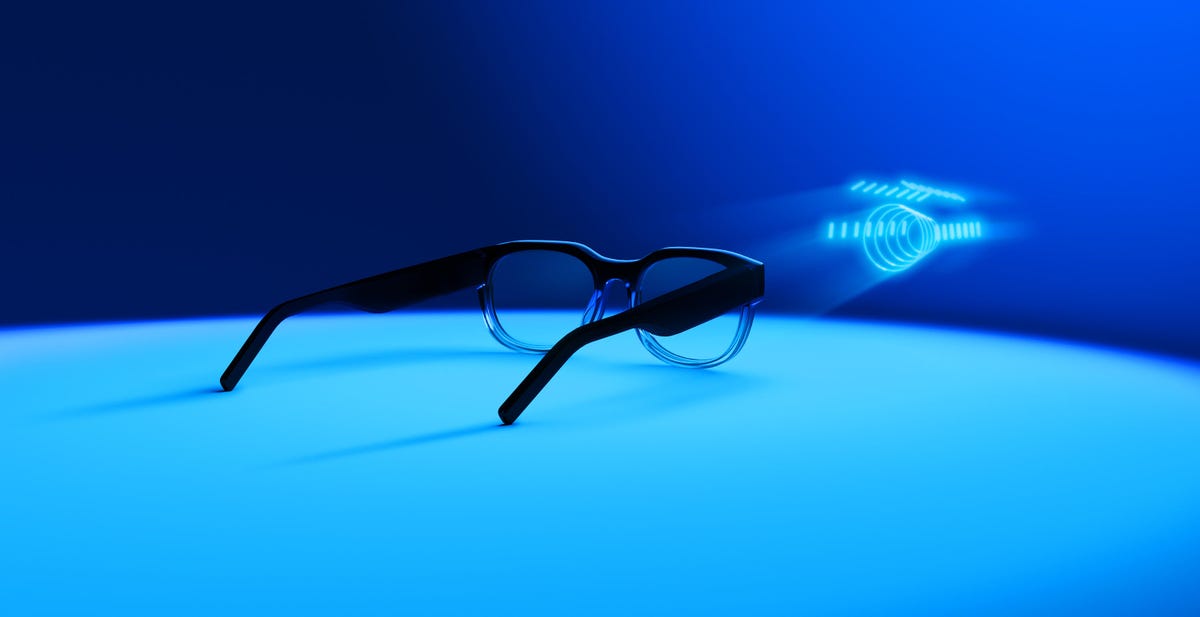

North Focals’ smart glasses design prototype. North was acquired by Google in 2020.
North
Future AR smart glasses may also be in the works
Getting people to put on an AR headset is hard. I’ve found it a struggle to remember to pack smart glasses, and find room to carry them. Most of them don’t support my prescription, either. Developer-focused AR glasses made by Snap that I tried recently show what everyday AR glasses could look like someday, but they’re still a work in progress.
Kuo’s prediction of AR glasses coming a few years after a VR-AR goggle-type headset would line up with what other companies are promising. The challenges with AR glasses are a lot greater than VR. No one’s figured out how wearing them all the time would work, or how you’d interact with virtual objects: Hand tracking? A watch or a ring? Voice? Neural inputs?
Apple always touted the Apple Watch, first and foremost, as a “great watch.” I would expect the same from its glasses. If Apple makes prescription glasses and makes them available, Warby Parker-style, in seasonal frames from its Apple Stores, that might be enough for people if the frames look good. Apple’s VR headset, according to Gurman, will also offer prescription lenses. That could be a stepping stone to developing glasses later on.
Google acquired smart glasses manufacturer North in 2020, which made a prescription, almost normal set of eyewear. North’s concept for glasses might be too similar to Google Glass for Apple’s tastes, but the idea of AR glasses doubling as functional glasses sounds extremely Apple-like. More recently, Vuzix’s planned smart glasses for 2021 show how far the tech has shrunken down, but even those planned glasses won’t have the ability to spatially scan the world and overlay augmented reality: They’ll be more like advanced glasses with heads-up displays and 3D audio.
A report from The Information in 2020 said new AR lenses were entering a trial production phase for Apple’s AR hardware (9to5Mac also broke the report down). These lenses sound much closer to normal glasses than current AR headsets allow, but when would those be ready?
Could Apple make its first smart glasses something more basic, letting Apple slowly add more AR features over time and let newcomers settle into the experience? Or would Apple try to crack the AR challenge with its first pair of glasses? Augmented reality is a weird concept for eyewear, and potentially off-putting. Maybe Apple will aim for subtlety. The original Apple Watch was designed to be glanced at for just 5 seconds at a time.
A recent patent filing also showed Apple looking to solve vision conditions with adaptive lenses. If true, this could be the biggest killer app of Apple’s intelligent eyewear.
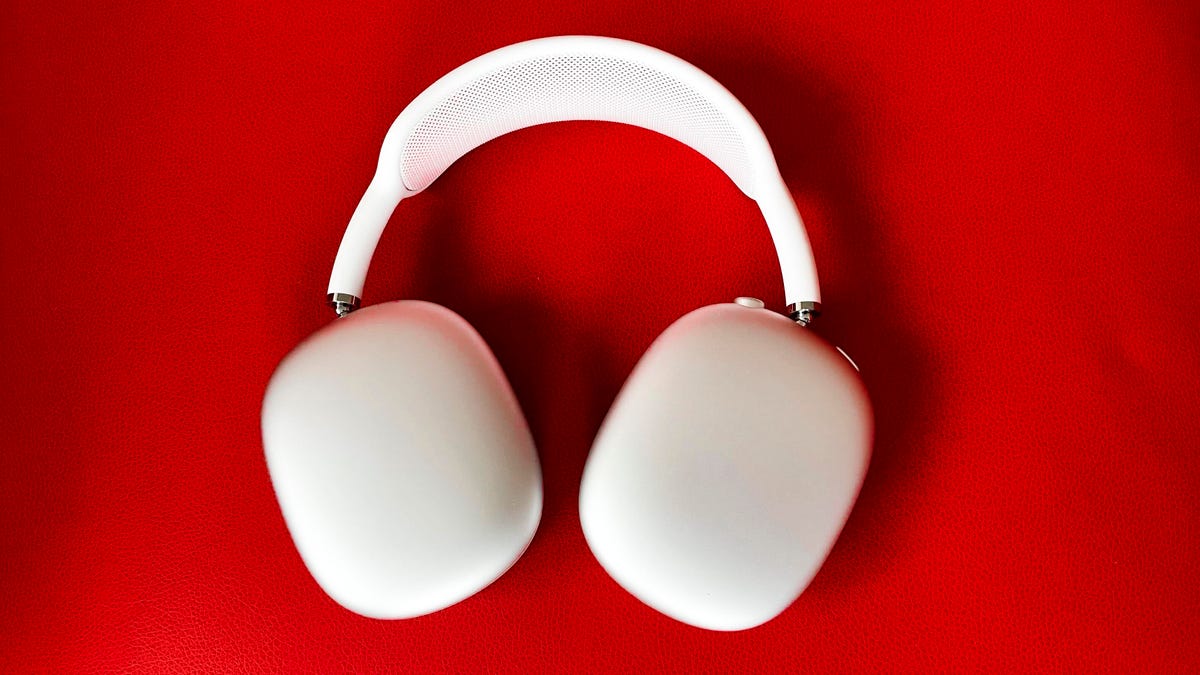

David Carnoy/CNET
Are the AirPods Max a sign of how expensive a headset could be?
The business-focused HoloLens and Magic Leap cost thousands of dollars. Current VR headsets have trended towards $500 or more.
The latest price reports suggest something between $2,000-$3000, which is in the territory of business-focused AR headsets like the HoloLens 2, or business creative VR headsets like those from Varjo. An analysis from TrendForce published in February also estimates that an Apple headset’s hardware would cost in the thousands, and it predicts that Apple would employ a “monthly subscription-based software solution.”
Apple’s headphones, the AirPods Max, indicate that the pricing could climb high. At $549, they cost more than a PlayStation 5. And those are just headphones. A pair of smart glasses, or an advanced VR headset, would be a lot more advanced.
iPhone-connected, too?
Qualcomm’s AR and VR plans in 2020 telegraphed the next wave of headsets: Many of them will be driven by phones. Phone-powered glasses can be lighter and just have key onboard cameras and sensors to measure movement and capture information. Meanwhile the phone does the heavy lifting and doesn’t drain headset battery life.
Apple’s star device is the iPhone, and it’s already loaded with advanced chipsets that can do tons of AR and computer vision computation. It could already power an AR headset now; imagine what could happen in another year or two.
Apple could also have its own high-end dedicated chip in its first wave of VR and AR headsets, as reports suggest, but they’ll also undoubtedly dovetail with more advanced processors in Apple’s phones, tablets and Macs.
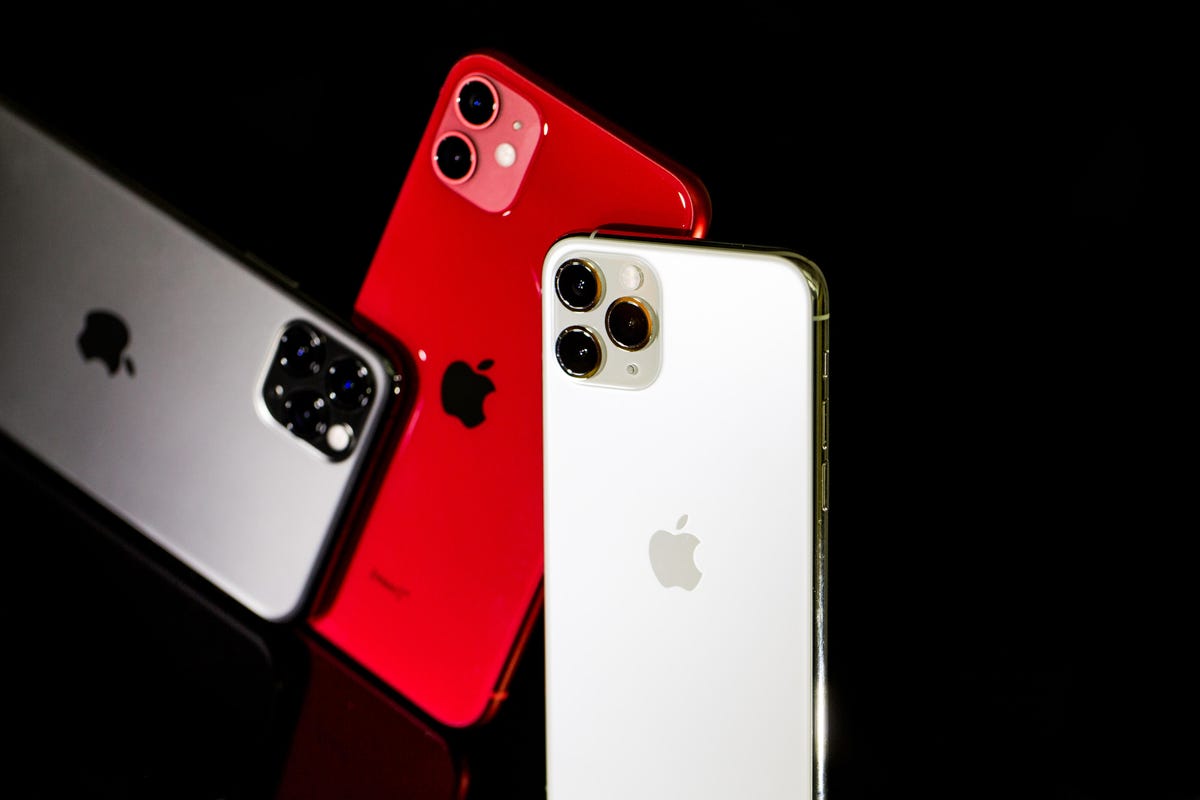

Apple’s iPhones are likely to be the engine.
Angela Lang/CNET
How Apple could blend the real world with AR and VR
Apple already dabbles with AR overlays with real world locations: QR code and NFC-enabled App Clips can launch experiences from real-world locations with a tap or scan. These micro apps are made to work with AR, too: With glasses or an AR headset, they could eventually launch interactions at a glance.
Maybe QR codes can help accelerate AR working in the “dumb” world. Apple’s iPhones also have a U1 chip that can be used to improve accuracy in AR object placement, and also to more quickly locate other Apple devices that have the U1 chip, too.
Apple’s AirTags arrived in 2021 with features similar to Samsung’s SmartTags Plus that use similar ultrawideband technology. These tags could be seen via an iPhone app using AR, which could possibly extend into Apple’s future VR or AR headsets. If all Apple’s objects recognize each other, they could act as beacons in a home. The U1 chips could also be indoor navigation tools for added precision.
Microsoft’s collaborative mixed-reality platform, Mesh, shows how meetings with people in virtual spaces could happen instantly and in work-like environments. Apple already enables multiperson AR in real places, but a necessary next step would be to allow a platform for collaboration in AR and VR like Microsoft is developing.
Trying some of the LiDAR-enabled AR apps I can find for the 2020 iPad Pro, to show meshing. Here’s one called Primer, an early build to test wallpaper on walls pic.twitter.com/SatibguyTm
— Scott Stein (@jetscott) April 14, 2020
Apple’s depth-sensing hardware is already here
Apple is already deeply invested in camera arrays that can sense the world from short and long distances. The front-facing TrueDepth camera, which Apple has used on every Face ID iPhone since the X, is like a shrunken-down Microsoft Kinect and can scan a few feet out, sensing 3D information with high enough accuracy to be used for a secure face scan. Apple’s lidar technology on its recent iPhones and iPads can scan out much further, several meters away. That’s the range that glasses would need.
Apple’s existing lidar technology, combined with cameras, is already good enough to scan environments and 3D objects. Add to this the wider-scale lidar scanning Apple is doing in Maps to enable overlays of real-world locations with virtual objects via a technology called Location Anchors, and suddenly it seems like the depth-scanning Apple is introducing could expand to worldwide ambitions.
Apple’s new Mac chips already point toward VR-AR compatibility
Apple’s M1-enabled Macs and onward are technically a lot more capable of the power needed to run AR and VR, and share similarities to how iPhone and iPads handle graphics. Developing a common groundwork across devices could allow a headset to feasibly run on an iPhone, iPad or Mac, making it a universal Apple device accessory.
That would be essential if Apple intends on its VR or AR headsets to have any role in creative workflows, or be used for games or apps. It’s one of the limitations of existing VR headsets, which need to run off particular Windows gaming PCs, and still don’t play that well with iOS or Android phones.


AirPods went from absurd to essential. Can Apple do the same for smart glasses?
Sarah Tew/CNET
Look to AirPods for ease of use — and audio augmented reality
I’ve thought about how the AirPods’ comfort, and weird design, was an early experiment in wearing Apple’s hardware directly on our faces — and it was a success. It proved that doing so could be accepted and become normal. AirPods are expensive compared to in-box wired buds, but they’re also utilitarian. They’re relaxed. If Apple’s working on AR or VR headsets, they’ll need to feel the same way.
The AirPod Pros’ spatial audio, which AirPods Max and AirPods 3 also have, points to where future ideas could head. Immersive audio is casual, and we do it all the time. Immersive video is hard and not always needed. I could see AR working as an audio-first approach, like a ping. Apple glasses could potentially do the world-scanning spatial awareness that would allow the spatial audio to work. In the meantime, Apple’s already developing the spatial audio tech that its VR headset would need.
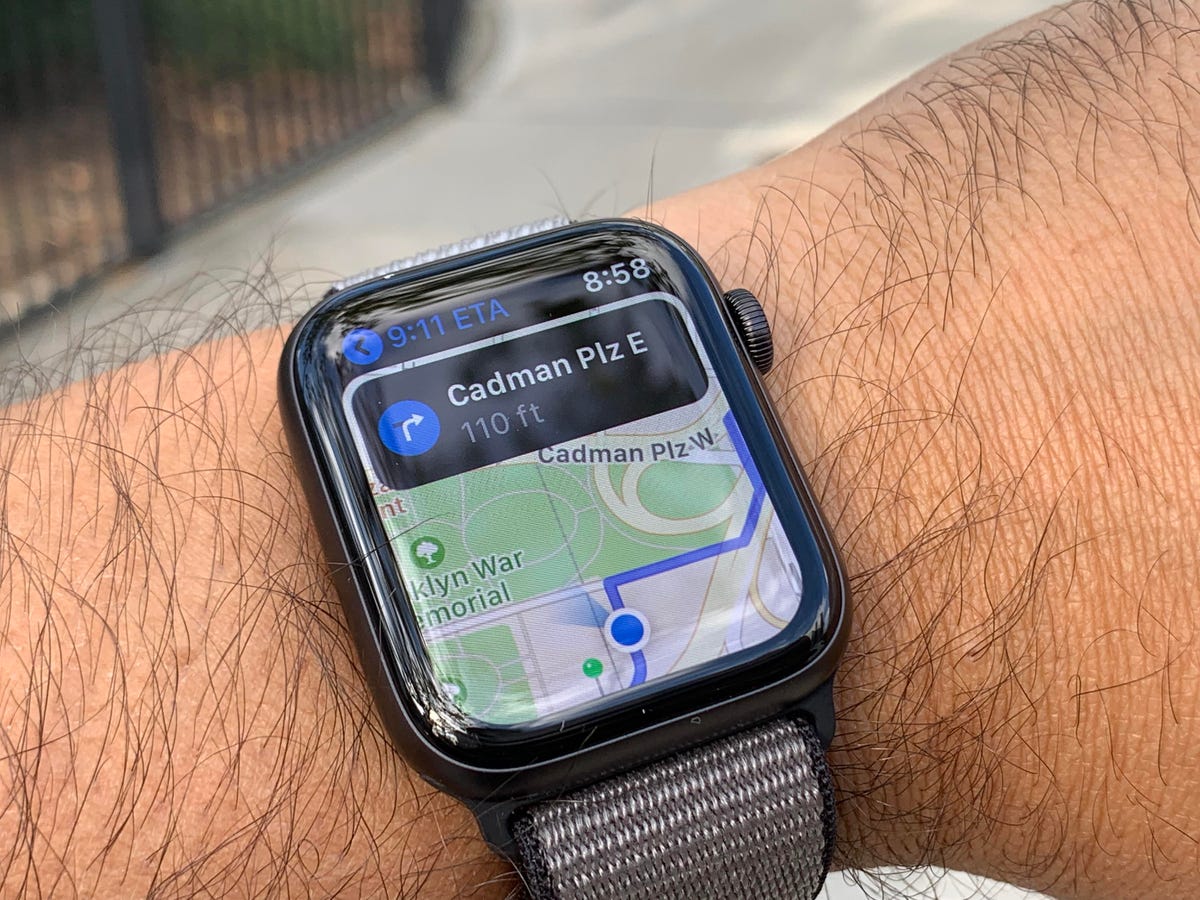

Somehow, the watch and the glasses need to work together for navigation and other apps.
Scott Stein/CNET
Apple Watch and AirPods could be great companions
Apple’s already got a collection of wearable devices that connect with the iPhone, and both make sense with glasses. Its AirPods can pair for audio (although maybe the glasses have their own Bose Frames-like audio, too), while the Watch could be a helpful remote control. The Apple Watch already acts as a remote at times, for the Apple TV or for linking up with the iPhone camera. Apple’s future headsets could also look to the Watch and expand its display virtually, offering enhanced extras that show up discreetly, like a halo. Or they could use the Watch as some sort of controller.
The Apple Watch could also provide something that it’ll be hard to get from hand gestures or touch-sensitive frames on a pair of glasses: haptics. The rumbling feedback on the Watch could lend some tactile response to virtual things, possibly.
Could Qualcomm and Apple’s reconciliation also be about XR?
Qualcomm and Apple are working together again on future iPhones, and I don’t think it’s just about modems. 5G is a key feature for phones, no doubt. But it’s also a killer element for next-gen AR and VR. Qualcomm has already been exploring how remote rendering could allow 5G-enabled phones and connected glasses to link up to streaming content and cloud-connected location data. Glasses could eventually stand on their own and use 5G to do advanced computing, in a way like the Apple Watch eventually working over cellular.
Qualcomm’s chipsets are in almost every self-contained AR and VR headset I can think of (Meta Quest, HoloLens 2, a wave of new smart glasses, the latest version of Google Glass, Vive Focus). Will Apple’s tech dovetail at all with Qualcomm’s cross-device platforms?
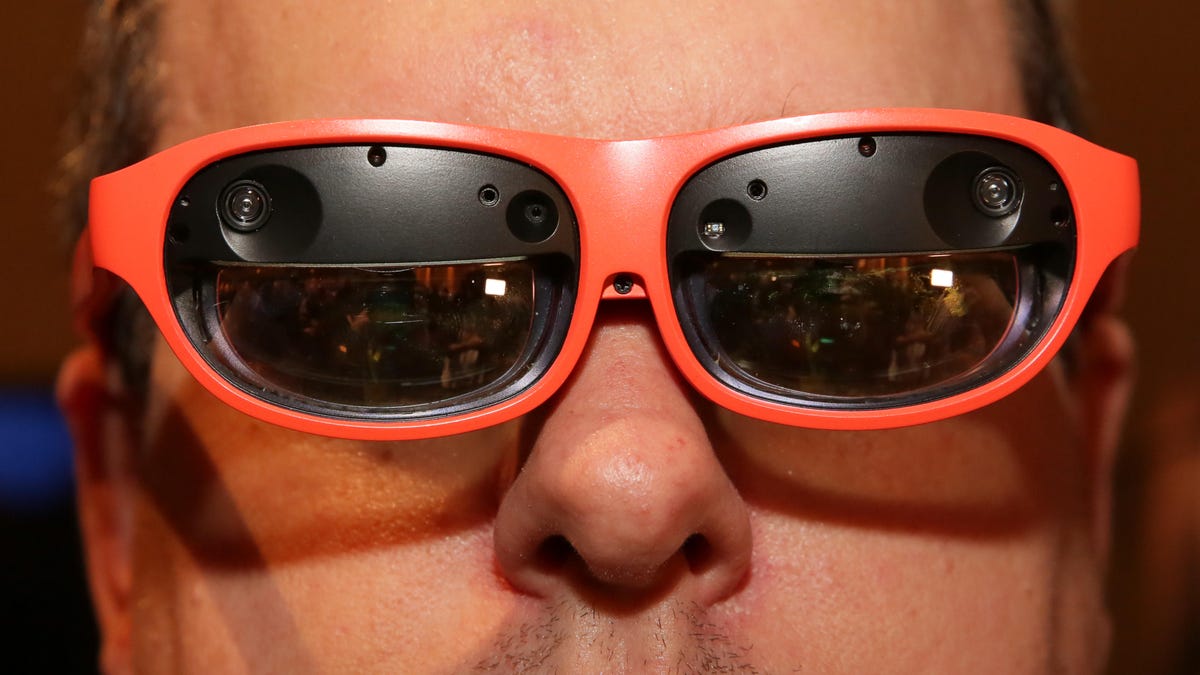

There are other AR devices out there, like the nReal Light. Apple needs to open up iOS to work with them, like fitness trackers and smartwatches.
Sarah Tew/CNET
The post Apple AR, VR Headset Expectations: When Will It Show Up? first appeared on Joggingvideo.com.
]]>The post Lenovo Glasses T1 Are Wearable Displays That Also Work With iPhones first appeared on Joggingvideo.com.
]]>
Apple doesn’t have an AR headset yet, but Lenovo just announced a pair of display glasses that will work with iPhones via a Lightning adapter. The Lenovo Glasses T1, one of a handful of computer products announced Thursday by Lenovo at Berlin’s IFA tech show, aren’t AR-enabled. But they could be a second display for your computer or phone.
Wired display-enabled glasses that work as head-worn monitors have existed for years, notably TCL’s NXTWear G glasses (which are getting a wireless upgrade). Lenovo has made a number of VR and AR devices over the last decade, including last year’s ThinkReality A3, a lightweight pair of AR glasses using Qualcomm’s technology.
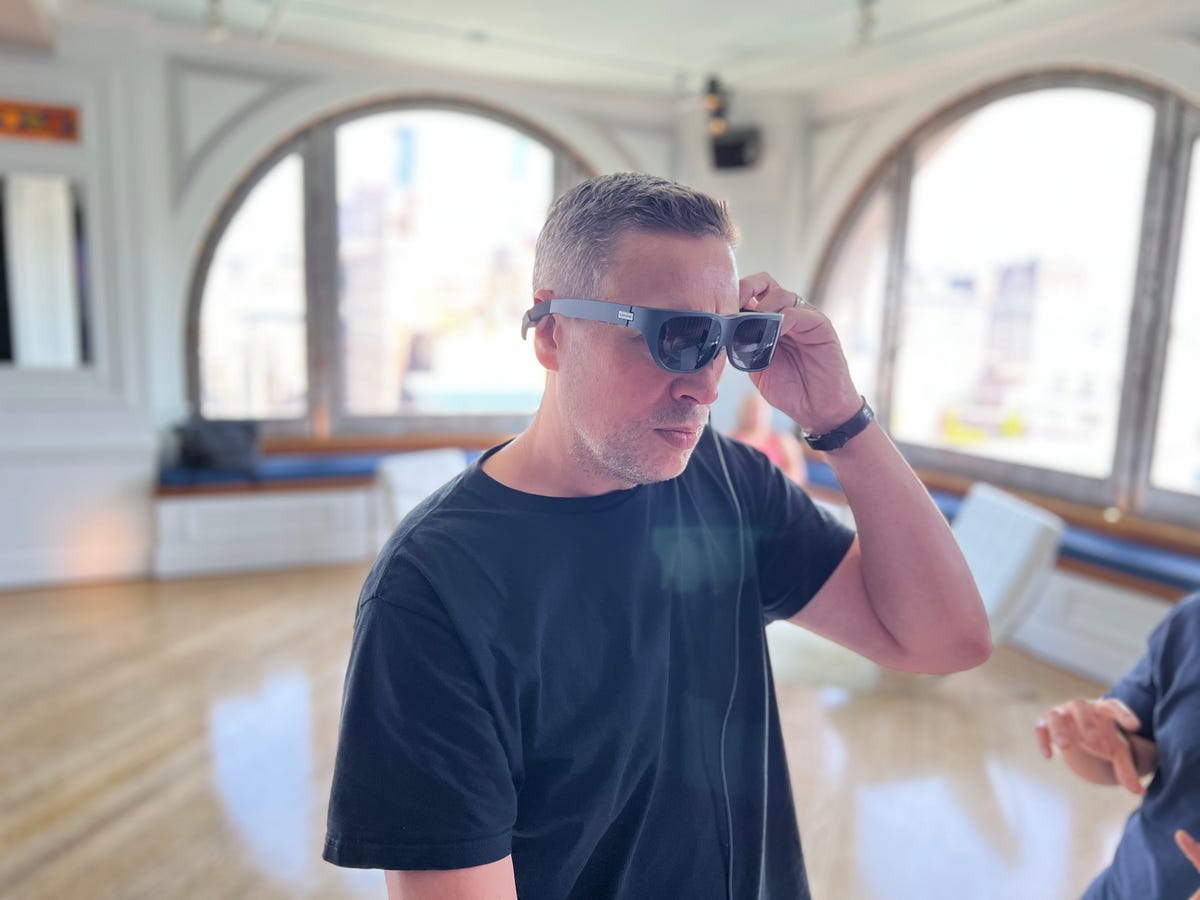

CNET’s Josh Goldman testing the glasses in New York.
Lori Grunin/CNET
The Glasses T1 are USB-C connected, and should work with a wide range of Windows, Mac and Android devices. The interesting part is the Lightning adapter, which also should make them work with iPhones.
The glasses have high-contrast Micro-OLED displays with 1,920×1,080-pixel resolution per eye and built-in speakers, and have TUV Low Blue Light certification. Much like Lenovo’s ThinkReality glasses, there’s a set of adjustable nose bridges, and options for custom prescription lens inserts (although I’ve still not been successful finding smart glasses that fit my severe nearsightedness).
The glasses have no listed price yet, but they’ll go on sale in China later this year, and be available in other regions sometime in 2023. By then, Apple may finally be readying its own AR headset at last.
The post Lenovo Glasses T1 Are Wearable Displays That Also Work With iPhones first appeared on Joggingvideo.com.
]]>